






04 Tours Adventures in brick
06 Street View Ukrainian style
NEWS
08 Brown | Mental Health Ammie Kae Brooks, LCSW
12 Surveillance The FBI monitored Chicago activists.

14 Ehlers | Police The misuse of SWAT teams

15 Allen | Intro Our Food & Drink special issue for 2023
16 Sula | Soba Mariko Kallister brings handmade Japanese soba noodles to Chicago.

uses augmented reality.
30 Isaacs | Groceries Why you’re getting sticker shock at the store

44 Onstage Hatefuck complicates the “radical binary” of SWANA stories.



54 Chicagoans of Note Molly Compton of Ur Mom Records
31 Cocktails to go Pour Souls Cocktail Counter
32 Dining TXA TXA Club is full of romance.
34 Galil | Jim’s Grill The beloved restaurant is no more, but the 90s memories remain for local musicians.
40 Visual Arts David Wright’s comic finds a new life in Lance Hallam
42 Kay Hoffman The sculptor’s long and storied career

46 Festival APIDA Arts Festival celebrates culture across the Asian continent.
48 Plays of Note Reviews of plays including The Language Archive, Panther Women: An Army for the Liberation, and Trade Federation

56 The Secret History of Chicago Music Soul vocal group the Independents
60 Shows and Records of Note

Previews of concerts by defprez, OK Cool, the HIRS Collective, and others, plus reviews of new releases by Helen Money & Will Thomas, Whitney Houston, and Dave Lombardo
66 Early Warnings Newly announced concerts
66 Gossip Wolf Talk of the town
67 Comics
70 Savage Love Dan Savage offers advice to fake letter writers.
22 Prout | Fishing Locals go powerline fishing at Montrose Harbor, catching coho salmon.

26 Fritzi’s Deli Paul Stern and his exemplary Ashkenazi Jewish deli in Oak Park
28 Le Petit Chef Fairmount Chicago’s new culinary experience
50 Movies of Note Alam is a brilliantly devastating coming-ofage story; Evil Dead Rise feels like a so-so tribute band.




68 Jobs

WORK, GO TO JEFFMARINI.COM

CEO AND PUBLISHER SOLOMON LIEBERMAN EDITOR IN CHIEF SALEM COLLO-JULIN

PRODUCTION MANAGER KIRK WILLIAMSON
SENIOR GRAPHIC DESIGNER AMBER HUFF THEATER AND DANCE EDITOR KERRY REID MUSIC EDITOR PHILIP MONTORO
CULTURE EDITOR: FILM, MEDIA, FOOD & DRINK TARYN ALLEN CULTURE EDITOR: ART, ARCHITECTURE, BOOKS, LITERARY ARTS KERRY CARDOZA ASSOCIATE EDITOR AND BRANDED CONTENT SPECIALIST JAMIE LUDWIG SENIOR WRITERS LEOR GALIL, DEANNA ISAACS, BEN JORAVSKY, MIKE SULA STAFF WRITERS DEBBIE-MARIE BROWN, KATIE PROUT
LISTINGS COORDINATOR MICCO CAPORALE COPY EDITOR AND DATA ASSOCIATE SKY PATTERSON
VICE PRESIDENT OF OPERATIONS ANN SCHOLHAMER DIRECTOR OF PEOPLE AND CULTURE ALIA GRAHAM
DIRECTOR OF MARKETING VIVIAN GONZALEZ MARKETING PROJECT STRATEGIST SHAWNEE DAY NEWSLETTER ASSOCIATE CHASITY COOPER SOCIAL MEDIA MARKETING ASSOCIATE NIESHA DAVIS
DEVELOPMENT ASSOCIATE MICHAEL THOMPSON TECHNOLOGY MANAGER ARTURO ALVAREZ OFFICE MANAGER AND CIRCULATION DIRECTOR SANDRA KLEIN
DIRECTOR OF CHICAGO INDEPENDENT MEDIA ALLIANCE (CIMA) SAVANNAH HUGUELEY
SENIOR VICE PRESIDENT OF GROWTH AND STRATEGY AMBER NETTLES

VICE PRESIDENT OF SALES AMY MATHENY SALES TEAM VANESSA FLEMING, TIM OGDEN, WILL ROGERS DIGITAL SALES ASSOCIATE AYANA ROLLING MEDIA SALES ASSOCIATE JILLIAN MUELLER
TO CONTACT ANY READER EMPLOYEE, EMAIL: (FIRST INITIAL)(LAST NAME) @CHICAGOREADER.COM ON

ADVERTISING ADS@CHICAGOREADER.COM


CLASSIFIEDS: CLASSIFIEDS.CHICAGOREADER.COM
NATIONAL ADVERTISING VOICE MEDIA GROUP 1-888-278-9866 VMGADVERTISING.COM
JOE LARKIN AND SUE BELAIR
DISTRIBUTION CONCERNS distributionissues@chicagoreader.com 312-392-2970

READER INSTITUTE FOR COMMUNITY JOURNALISM, INC.

CHAIRPERSON EILEEN RHODES
TREASURER REESE MARCUSSON
SECRETARY KIM L. HUNT
DIRECTORS ALISON CUDDY, DANIEL DEVER, MATT DOUBLEDAY, VANESSA FERNANDEZ, TORRENCE GARDNER, ROBERT REITER, CHRISTINA CRAWFORD STEED
READER (ISSN 1096-6919) IS PUBLISHED BIWEEKLY BY THE READER INSTITUTE FOR COMMUNITY JOURNALISM 2930 S. MICHIGAN, SUITE 102 CHICAGO, IL 60616 312-392-2934, CHICAGOREADER.COM
COPYRIGHT © 2023 CHICAGO READER
PERIODICAL POSTAGE PAID AT CHICAGO, IL ALL RIGHTS RESERVED. CHICAGO READER, READER, AND REVERSED R: REGISTERED TRADEMARKS ®


































































































An Instagram account focuses on the everyday details.
By S. NICOLE LANEWill Quam found his love of bricks by accident. While working as an itinerant theater teacher in Chicago, he would travel around the city for work, and as he traveled, he started to notice Chicago’s bricks.
“Before 2016, if you’d have asked me what a brick looks like, I would have said, ‘red,’ and I think that’s how most people would respond, despite the fact that there are so many different colors of brick actually on the buildings around us—we just never look at them,” Quam says.
So, he started looking. And as he looked, he took photos and posted them on Instagram.
“ Today I’ve swapped my phone for a camera, and Brick of Chicago is now my fulltime job,” he says.
Quam offers neighborhood tours with the belief that giving away as much information as possible is essential. “I’m not trying to take the brick secrets to the grave,” he says. His tours go beyond the brick as well. He dives into building details, the history of the architecture, and the stories of the people who lived there. He says, “I also like to find out the interesting things that happened to people who lived in the buildings on my tour, like the Old Town renter who became one of the world’s greatest snail scientists or the Bronzeville resident who performed the same one-man show every Christmas for 70 years.”
Even on his Instagram posts, he will offer
details for his followers, whether that’s teaching the history of an architect or building, explaining “clinkers” (aka deformed bricks), or simply listing the address of the building in the post.
A lthough Quam’s Instagram and tours focus on all sorts of brick, an important and prevalent kind is the Chicago common brick which became popular after the Great Chicago Fire of 1871.

“It was a wood city until it burned, and then we rebuilt with brick,” Quam says. He explained that brickmaking technology was at its peak when brickmakers were able to make thousands of bricks in an hour with machines and at a low cost ($5 to $10 per thousand bricks).
Blue clay deposits from the last Illinois glaciers along Lake Michigan were used to make Chicago common brick. This characteristic is what gives the brick its particular color—a variety of hues like yellow, salmon, and deep red that appear after they are fired in a kiln for 60 hours at over 1,500 degrees.
These bricks, at the time, weren’t considered pristine by architects, who didn’t like their color or irregularity, so they were positioned on the backs or sides of buildings, which are commonly seen around the city.
Chicago commons built the city, brick by brick, and still make up our alleyways, backs of buildings, and structural walls. If you look directly at a building, it may be a dark red or uniform brown, but once you circle to the side, you can notice an irregular brick. These are the Chicago commons.
Today, these are prized bricks because they ceased production in 1981, and many buildings using them were demolished. Reclaimed bricks are sold at brickyards like Stockyard Bricks, which specializes in Chicago commons and sources them from Milwaukee, Detroit, Cincinnati, and Saint Louis.
Most former brickyards were closed and filled in once new construction—like steel and concrete blocks—became more popular and cost less. Thunder Mountain in the Montclare neighborhood converted the 285-foot pit used for digging up clay into a ski resort in 1968.
Nowadays, there is a brick revival in Chicago, as folks like Quam reignite interest in what was once considered ugly. Folks are rebuilding walls and starting new construction with Chicago commons due to its recyclability and as a way to stay connected to the past. Chicago commons are sexy again—or maybe for the first time ever.
N ot everything about Chicago is about commons, however. From two-flats to workers’ cottages, each individual building in the city has a uniqueness. For some, it’s Indiana limestone or Ironspot brick, while others have basketweave patterns or extravagant terra-cotta sunbursts.
“Chicago is rightfully praised for the architecture of the Loop and Lincoln Park and Hyde Park that was designed by noteworthy architects. But tucked into every neighborhood in Chicago are other gems designed by architects whose names you’ve never heard
For more information on neighborhood tours, visit brickofchicago.com/tours
Ornamental cornices from buildings on Iowa Street WILL QUAM
before. Every building was designed, and every little design on a building was intentionally put there, and I like to find those little details and make them into their own little works of art through pictures,” says Quam.
S ince Bricks of Chicago is Quam’s fulltime job, he must stay organized. With a map on his phone, he keeps track of buildings that he sees while he’s out and about and buildings he sees on Google Street View.
He says, “I know that no matter where I drop in Chicago, I can find good brick.”
I n addition to walking the Chicago streets, Quam spends much of his time researching in libraries and looking through census records.
“ Pullman is full of redbrick rowhouses, Brighton Park is full of rough and glazed brick flats, South Shore is full of colorful brick apartments, Dunning is full of simple light brick cottages, and the West Loop is now full of shiny black brick skyscrapers,” says Quam. “And each of these neighborhoods did their own little spin on architectural styles, fitting into the larger trends but meeting the whims of the original developers, architects, and residents.”
In Milwaukee, you get Cream City brick made from the clay found around the Menomonee River Valley and the western banks of Lake Michigan. In Saint Louis, Missouri, the brick is red from the clay deposit found underneath the Dog Town and the Hill neighborhoods. Ohio produced more red bricks than any other state in the 1800s.
Just like Quam, many of his followers may have known little about brick, and the cities it built, without his popular Instagram page—with 27.3k followers.
H e invites viewers to pay attention to their surroundings in a more microscopic and attentive way. Walking through your neighborhood gets a little more exciting once you look up, or look closer.
W hile our skyscrapers are world-famous—and rightfully so—Chicagoans are surrounded by history that can be found in the everyday brick all around us. It doesn’t have to be the glitz and glam that we associate with impressive architecture. Sometimes, it’s in the rectangular walls of our homes. v
June 1, 2023 · 7 PM METRO/sMARTBAR

Best of Chicago Celebration is back! On June 1 at Metro Chicago, the Chicago Reader is thrilled to host its iconic event of celebrating the Best of Chicago–nominated and voted by YOU.

Learn more below or scan the QR code >>> chicagoreader.com/bocparty

Sponsors

MORE FROM MAYA AND ANASTASIIA Maya Sovyk: instagram.com/mayaonstyle Anastasiia Vdovychenko: instagram.com/nanka_vd

 ISA GIALLORENZO
ISA GIALLORENZO
Two friends show that beauty endures in Ukraine.
By ISA GIALLORENZOThe breezy evening of Thursday, April 27, was made for fashion. The golden hour that day provided the perfect glow for a select group of local fashionistas and their sequins to shine.

Gathered in the airy cocktail bar at Bambola, a charming Fulton Market restaurant with modern Istanbul vibes, the fashion crowd were there to celebrate the first “The Curio x Bonhomme Hospitality’s Fashion Industry Social Hour” series. “[This event]
serves our goal of bringing together individuals from all aspects of the Chicago fashion community to connect, collaborate, and have some fun,” said Ian Gerard, 55, the cofounder and CEO of the Chicago organization the Curio, which organizes events to network and celebrate local fashion talent. Gerard added, “‘A Celebration of Chicago Style’ is our next event on May 31, and it will showcase eight Chicago-based apparel and accessory designers at 21c Museum Hotel.”
Accurately following the event’s “spring best to impress” dress code, friends Maya Sovyk, 31, and Anastasiia Vdovychenko, 32, sported a mix of colors, textures, and styles that served a feast to the eyes. “My outfit reflects a playful mood. I really like to reflect my mood with the help of clothes,” said Sovyk, a wardrobe stylist who used to own a boutique in her native Ukraine. “I believe that an outfit should help a person display their inner world. It is also very important
that it would favorably emphasize their figure, fit their lifestyle, and correspond to their preferences. I adhere to all these principles when choosing outfits for my clients,” she explained.
“I always ask Maya how to combine clothes because I prefer matching different
textures and looks and she knows this method very well. I like this outfit—I feel comfortable, feminine, and bright,” said Vdovychenko, who enjoys mixing affordable and luxury brands. Her purple jacket, for example, is from ASOS Design’s menswear line, her shoes are from Boohoo, her bag is from Fendi, and her watch is by Cartier. A Ukrainian immigrant as well, Vdovychenko is a fashion influencer and a beauty entrepreneur. She created BROWI, a hypoallergenic eyebrow cream specifically made for people who have permanent makeup. The cream was formulated with SPF 40 and also includes a growth-enhancing solution.
Sovyk and Vdovychenko agree that Ukrai-
nians are a stylish bunch. “The fashion industry had been developing fast in Ukraine before the war. Ukrainians like clothing, and we can see this throughout our history,” said Vdovychenko, who considers the capital city of Kyiv, Lviv, a city in western Ukraine near Poland, and the port city of Odesa the most fashionable in her home country.
“We have a lot of fashion brands of clothes and accessories of high quality and at reasonable prices. Anastasiia and I even thought of opening a showroom of Ukrainian brands in Chicago,” said Sovyk.

She shared a long but not exhaustive list of her favorites from the region: Bevza (contemporary womenswear), Bazhane BTQ (leather jackets and vintage fur coats), Etnodim (the brand of the embroidered shirt President Zelenskyi often wears), Wonder-Gallery (high-quality womenswear), Bagllet (stylish bags), Lovandbag (high-quality leather bags), and Kachorovska (bags and shoes). Vdovychenko also recommended Studio 27 (shoes), Two Hearts (womenswear), and Coosh (contemporary womenswear).


Both friends feel heartbroken about the war being waged by Russia in their native country. Sovyk and her family moved to Chicago last October to flee the conflict. “I feel very terrible about what is happening in my country. I still can’t imagine how it is possible in the 21st century to kill innocent children and people indiscriminately. In my opinion, this is no longer a war, but a genocide of the Ukrainian people by Russia,” said Sovyk.
“There is not a single day that we do not cry. But personally, I try to transform my anger and hatred of the enemy into donating to the Armed Forces of Ukraine. I am grateful to the Armed Forces of Ukraine for the fact that my parents are still alive, and that Ukraine still exists. They do the impossible. [But] we can only defeat Russia together. The whole civilized world against the terrorist state,” she added. “I hope the war in Ukraine will end soon. Thank you to the citizens of the U.S. for the huge support,” said Vdovychenko. v
@chicagolooks
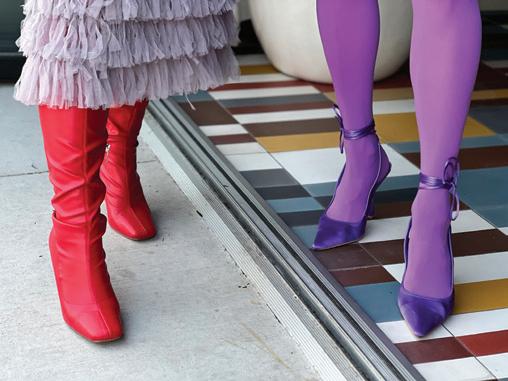
fresh tone for what intergenerational therapeutic healing can look like for Black communities locally.
 By DEBBIE-MARIE BROWN
By DEBBIE-MARIE BROWN
Being a licensed clinical social worker (LCSW) in Chicago means that you are allowed to open a private practice and bill insurance for your clients’ sessions. It also means that you have attained your master’s degree in social work, completed 3000 hours of clinical work under a licensed supervisor (including unpaid but graded hours of administering therapy, teaching, training, researching, doing assessments, and more), and also passed the Illinois state licensing exam. It’s a lot.
The majority of LCSWs attain that status later in their professional careers because of the financial barriers posed by each neces-
sary step. And there are accessibility issues for some as well, in that most standardized testing methods by nature fail to meet the needs of di erent types of learners. Some fail the exam dozens of times, and each time you fail, you have to pay at least $250 to retake it before waiting several months to reschedule.
“The [licensing] exam costs so much money. Doing your supervision costs so much money because you have to pay to get supervised,” says LCSW Ammie Kae Brooks. Supervision can cost anywhere from $200 to $600 per month, “but if you want a good supervisor, you’re gonna pay for them,” Brooks adds. “I did the thing, and I worked tirelessly through
the pandemic. But I think it’s just uncommon, because there are so many barriers.”
Brooks, 28, has long, jet-black hair and dark, smooth skin to match. She resembles a live-action version of the character Isabella from the 2021 Disney animated film Encanto (which happens to be one of Brooks’s favorite films).
In March, she founded granddaughters, a Chicago-based private practice which centers the healing of Black girls, women, their families, and their communities. Brooks, raised in Texas, was inspired by her own healing journey. Equipped with her love for children, her year-old license, and her expertise in building nonprofit programs, she intends on setting a
A scroll through granddaughters’ Instagram reveals old and new pop culture imagery and TikTok videos of Black kids and their grandparents in intimate moments of joy or sadness. The posts shared by the granddaughters account are a synopsis of Brooks’s passion and approach to therapeutic healing. A photo of SZA and her grandmother that was posted in March is paired with a caption quoting the matriarch’s narration throughout the pop star’s debut album, singling out the words heard on the song “Garden (Say It Like Dat)”. (“If you don’t like me, you don’t have to fool with me / but you don’t have to talk about me or treat me mean / I don’t have to treat you mean.”) A post from later in March shows the animated character Little Bill and his grandma embracing, paired with a caption about how, contrary to how Brooks hears people discussing healing and mental health as a new 21st-century concept, Brooks knows that her ancestors knew inescapable and unimaginable fear and sadness and pain, but still continued to heal themselves.
“For a long time, I had seen my history as a burden, as a weight that I had to carry. And so being able to see my ancestry as a strength and something that could heal the parts of me that were hurting was so valuable to me,” says Brooks, who is named after her paternal grandmother, Ammie, and her maternal grandmother, Kay. “I wanted that to be reflected in my private practice. And I want my practice to be centered around healing all of the Black woman’s descendants.”
At granddaughters, Brooks primarily works with Black children and families experiencing the impact of complex post-traumatic stress disorder, which is often derived from trauma that exists in various generations within a family. In response to this, as a therapist, Brooks works to adapt play and movement, music, art, and technology to engage parent and child, and to help the entire family manage the challenges associated with a mental health diagnosis.
“I’ll encourage my kids to maybe learn a Tik-
Tok dance with their parents,” she says. “Or I will encourage a lot of my parents to do things with their children, give them a manicure, because that really encourages a lot of touch, which is promoting a healthy attachment, or rebuilding a healthy attachment where there has been an insecure one in the past.”
In youth of color, particularly girls, complex trauma systems can show up as people-pleasing or perfectionism. “We would have these youth who are excelling in school and are flying under the radar, because they’re seen as really great kids to sta ,” Brooks says, reflecting on her experiences working as a clinical therapist at other companies, nonprofits, and practices. “And as they get older, they aren’t able to manage the symptoms of their mental health, because they haven’t been acknowledged by practitioners.” She also noticed, in her experience working other places, that there can be financial incentives to diagnosing quickly, but it’s often more productive for treatment if she slows down and takes her time.
Brooks has a specialization in sexualized behaviors. This informs her work with survivors of gender-based violence, which includes people with a history of sexual abuse, sexual assault, or long-term sexual abuse in childhood. The specialization also enables her to help both children and parents with communication in cases where a youth has recently identified as a specific sexuality or gender. In Brooks’s practice, she routinely works with people experiencing complex traumas, with people who may demonstrate sexualized behaviors, and with many people who are BIPOC and/or queer.
“I think that there is a lot more possibility here for me to be creative. And for me to support youth who are queer and who are struggling. In Texas, it’s really, really hard to do those things. I think that the conservatism in Texas has really hurt me personally. I’ve had experiences interpersonally with racism and misogyny. Here I’m able to see the fruit of it in a much better, clearer way than in Texas where I think that for clinicians, it’s a much slower process.”
Brooks started undergrad in Texas in 2013 expecting to pursue education, but by her
sophomore spring, an introduction to social work class left her enamored with the idea of “meeting people where they’re at in any situation and attacking systems that oppress and harm them,” she says, and she desired to be part of that work.
Taylor Crumpton is a widely-published freelance journalist and a friend of Brooks who met her on student orientation day the summer going into their freshman year at Abilene Christian University. Eventually they would also find camaraderie in each other as Black women at Abilene’s School of Social Work. “[Ammie] was beloved by all on campus, because she always had a welcome, open, honest approach and aura to her,” Crumpton says. She describes Brooks as someone with a natural maternal instinct who was approachable and, therefore, often approached.
“It can be as simple as—you’re having a rough day, you’re needing a hug,” Crumpton continues. “She just had this way about her and still to this day, of just, ‘Whatever I can do for you in that moment, I’m going to show up for you and be that for you.’”
In addition to providing individual, partner, and family therapy, Brooks’s practice also offers nonprofit consulting and promotes community engagement through mental health workshops, awareness campaigns, and educational programs that get “people of all di erent generations healing together.” This summer she’s organizing programming for parents and children to protect youth’s mental health on social media. But the capacity she has to create through this leg of her practice is best understood when you know Brooks’s professional background working in the nonprofit world and with kids.
The industrious therapist got her master’s in social work in 2018 with an additional certificate in nonprofit administration. She’s held positions as a therapist, supervisor, and eventually clinical director in child welfare and violence prevention organizations. Shortly after college, her first job was working with women on the perinatal spectrum who were considering what they were going to do with their pregnancies, and providing postabortive counseling for people who sought therapy
after an abortion.
Brooks was hired at that position in part because of her experiences in grad school building programs for nonprofit organizations. That job eventually tasked Brooks with developing the clinical part of their organization. Later in Chicago, as a clinical director at Kids Above All, she supervised clinicians twice her age as well as graduate interns, saw her own clients, and advocated for clients in interprofessional spaces and courtrooms. All the while, she managed grants and their budgets, and kept files in compliance with business standards for Kids Above All. Brooks also received a $3 million dollar federal grant to expand clinical services at the organization, with her at the helm of decision-making regarding how best to use the funds and provide programming.
Brooks tells the Reader that she believes her age and culturally adaptive approaches to therapy brought nuance to the team. A training she developed, called “Technological Integrations for Clinical Therapy,” helps clinicians engage in virtual therapy more e ectively. Dr. Heather Ferguson-Tillman, a social worker of 35 years, agrees. Ferguson-Tillman, who was supervised by Brooks at Kids Above All, says that when Brooks became clinical director at their agency, the young clinician introduced a new approach to family outreach that looked more organic, less coercive, and empowered clients to feel they were partners with clinicians in their recovery.
Brooks encouraged Ferguson-Tillman and others to try to get clients laughing, or to use art supplies and movement when practitioners felt burnt out and at the end of their rope with solutions. In one particularly difficult case, Brooks encouraged Ferguson-Tillman to take her client to a Golden Corral restaurant for an experiential therapy program Kids Above All was trying out.
Ferguson-Tillman was unfamiliar with the approach and cautious to attempt it. She was worried about client confidentiality and more, but she returned singing Brooks’s praises. Ferguson-Tillman says that having a session occur in a nontraditional setting like dinner out or at Sunday brunch after church can be a
good way to have a family session because it’s therapeutic but doesn’t look intrusive. “[Families] are able to get a lot of things out that they probably wouldn’t in a restrictive setting,” Ferguson-Tillman says.
“And I had just had so many interactions like that, where it was like, ‘This is a case where this client is in critical need,’” Brooks says about that experience. “The ‘We’re going to have to place them in a treatment facility or hospital’ [cases], and I would do anything I could [to avoid that]. I know that research says that children and people in general do not heal in institutions. We heal best in our communities and our homes. And so if we can do anything to take kids out of a hospital or institution, I will . . . it just takes a little creativity.”
Brooks has loved kids for her entire life. She grew up working at a summer camp with kids, as well as at Vacation Bible School at her church on top of babysitting for pay in her free time. In her college town, she pioneered a new Boys & Girls Club chapter, and she ran the after-school program as associate director of that location. When Brooks first moved to Chicago, she started a free meal program in Harvey, located at Harvey Church of Christ. Regardless of where she’s worked, she made sure statements disclosed about abuse or suicidal ideation were taken seriously.
At every job Brooks has worked, there were certain procedures or processes that she told herself she would not replicate should she build her own practice. This includes turning away people because of their lack of ability to pay who are clearly in desperate need of services, and policing Blackness or motherhood within therapy sessions. “But then there were also things that took place that made me feel like ‘your practice or mine?’” she tells the Reader, “I cannot do that.” In her practice, she centers Black girls, women, their families, and communities at the most basic level.
“I don’t judge my clients when they show up in session in their bonnet, or sitting in their bed, or in their pajamas, or with their hair not done. If they’re taking down their braids, we do therapy, [even] if they have half of their hair done and the other half not done yet,” Brooks says. “I genuinely don’t punish or persecute my
The Reader’s weekly chef pop-up series at Ludlow Liquors.
Follow the chefs, @chicago_reader, and @mikesula on Instagram for weekly menu drops, ordering info, updates, and the stories behind Chicago’s most exciting foodlums.
May 8: Puerto Rican jibaritos and munchies with Moncho Moncheo @monchomoncheo
May 15: Celebrating four years of Mom’s @momschicago
May 22: School Pizza Night with Chopped alum
Crust Fund Pizza @nachosandlager
May 29: Memorial Day bye week
June 5: The return of Tasting India and friends @tasting_india
June 12: Roman-style, wood-fired pizza from Bad Johnny’s @badjohnnysgoodtimes
June 19: Tripping Billy’s greatest hits @therealbillyz
June 26: Central Texican barbecue with Heffer BBQ @therealhefferbbq Head to chicagoreader.com/section/food-drink/monday-night-foodball/ for weekly menus and ordering info.
continued from p. 9
clients for being late. I don’t charge late fees.”
She has Black women—their stories and narratives—represented as often as possible in her practice, and uses treatment centered around them. She spends a lot of time studying African methodology and spirituality, inquiring how our ancestors healed themselves during slavery, post slavery, and throughout the African diaspora.
Brooks develops her own parables to help therapists and clients understand various therapeutic concepts. When she’s training other therapists, one model she uses involves seeing one’s role as therapist on a spectrum between “police o cer” and “pastor.”
“There is a lot of encouragement and empowerment that needs to happen. And there is a degree of information gathering that needs to happen. But I think that sometimes as therapists we kind of shift out of what’s therapeutic,” Brooks says. “To help describe this to the therapists that I train, I will draw a line and put therapists in the middle. And I will let them know that this is a spectrum. And on one end of the spectrum, I’ll write ‘detective’ or ‘police o cer.’ And on the other end of the spectrum, I’ll write, like, ‘preacher’ or ‘pastor.’ And I will let them know that as therapists, we want to fall in the middle.”
On one hand, therapists aren’t supposed to convert clients into what the therapist thinks the client needs to be—they need to meet them where they are. A therapist also needs to gather facts to better understand the client, but they shouldn’t come off so investigative that it feels like an interrogation.
Brooks uses another metaphor. She compares our traumatic experiences to a fire, and says our trauma responses show up for us like firefighters.
“But I also have a parable about learning to ride a bike, and how therapy is like learning to ride a bike because the client gets to steer the bike and determine where we go. And the client gets to pedal the bike and determine how fast or slow we go. And as the therapist, I will just be there to hold you up. And it’s this really beautiful metaphor about how like one day they will let go. And they won’t know that they’re riding the bike all by themselves. And we won’t leave, we’re still here, we’re still watching. But instead of holding you up, it’s
now us in the background being like, ‘yay.’”
In her personal sessions, she always has her clients complete a 90-day art project that could range from a diorama of what safety looks like for a client (one person made a terrarium because they feel at home in nature), to a photography project of what their sadness looks like, or a painted picture where a client slowly depicts their own anxiety or sadness. The inspiration for this, for Brooks, came from the fact that a lot of her own personal healing would take place between sessions with her therapist, and she wanted a physical representation to connect that reality to her client, in a way they’re comfortable and familiar with.
In September 2020, Brooks spoke with the group To Write Love on Her Arms for their National Suicide Prevention Day programming about how she works as a Black clinician to prevent suicide, and how others can do so too. On April 25 this year, Brooks sat on a panel for the Beauty Turner Academy of Oral History at the National Public Housing Museum, hosted by the renowned Dr. Eve Ewing, about how oral history and telling stories can be a vehicle for healing.
What does the young professional have in store for her future? Her goal is to raise money by connecting with grants and private donors so that she can make therapy absolutely free for children in Chicago. She’s worked at various nonprofits and programs that allow kids to access therapeutic services if their parents’ income falls below a certain threshold, if they live in a certain neighborhood, or they’re dealing with a specific issue, but those prerequisites are barriers for children to receive treatment. She believes no child should be denied therapy simply because it isn’t financially viable to the family.
“But I don’t expect them to see the value in something that they haven’t been able to experience yet, or oftentimes not in a dignified way. I want to put the treatment in their communities and their neighborhoods, knock out all barriers to it completely. And say, ‘Hey, just show up. There’s no limit to how many sessions you can receive. It doesn’t matter how much money you make.’ That’s my goal . . . getting people of all di erent generations healing together.” v @debbiemarieb_
Take me to a waters edge, and let me loose
Let me learn
Let me leave
Life is for the living
The body has a right to move
We begin before the shoreline
Where trees touch skylines
Where songs are held in the leaves
And bushes, and roots, berries and Gold dust. Dead skin. Scar tissue
We begin before an arrival
Before the wet logged driftwood
Appears on the beach like lazy trash
Maybe an island moves toward us
Maybe the ocean is sending soldiers
We begin with the rumors when ears
Do dances to songs they don’t like
The heart beats so hard the ribs quake
I question if I have been put together
With a water based glue, I live in the clouds
We begin when the flames are yelling
The iron pot was full a second ago and now
Poof, scaring on my back, chains on my feet
My father is beaten, my sibling is gone. She/Her. Our mother won’t relent. I am reminded of her face
And it reminded me that the sea is too deep
Maybe all three Of us are destined toward a door that stays open
By C.Lofty BollingSometimes I dream, while on the way to work, where I crack my neck after a nap and it breaks. I fall to the floor like popsicle sticks and wet glue. Everyone is surprised, some disgusted, a few exclaim of the lord and biblical nomenclatures that rings inside four walls of a train, I wake up and I’m off the green line by 3:20pm
C.Lofty Bolling (they/them) is a black, queer, southern poet who has recently relocated to Chicago in 2021 and have been writing poetry regularly since middle school, self publishing since their senior year of high school. Through their poetry they explore notions of identity formations, the quantum imagination, history, ontology and voodoo practices.
Poem curated by Chima “Naira” Ikoro. Naira is an interdisciplinary writer from the South Side of Chicago. She is a Columbia College Chicago alum, a teaching artist at Young Chicago Authors, and South Side Weekly’s Community Builder. Alongside her friends, Naira co-founded Blck Rising, a mutual aid abolitionist collective created in direct response to the ongoing pandemic and 2020 uprisings.
A biweekly series curated by the Chicago Reader and sponsored by the Poetry Foundation.


Free Programming from the Poetry Foundation!





Hours
Wednesday, Friday, and Saturday: 11:00 AM–4:00 PM
Thursday: 11:00 AM–7:00 PM
Performances of No Blue Memories: The Life of Gwendolyn Brooks
Written by Chicago poets Eve L. Ewing and Nate Marshall, No Blue Memories is a uniquely staged retelling of Brooks’s life using simple, illuminative paper-cut puppetry by Manual Cinema set to music composed by Jamila Woods and Ayanna Woods.
Tuesday, May 16 and Thursday, May 18, 6PM, Harold Washington Library

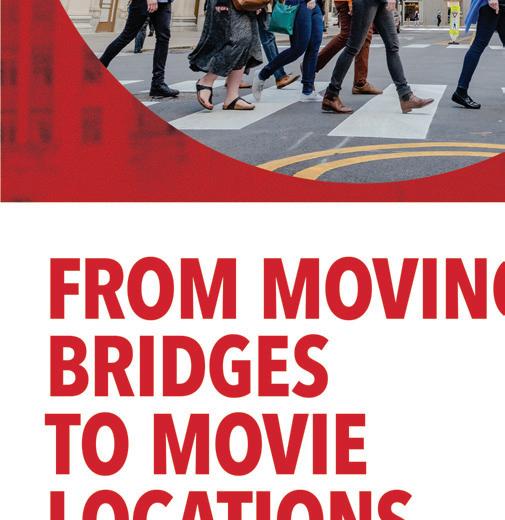

Learn more at PoetryFoundation.org

SURVEILLANCE
This article was originally published by Grist and was produced in partnership with the nonprofit newsroom Type Investigations, where Adam Federman is a reporting fellow.
Last summer, a “Chicago Against Cop City” Twitter account was created and began sharing information about a campaign unfolding some 700 miles away. Its first tweet, posted on July 18, promoted a talk at a community bookstore in Pilsen featuring activists involved in the ongoing effort to protect a public park and forest in Atlanta. The speaking event—one of several the activists conducted across the country that year—was designed to raise awareness about the planned conversion of 85 acres of urban forest into a police training center that activists have dubbed Cop City. It took less than two weeks for the FBI to
flag the account, which was the focal point of a sprawling federal inquiry that collected information on several Chicago-based activist and community groups. Those groups appear to have done little more than promote or attend events a liated with the Atlanta-area activists. According to 28 pages of FBI records obtained through a Freedom of Information Act request, the Chicago case file is part of a larger federal law enforcement assessment related to “anarchist extremism” and domestic terrorism.
The documents describe members of the Atlanta group as “Anarchist Violent Extremists” and “Environmental Violent Extremists” who are “opposed to removal of trees and park land.” These activists traveled to Chicago, the FBI states, to meet with “like minded individuals” and “provide training.” There is little evi-

dence in the unredacted portion of the files or the public record to support the latter claim.
Promotional material for one of the events says it featured “action steps” to help participants find their “role in the struggle.” But one of the activists who traveled to Chicago—and who asked that their name not be used given the possibility of an ongoing FBI investigation—said the events were “informational slideshow presentations” that did not involve any kind of training.
“At no point in the presentations did we advocate for illegal activity,” they said. “And we certainly are not advocating violence.”
Grist and Type Investigations published the full documents, which were redacted by the FBI before release, at two Document Clouds accessible through Grist’s website. The contents of the files were first reported by Unicorn
Riot, a nonprofit media organization.
Assessments are a relatively new category of FBI investigation, established under guidelines issued by the agency in 2008, that can be opened with little cause and allow for physical surveillance, database searches, and the use of informants to gather intelligence.
Since the FBI opened its file on Chicago Against Cop City, more than three dozen activists involved in the Atlanta protests and forest defense have been arrested and charged with felonies under Georgia’s 2017 domestic terrorism law. On January 18, a law enforcement officer shot and killed 26-year-old Manuel Esteban Paez Terán, a community medic who had been an active member of the campaign, during a raid on an encampment in the forest. Autopsy results recently released by the family revealed that Tortuigita, as Terán was known, was likely sitting on the ground with both arms raised when they were shot at least 13 times. In public statements, the Georgia Bureau of Investigation maintains that Terán shot a state trooper first. However, the bureau has released only limited information, citing the ongoing investigation. Another autopsy carried out by the DeKalb County Medical Examiner’s O ce has not been made public.
A Grist analysis of 20 of the early arrest warrants found that none of those charged with domestic terrorism were accused of seriously injuring anyone. Nine of the activists had simply been cited for misdemeanor trespassing, though the Georgia Bureau of Investigation has said that criminal inquiries are ongoing. The terrorism charges, according to the DeKalb County prosecutor, were based on a Department of Homeland Security designation of the Atlanta forest defenders as “Domestic Violent Extremists.” But Homeland Security, like the FBI, denies that it classifies specific groups in this way.
Mike German, a former FBI special agent and a fellow with the Brennan Center for Justice’s Liberty and National Security Program, said that while there’s nothing in the newly released FBI files to indicate that they’ve been shared with Georgia state authorities, the labeling of an entire group as violent extremists
can shape the way law enforcement approaches social movements.
“This exact kind of loose language may lead to the mistaken assumption that that categorization has some legal e ect,” German said.
The FBI, which has a long history of targeting environmental activists, has been actively involved in the law enforcement response to the Atlanta forest defenders. According to a Georgia Bureau of Investigation press release, the FBI has been part of a joint task force intended to “eliminate the future Atlanta Public Safety Training Center of criminal activity.”
In an April 2022 email, the Homeland Security Officer for the Atlanta Fire Department referred to FBI involvement in an “ongoing investigation” and described the activists as a group of “eco terrorists.”
The heavily redacted records on Chicago Against Cop City include social media posts by a broad range of social justice and environmental organizations. Rising Tide Chicago, a group called Save Jackson Park, the South Shore Nature Sanctuary, and Pilsen Community Books, a popular gathering place for local activists and the host of one of the events, are all named in the files. In one instance, the FBI refers to the use of a source with “direct and indirect access” to activists using the bookstore as a meeting place.
The records also highlight opposition to the construction of the Obama presidential library and the proposed expansion of a nearby golf course that would potentially require the removal of more than 2,000 trees. Save Jackson Park and the South Shore Nature Sanctuary have both campaigned to block the new golf course, which they say would destroy some of the only green space left on Chicago’s south side. The FBI concluded that the development projects in Chicago, along with the building of a police training center on the west side, were “similar” to the Atlanta construction project and could lead to “potential criminal activity.”
The FBI’s Chicago office declined to comment for this story.
A spokesperson for Rising Tide Chicago said that the bookstore event and a teach-in at Hyde Park three days later were intended

simply to educate people about what was happening in Atlanta. “It was a speaking tour,” they said. “It wasn’t a direct-action training. The focus was about their struggle with Cop City.”
The spokesperson said that they don’t know who is behind the Chicago Against Cop City Twitter account, and that it doesn’t appear to be a formal group with an on-theground presence. It mostly has served as a platform for sharing information about how people can support the movement in Atlanta from afar, they said. (Chicago Against Cop City did not respond to a direct message requesting comment.)
Jeanette Hoyt, a 65-year-old teacher at City Colleges of Chicago, is the founder of Save Jackson Park. She launched the group in 2020 to oppose the cutting down of nearly 400 trees and the destruction of parkland, including a beloved women’s garden, to make way for the Obama Presidential Center, which is still under construction. (According to the center’s website, the women’s garden will be “restored.”) One of Save Jackson Park’s social media posts was retweeted by Chicago Against Cop City—and that was enough to land the group in the FBI fi le.
“The only connection between this group and Cop City is them liking me on Twitter,” said Hoyt.
The Rising Tide spokesperson is not surprised the FBI is keeping tabs on the group—it was formed in 2011 and has been named in other FBI investigations—but said it’s troubling that the agency would put together a dossier on organizations engaging in what are clearly constitutionally protected activities, such as attending public events and campaigning to stop controversial development projects.
“They are building evidence,” the Rising Tide spokesperson said. “And compiling social media posts for a narrative that they want to attach to the movement in Atlanta, and attach to people who are concerned about green spaces being taken away in Chicago and I’m sure other cities, too.”
German, who reviewed the documents,
said the agency made several misleading connections between the various activist groups without providing evidence to back up serious claims of potential criminal activity and violent extremism among the Chicago groups. While participants in some of the Atlanta-area protests have thrown rocks, broken windows, and burned a police car, nobody connected with any of the Chicago groups or campaigns appears to have engaged in similar tactics. In addition, the police training academy in Chicago did not require the clearing of forested land and, despite local opposition, has already opened.
“Making this casual reference to an unrelated group a thousand miles away is how the FBI gets itself in trouble,” said German, referring to a pattern of FBI overreach in targeting environmental groups. “I think the animus against the ideology is what’s most problematic.”
The law enforcement response to the campaign in Atlanta has, at least for now,
galvanized interest in the protest movement. Following the shooting of Terán, there were marches and vigils across the country and around the world. Affinity groups have sprung up in Tucson, Arizona; Minneapolis; and Pittsburgh. Meanwhile, a growing number of environmental and human rights organizations have called on Georgia prosecutors to drop the domestic terrorism charges.
An Atlanta resident and active participant in the campaign who has been involved in other speaking tours—but requested anonymity due to ongoing police activity—said that the crackdown on the forest defenders has only served to broaden the movement’s public appeal.
“The characterization of people as domestic terrorists—it’s really outraged a lot of people,” they said. “Lots of people are scared by that, but also more and more people are moved by the struggle and called to participate in it.” v @adamfederman
Policing in America has become dangerously militarized. This past February, the police were called to the north side where a man had shot two dogs. The police rolled into the neighborhood on an armored personnel carrier in full tactical gear with shields and rifles.
I was stunned at how disproportionate their response was. It reminded me of news clips of the U.S. military moving through Iraq. In autocracies like Russia and China, policing is usually a form of state control of the population, and force is considered an appropriate tool. I couldn’t believe this was happening right in the heart of Chicago.
In terms of the equipment, the militarization of American policing has occurred as a direct result of a federal program called “1033” after the law that created it. The 1033 program uses equipment transfers and funding to encourage aggressive enforcement of the War on Drugs by state and local police forces, and there are few limitations or requirements imposed on agencies that participate in it.
The equipment transferred under the program is free to the police departments. The caveat is that they must use the equipment within one year. There can be no doubt that participation in this program creates an incentive for law enforcement agencies to use military equipment on its own citizens. They are
required to use it, or they must give it back.
Perhaps that is why we saw a full Special Weapons and Tactics (SWAT) team roll up in an armored personnel carrier for a dog shooting.
We are constantly bombarded by the imagery of war. The aggressive funding of the enforcement of U.S. drug laws creates an overhyped fear of siege within our borders, which the federal government is encouraging by pushing local law enforcement agencies to militarize.
The ACLU found that excessive militarism in policing, particularly through the use of paramilitary policing teams, escalates the risk of violence, threatens individual liberties, and unfairly impacts Black and Brown people. Additionally they found that “the use of unnecessarily aggressive techniques has a documented impact on public confidence in law enforcement.” There is a reason to be concerned that excessive militarization undermines public trust and community safety.
One of the biggest leaps police departments made toward militarization is the use of SWAT teams to conduct ordinary law enforcement activities. SWAT teams were created to deal with serious situations like hostage scenarios and snipers. SWAT teams are now used increasingly for purposes they were not originally intended for—mostly to serve search
warrants for drug investigations.
A 2008 study by David Klinger and Jeff Rojek, both at the department of criminology and criminal justice at the University of Missouri-Saint Louis, found that the overwhelming number of SWAT deployments were for the purposes of executing a warrant (34,271).
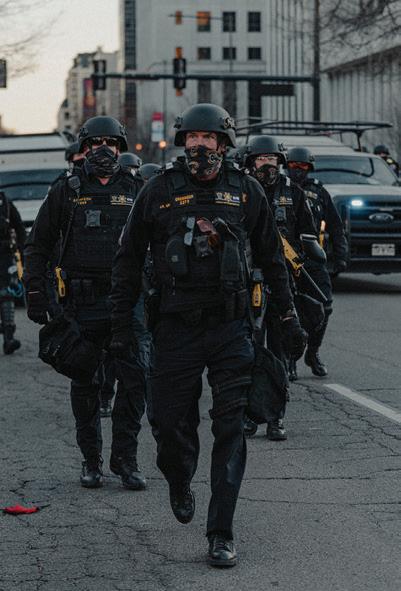
Only 7,384 were for a barricaded suspect and 1,180 for hostage-taking.
The disparity is clear, and it is purposeful. SWAT teams are being overwhelmingly misused. SWAT teams use military-style equipment, weapons, and tactics designed for the battlefield to conduct ordinary law enforcement activities.
They wear combat helmets and battle dress uniforms, fatigues designed by the U.S. military. The use of these battle dress uniforms is another trend lending itself to the militarization of policing.
In 1997, Bill Donnelly, a retired D.C. police officer, wrote in a letter to the Washington Post, “One tends to throw caution to the wind when wearing ‘commando-chic’ regalia, a bulletproof vest with the word ‘POLICE’ emblazoned on both sides, and when one is armed with high-tech weaponry . . . it would appear that U.S. law enforcement, even in the smallest and safest communities, is su ering from a collective ‘inferiority complex’ that can be relieved only by military-style clothing, and arsenals of formidable firepower.”
It’s not just the military equipment and tactical training that are most worrisome, it’s the soldier-like mindset that these o cers cultivate. One police trainer wrote, “We trainers have spent the past decade trying to ingrain in our students the concept that the American police o cer works a battlefield every day he patrols his sector.” Training in how to develop a “warrior mentality” is pervasive and extends well beyond hostage situations and school shootings, seeping into o cers’ everyday interactions with communities.
The National Tactical O cers Association has a powerpoint presentation urging trainees to “Steel your battlemind.” It defines battlemind as “a warrior’s inner strength to face fear and adversity during combat with courage. It is the will to persevere and win. It is resilience.” That whole thing is frightening. Who are they unleashing these people on?
Policing in Chicago has become unnecessar-
ily and dangerously militarized, and the War on Drugs has lost its mandate. A majority of Americans—67 percent—think the government should focus more on treatment than policing and prosecuting drug users. Now that the War on Drugs has reached its conclusion, devastating Black and Brown communities and leading to mass incarceration, they have harmed much more than helped communities. Black and Latino communities feel like targets in an undeclared war. During the 2020 rebellions in the wake of the police murder of George Floyd, Jahmal Cole, activist and founder of the organization My Block, My Hood, My City said, “It’s important to understand Chicago as reflective of the nation in terms of relationships between its Black populations and the police force. The police force has been contracted as a paramilitary containment force that has historically enacted its power on Black communities and at the command of leadership.”
The people in Chicago historically have a reason to be afraid. The city has a militarized police force that, according to the Department of Justice, has routinely violated the constitutional rights of Black and Latino Chicagoans. The pattern of violations led to the CPD being placed under a federal consent decree. The city has paid out over $700 million in settlements for police misconduct. We are the city of Jon Burge, who literally tortured victims into false confessions. We are the city of Reynaldo Guevara, who set up innocent men for murders they did not commit. We are the city of Ronald Watts, who ran a crew and sent many innocent men to prison.
The federal government needs to take the lead and stop or severely limit the flow of federal funds and military-grade equipment into state and local police forces. The state should legislate meaningful restraints on the use of SWAT teams. SWAT deployment should be limited to the scenarios they were originally intended for: barricade, hostage, and active shooter situations. We need clear standards in place limiting SWAT deployment to situations that are high risk. Finally, the police should be in the community, on patrol, not invading it like an army.
Chicagoans deserve better than to have to fear the police. v
Anthony Ehlers is a writer incarcerated at Stateville Correctional Center. Find out more about in carcerated journalists at the Prison Journalism Project (prisonjournalismproject.org).
@prisonjourn







 Introduction BY TARYN ALLEN, READER CULTURE EDITOR
Introduction BY TARYN ALLEN, READER CULTURE EDITOR



In my household, we’re currently celebrating “little treat” season. It occurs every year just as Chicago is shaking o the winter weather; on days when it’s extra sunny or unseasonably warm, my partner and I allow ourselves to go out and get a little treat. Now, “little treat” can mean anything from a shared iced co ee to a full-blown meal at a restaurant we’ve been dying to try, a reward for something or nothing at all, as long as money is spent irresponsibly and the outdoors are enjoyed to the fullest extent. Anything with a patio or enjoyed near the lake is fair game.

Should you, reader, decide to join in the festivities, consider this food and drink special issue to be your inspiration for the season. Grab yourself a drink at Pour Souls in Wicker Park, or have them batch a nice cocktail for you and a group. Make the worthwhile trek to the suburbs and hit Fritzi’s Deli, where you might just meet its eccentric and passionate owner, Paul Stern. You could even go all-out and treat yourself to a whole culinary experience, watching Mariko Kallister craft soba noodles from scratch or trying dinner and an (augmented reality) show downtown at Le Petit Chef.
Of course, you can also just sit back and enjoy the storytelling powers of the Reader names you know best: Leor Galil found a thread between Jim’s Grill in Lakeview and Chicago’s 1990s music scenes. Katie Prout talked to the fishermen of Montrose Harbor, most of whom are aiming to catch and eat the coho and Chinook salmon found in Lake Michigan.
As always, it’s a privilege to help curate issues like this; both the bounty of food stories in the city and the talent of our local writers, photographers, and illustrators make my job easy. Still, maybe I’ll go out and get myself a little treat, just to celebrate this one hitting the stands.

 By MIKE SULA
By MIKE SULA
Mariko Kallister’s strength flows from the force. You could see it in action one rainy night last March, her hands deep inside a lacquered wooden bowl in the dining room at the West Loop’s TenGoku Aburiya. As she began swirling fine buckwheat flour with a scant measure of filtered water, guests rose from their chairs as if pulled by the scent that filled the room: warm, earthy, mushroomy. Like “morning dew in the forest,” she later described it.
Thirty people had paid for this “performance”; a demonstration of a rare craft that included a four-course meal culminating in a classic expression of Kallister’s labors: zaru


soba, a tangle of chilled buckwheat noodles piled on a bamboo dish, with tempura vegetables and a soy-based dipping sauce to the side. The opportunity to eat fresh soba in Chicago is something akin to eating a unicorn—the event sold out within a day of its announcement.
“What makes soba fascinating is its simplicity, or minimalism,” says Kallister. “You add a lot of flavor when you make ramen—thick broth, chashu pork, spices, and lots of oily stuff. It is an ‘adding’ process. Soba, on the other hand, is a minimal process. Because of its simplicity, we are able to taste the freshness and natural umami of the ingredients, and the technique of the soba craftswoman.”
Relative to ramen, which is made in infinite,
ever-evolving varieties, soba noodles are old-school, simple, and appreciated for their inherent nutty, faintly sweet flavor, something you don’t want to smother with a lot of extraneous flavors and textures. Handmade soba noodles are a rarity in part because they’re di cult to make, they have a short shelf life, and they should be eaten quickly to appreciate their best qualities.
“Soba” is the Japanese word for buckwheat, which isn’t a grain but a flowering plant. Because it contains no gluten, its dough can become dry and brittle. Often—but not always—a lesser portion of wheat flour is added to the dough to give soba noodles their stretch and tensility. Commercial, dried soba noodles are usually made with a preponderance of wheat flour.
Kallister mixes 20 percent wheat flour to each batch of her dough. But she also adds something more intangible. She acts as a conduit for 気 , or “ki”—the “air,” “vapor,” or rather, the vital energy thought to be the animating force that moves through all living things.

“When I make buckwheat noodles, I smell and feel the freshness of the buckwheat, and I become a messenger who delivers this ‘life force’ from earth to the recipients,” she says. “It’s similar to the farmto-table concept. My master always emphasized how important it is to focus on the very tips of the ten fingers during mixing. They should act as sensors. Through my fingertips I can deliver the energy of the earth to people who eat soba.”
Kallister’s “master” is Kunihiro Takahashi, aka “the God of Soba Noodles,” whose restaurant Daruma, in the mountains near Hiroshima, was a mecca for the serious soba adherent.
Confusingly, other well-known Japanese noodle dishes like mazesoba, yakisoba, or Okinawa soba, contain no buckwheat at all. Chūka soba, or “thin Chinese noodles,” is an older term for ramen. Soba noodles made from 100 percent buckwheat flour, or a mixture of soba and wheat flour, arose during the Edo period when increasingly wealthy, urbane Tokyoites began slurping them in casual restaurants, typically chased down with sake (the precursor to the modern izakaya).
Buckwheat thrives in colder climates, which is why the island of Hokkaido and the mountainous Nagano Prefecture also became known for soba noodles. Over the centuries
they became established as both a cheap, convenient fast food, and as part of a rarefied cultural heritage, a high art, on par with Kabuki. “Factory-made noodles became so popular that the handcrafted noodle became rare and valuable,” says Kallister.


Kallister makes the latter variety, though she grew up far from soba central, in industrial Nagoya, Japan’s third-largest city by area. After college, she worked as a corporate event planner for a few years before the town’s conservatism wore her down, and she kicked o a period of wanderlust. She studied English in Boston, taught it to IT workers in Bangalore, India, and roamed around Europe drinking craft beer with her brother. “When I get excited about something, I go into it very deep,” she says.
She returned home and took a job leading foreigners on industrial tours for Expo 2005, a huge world’s fair set in the forest outside of town (now home to Ghibli Park). Kallister’s favorite part of the job was an outing she led to Nagoya’s Kamoshibito Kuheiji sake brewery.
“It was the first time I tasted freshly brewed sake,” she says.
“It was in a big wine glass, served by the owner himself. Fantastic. I never tasted something like that before, like, Chablis-type, very fruity aroma. I myself had a wonderful tasting experience. After this I was hooked. I wanted to do more to introduce non-Japanese people to sake culture.”
Kallister first met her future husband when they were both teaching English in Nagoya. In 2007, they married and settled in Chicago, where she took on a role as a freelance sake consultant. In 2008, she organized a major sake tasting event at the Consulate-General of Japan in Chicago, inviting some ten breweries to town. Another event followed the next year.
But with the recession and her newborn, the couple’s finances took a hit. Kallister began to dream of a pivot: opening a sake brewpub in Chicago. Naturally they would serve handmade soba noodles. In 2011, the family moved to Japan for an extended research trip.
First Kallister landed in Hiroshima after cold-calling Takahashi. She spent three days working at Daruma, where he taught her to knead, roll, fold, and then cut the delicate dough into noodles with an enormous rectangular knife larger than her forearm. He taught her balance and to put her whole body into the process, channeling ki through her fingertips.

“He holds a timer,” she says. “He says, ‘You are going to have to finish it within 40 minutes, otherwise the soba gets dry.’ The texture gets lost. And then the smoothness, the flavor. It’s all gone. So minimum movement and speed and not doing any unnecessary motion.” She and a fellow student would make two batches in the morning, eat soba for lunch, then roll out three more in the afternoon.
That winter the family moved to rural Yamaguchi Prefecture and took jobs as brewing assistants at the Dassai brewery, which was expanding production of its high-end daiginjo
sake with the aim of U.S. distribution. She started out in packaging and bottling. “It’s a temperature-sensitive product, so we did the packaging outside in the snow. I kind of got scared that maybe I would be found frozen, dead.” Later she moved to the lab and worked with yeast analysis and cultivation. When she had free time, she practiced noodle making.
Just before returning to Chicago in 2013, she took a six-week intensive sake course—from rice washing to pressing—at the National Research Institute of Brewing in Hiroshima. But “the market in Chicago was still premature for sake,” she says. “And I didn’t think Chicagoans

would be interested in soba yet back then.”
So the dream was deferred, and then it stalled out completely when the couple’s marriage broke up. Now a single mom, Kallister took on a series of corporate jobs, but she kept her hands in the dough, particularly after a chance encounter at a sushi bar with a new Japanese Consul General led to her first performance at the Consulate residence in Evanston in 2017. A second followed at Murasaki Sake Lounge in Streeterville.
“I realized the soba noodle stimulates five senses,” she says. “The smell of fresh buckwheat. You can see the performance, hear the

noodle cutting. There’s the feeling of al dente noodles, and the taste of fresh buckwheat. Plus, soba connects people. I invite people to the performance table and they share the moment to smell ingredients and taste the freshly made noodles together.”
In the dining room at TenGoku Aburiya last month, Kallister, who stands at 5’2”, began to break into a sweat. As the flour gradually came together in ragged clumps, she began kneading. She formed and pleated the dough into a blossom shape, and then a cone, smoothing its surface and pressing out the air within. The table, set on silicone mats, shook with her


motions. On a separate occasion, as Kallister kneaded, I witnessed a two-inch screw fall out of the underside of this same table.
Using a set of three rolling pins, she flattened the dough, turning it by 30 degrees with each roll, gradually coaxing it into a square. She then folded it upon itself a dozen times, each layer about a millimeter and a half thick.



She set the dough sheets atop a long wooden cutting board, and using a smaller board on top as a guide, began cutting. She gathered the noodles in bunches—enough for about eight portions of soba—and then sent them o to the kitchen to be boiled and shocked in ice water.
There are plenty of di erent preparations
of soba noodles, hot and cold. But for the fresh ones, it’s best to focus on the noodles themselves, in this case dipped a third of the way onto a cold sauce made from dashi broth and kaeshi, a mixture of soy sauce, mirin, and sugar.
“You don’t want to dip the soba into the sauce all the way,” she says. “You should enjoy
the umami of the ingredient. The sauce should act to emphasize its umami, not cover the soba entirely.” Don’t chomp on them either, to appreciate “nodogoshi,” or the sensation of the noodles slipping down the throat. “You should chew a little bit and swallow it.”
Kallister says she can make about 40 portions a day (she’d already made two batches

continued from p. 19



earlier). She runs marathons, so the process isn’t as physically demanding as it used to be. “It requires more stamina than power, as you want to constantly use your energy: mixing, kneading, rolling out, and cutting. The knife is heavy! I didn’t start running for soba, but I realized after my first marathon that the kneading process became so much smoother. Soba contributes to running as well. Eating soba makes me healthy and strong. I run for soba, and I make soba for running.”

Still, she’s not capable of producing enough each day to sustain a restaurant. You can find fresh handmade soba at rare restaurants on the west coast and in New York, but for now, Chicago has Kallister’s occasional performances. There’s one scheduled this Sunday at noon at Torino Ramen in Wilmette, where she also tends bar on Monday nights dispensing her sake expertise. She returns for two performances at TenGoku Aburiya on May 11, for which the kitchen will prepare soba with tempura again, and also tororo soba, mixed with sticky mountain yam (yamaimo) and fermented soybean (natto). There’s a third coming up in June, TBA, at Murasaki Sake Lounge.




Kallister was surprised and motivated by her audience’s immediate reactions to the force of her performance, so there are more to come. “I never noticed that buckwheat’s fresh aroma would attract American people. I thought, ‘Oh wow. The audience has very delicate senses. The audience is now matured and wants to know more. It might be the time.’” v





Since 2013, Forward Momentum Chicago has been engaging local students in the art of dance by meeting them where they are—in their schools.
The South Loop–based organization is led by founder and executive director Pierre Lockett, a professional dancer who performed with the Dance Theatre of Harlem and the Joffrey Ballet, where he also served as director of outreach. He was inspired to start Forward Momentum a er observing the positive impact of dance classes on his young niece.
Lockett envisioned Forward Momentum as a dance education program that could bring resources and training directly to students who might not have the means to afford or travel to regular dance classes. “I thought ‘How about if I take the work that I’m doing at the Joffrey, make it a little bit more intense, and expand beyond bringing the children to us?” Lockett says. “I recognized that there is a need for programming in the schools and for that programming to be affordable.”
Today, Forward Momentum provides dance training to 45 schools and 5,000 students across the city, mostly within the Chicago Public School district. Many of the youth served by Forward Momentum are introduced to dance instruction through their programs. “For a lot of students, this is their first opportunity to do something creative that is natural for them,” Lockett says.
Their most common classes include hip-hop, African dance, Latin dance, ballet, and creative movement, though they’re able to tailor their programming to meet the objectives of school stakeholders. For example, they might use dance to teach students about diverse cultures or to help them improve fine motor skills. In addition to in-school classes, Forward Momentum runs yearlong programming in partnership with A er School Matters, a local nonprofit that allows students to explore their passions through a er-school and summer learning opportunities. They also host free Saturday dance classes for students who wish to expand upon their dance training.

While their programs are centered around dance, Lockett says the ultimate goal of Forward Momentum is for students to take away important life lessons and skills from the art form. “It’s not necessarily about making them dancers for me. I think it’s more important for them to learn the skills that are associated with being a dancer,” Lockett says. “It’s a confidence builder. It helps develop personality. It helps develop character.”
In 2019, Forward Momentum joined a cohort of dance organiza-
tions involved with the Chicago Black Dance Legacy Project (CBDLP), a program dedicated to addressing inequities within the city’s dance landscape by providing local Black-led dance organizations with funding, advocacy, organizational growth strategies, and shared performance and marketing opportunities.

As of today, Forward Momentum is the only organization in the cohort focused solely on community engagement and dance education. Since joining, Lockett says that his students have been able to participate in joint performances with the companies within the cohort, allowing them to connect with some of the most influential dance figures in the city.
“For [the students] to be able to see the other professional dancers and interact with them, and see other possible opportunities to expand their training, that’s really more important to us,” Lockett says. “The more they see and the more they’re exposed, it makes them feel that what they’re doing can lead to something else.”
For some Forward Momentum students, that exposure has led them to pursue careers in dance education. Program manager Bradlee Lathon is one of several Forward Momentum former students that went on to work for the organization as teachers or in other staff roles. Since Forward Momentum joined the CBDLP, Lathon has also been able to learn directly from some of the city’s most influential dance leaders.
“As a young dancer, I was seeing Joel Hall [of Joel Hall Dancers & Center] and Homer Bryant [of Chicago Multicultural Dance Center] and Nicole Clarke-Springer [of Deeply Rooted Dance Theater], and now I get the opportunity to sit in rooms and listen to their successes and their failures and how they are trying to make the legacy of Black dance sustainable in the city,” Lathon says. “Myself and my peers that are coming up [in the local dance community] know that we have a lot of work to do, but we also have that support.”
Reflecting on how Forward Momentum has fostered the next
generation of Chicago dance leaders, Lockett says, “We’re seeing this full-circle moment. We’re seeing that what we’re inspiring them to do, they’re actually doing—which is becoming awesome human beings.”
Forward Momentum has exciting plans this summer. In addition to their Saturday class showcase on June 3 and its annual fundraiser on June 8, they’ll host the Epstein Family Foundation Summer Dance camp, starting June 26th, with locations in Englewood and Avondale.
As Forward Momentum nears the tenth anniversary of its founding, Lockett says he remains in awe of the thousands of students who continue to commit themselves to learning the art—and joy— of dance.
“This program is designed to push you beyond what you’re thinking you’re capable of doing, and nine times out of ten, the students rise to the occasion,” he says. “I am just constantly amazed at their desire to finish what they started and to get better and do better.”
The Chicago Black Dance Legacy Project is a program of the Logan Center for the Arts at the University of Chicago. Their current cohort of local dance companies includes Chicago Multi-Cultural Dance Center & Hiplet Ballerinas, Deeply Rooted Dance Theater, the Era Footwork Collective, Forward Momentum Chicago, Joel Hall Dancers & Center, M.A.D.D. Rhythms, Move Me Soul, Muntu Dance Theatre of Chicago, NAJWA Dance Corps, and Praize Productions Inc. For more about CBDLP, visit chicagoblackdancelegacy.org, and chicagoreader.com/special/ logan-center-for-the-arts-at-the-university-of-chicago.
To learn more about Forward Momentum’s programs and upcoming summer camp, visit forwardmomentumchicago.org.
Momentum Chicago teaches Chicago’s youngest generations about dance and lifePhoto by Matt Karas
The salmon were running, was the word: they were there to catch them, and I was there to see them do it.
LLOYD DEGRANE
of the waves mixed with DuSable Lake Shore Drive. The man with the flashlight freed one of the lines and stretched it out along the pier. Minnows were strung evenly along it like Christmas lights; the ones that were still alive twitched. From farther down the harbor, I heard a sound like the firing of a Nerf gun but much louder. A pu of vapor floated above a man crouched near a five-gallon bucket with what appeared to be the upper half of a broomstick protruding from it. Attached to the broomstick was a reel of fishing line crowned with a little gold bell. Next to the man, a red extinguisher, filled with CO2 instead of chemical fire retardant. This was powerline fishing. With a weighted line, a pressurized canister, and a little Big-Shouldered chutzpah, fishermen at Montrose Harbor have been catching fish this way since the 1950s, when they invented the method right here, according to the owners of the Park Bait Shop 100 yards behind us. (They may have a business interest in keeping that story alive, but, family-run since opening in 1958, they were also here to see it.)
An eclectic mix of people practice powerline fishing at Montrose Harbor, catching and eating coho salmon despite the health risks caused by pollution.
 By KATIE PROUT
By KATIE PROUT
At sunrise on March 26, all of Montrose Harbor was anticipation and birdsong. Like the migratory birds in the wooded sanctuary behind them, the 20 or so fishermen who dotted the harbor were from everywhere: Kenosha and Cambodia, Elk Grove and Ukraine, Logan Square and Germany. They woke up at two and drove from Indiana; they slept on their sisters’ couches. They biked here from West Ridge, tackle boxes and buckets rattling in a little wagon behind them.
The salmon were running, was the word: they were there to catch them, and I was there to see them do it.
I myself was also running—from the bait shop where I’d parked my car to where the harbor juts furthest out into Lake Michigan— late as always to meet up with documentary photographer Lloyd DeGrane, who’d suggested this adventure. Despite living here for years, I’d never seen the sunrise break over the water, but I made it just as the sun burst up
from the lake, a fiery orb. Then I found Lloyd with his camera, watching a man with a flashlight on his head struggle with two fishing lines as he complained in a language neither of us spoke. One line had crossed with another, creating a mess, but not for nothing: the water rippled. His friends clustered around him, narrowly avoiding kicking over the Dunkin’ Donuts coffees on the ground next to their gear. One grabbed a net; another began to reel. We watched for a while. The white noise
With this technique, fishermen can shoot their lines a couple hundred yards out, reaching the cooler waters preferred by coho and Chinook salmon, stocked in the Great Lakes since the mid-60s. Books can and have been written about the choice made by former Michigan state fisheries chief Howard Tanner to fight the invasion of one non-native species of fish (alewives) with the introduction of another (salmon). Since then, alewives have vastly diminished, but to lure hobby fishermen and their dollars, Great Lakes states continue to stock salmon, albeit in fewer numbers— partially because there are fewer alewives to sustain them and partially because the fish are now breeding on their own.
Suddenly, a few feet in front of me, there were shouts and a splash. The fisherman who’d been reeling held up his catch, beaming—not a salmon, but a heavy brown trout, slick and gasping. There was a little red blood on its mouth and gills. As it writhed, scales fell through the air like glitter and landed, shimmering and wet, on the concrete of the pier. He hooked the fish through the mouth and gill, attached it to a new line, and threw it back in the water, where it’d swim, leashed, until it was time for it to die. The man turned to us with a ruddy, cheerful face. “Nice work!” said Lloyd. This is how we met Andrew, 50, from Glenview via Ukraine, and got to talking.
My name is Katie, and I’m with the Chicago Reader. Can I ask you about what you’re doing here?
I mean, I’m just here first time with my friends. . . . [ Sheepishly smiles ] I just come here with the two coffees, you know?
How do you like it so far?
Like it so far. You see, I just get it!
We saw! Congratulations. Are you going to clean it yourself?
He probably going to do it. [ Jerks his head to a friend.] Like I say, I’ve never been here. I fish regular fishing, o the shore on fishing rods, not on a powerline. I want to see what’s going on. How have that happened? It’s kind of surprise. You have to check [the powerline]; it has multiple hooks.


I get here like 6:15, 6:20—
—With the co ee?
With the co ee. [Laughs.] Dunkin’ Donuts, get co ee, but so far we didn’t even have the time to sip it, because all this action. That’s pretty cool.

You had to drive to get here. Is it worth it?
I mean, worth it? Yes! And it’s a really nice day, you know? I’m not gonna stay that long because we have plans with my family; we have lunch—
Are you bringing lunch?
—at the restaurant. [Laughs] I mean, I can definitely bring at least one fish and cook.
And they’ll believe that you are here. Proof.
Proof!
My mom’s still in Ukraine. My dad, my family’s here. My mom, she don’t want to come here. She was a couple times here, but she’s old generation. My brother is there too. I’m from Liev, by the Polish border. Really bad up there.
I hope everything is OK for your family.
Thank you.
Can I ask what your name is?
Andrew? Andrew, but actually in Ukraine? I’m Andrii.
The topic switched to the birds flying over our heads. “It’s beautiful,” said Andrii, “it’s so very nice.” He wanted to try some bird-
watching next; he’d heard Waukegan was a good spot, as well as Zion, Illinois. Then, we said our goodbyes and good lucks.
Twenty feet down the harbor, a 15-year-old boy with black hair and shy dark eyes was unwrapping tamales. “Sure,” he smiled and said to his shoes when I asked if we could talk, “but I’m not an expert. I’m with my uncle.” The boy’s name was Jake. It was his second time powerline fishing. They hadn’t caught anything yet, but his uncle had just redone their shot. “It feels like a good one,” Jake said. His uncle, who had been messing with the line at the water’s edge, came over. “You get anything out of him yet?” Brian, 45, joked.
Both uncle and nephew were new to powerline fishing. It was Jake’s neighbor who’d put Brian onto it, inviting him out for his first time three weeks before. The next weekend, Brian rigged together some gear and crossed his fingers. He caught eight salmon then, three over the state limit of five per day, releasing back what he couldn’t keep. The rest went to a friend who owned a restaurant. “On the record, he doesn’t serve it to customers, and I can attest to that,” Brian told us. “But he does like to eat the fish.”

Each trip brought with it a new lesson, and this Sunday’s was to pack more food. “I hope he’s liking it,” Brian said a little anxiously, watching Jake squat at the harbor’s edge and study the water. They’d driven in from Elk Grove Village and arrived before sunrise, up so long that they were almost ready for lunch. But as ever in Chicago, there was a Tamale
Guy—a man further down the harbor, Brian said, named Jose, who makes tamales weekly to sell while he fishes himself. “They’re really good,” confirmed Jake.
A few yards o the harbor, bu ehead ducks dipped under the frigid water, wriggling their tails toward the still-brightening sky. Everywhere, I heard gulls crying and men complaining. The water was too still, the weather cold but sunny—too nice. “Weather that’s good for people is bad for fish.” “Nothing’s biting.” “They crossed my lines!”
We kept walking. Two friends in their 20s dangled their legs over the harbor’s edge, catching the sunrise before turning in after a family member’s all-night quinceañera. Nearby, a man wearing a Cubs hat used an empty container of mustard as a floater. “It’s my good luck charm,” he explained. Down the way, a 60-year-old white man with a suncreased face and a flannel jacket sat rather forlornly in a camp chair. He looked like an extra from Jaws but had an accent straight out of the Wisconsin woods. Next to his chair, an old-fashioned red wagon held his canister of CO2; on top of his tackle box sat a doughnut and a Diet Dr. Pepper. His name was Tommy, and he also recommended the tamales from Jose (“They’re real authentic, stuffed with chicken”), although according to Tommy, Jose didn’t charge. Maybe Jose just didn’t charge Tommy; the way the latter talked, Jose was another buddy he’d gotten to know at the harbor, along with two others who now and then made a trip to visit him and ice fish.

continued from p. 23
How ya doing?
Oh, not too bad. Wish the fish would cooperate.
Whatcha doing?
We’re powerlinin’ for salmon.
How often do you come here?
Oh, I don’t know, one or two times a week.
What time did you get out here?
Oh, really early. Got here at five o’clock this morning. Coming from Kenosha. This is what we’re fishing for [ shows picture of filets on his phone].
Looks great.
Yup. Usually when we catch them, we clean them, filet them, bake ’em, or put ’em on the grill. But it’s been slow this morning. [Sighs, squints, and looks out to the horizon. ] You never know with these fish. They could start anytime. Last week, we all did really good. I hit my limit. So did my friend and his son. I’m only fishing today here ’cause then I’m going to La Crosse [Wisconsin]. My friend texted me—they’re getting a lot of perch.
Oh, so you’re a fisherman, fisherman.
Oh yeah, we’ll probably go for two, three days.
Behind Tommy, on the stone stairs that lined the harbor, Jennifer, 20, and Mary, 21, sat in hoodies and blankets, clutching gigantic Starbucks drinks and switching between Spanish and English. “We just came to see the sunrise,” they told me, in near unison. The sun was higher now; the sky spilled paint. The colors were taking on a pewter hue that would only darken as the day went on, the clouds eventually dumping snow. But right now Jennifer was happy. When she drove in from the north side to watch the dawn two days before, it was so cloudy she couldn’t see the sun.
A few feet from Mary and Jennifer, a handful of white men from Indiana huddled quietly around a kerosene heater. The shimmering heat it gave o made their faces look wavy as it rose up, carrying the smoke from their Marlboro Light 100s with it. A German shepherd puppy named Noah pointed his nose hopefully toward a wire wagon up on the steps: inside, a coho salmon, the first I’d seen this morning, lay freshly dead. Noah’s owner was a plumber from Indiana named Doug, 38, here fishing for his fourth year. He told me he’s never had much luck line fishing, and this year, neither had the rest of his crew. But, “I used to work with these guys, and this is the only time a year I go out and really see ’em,” he said with a shrug and a smile, a Busch Light in his hand. Just then, one of his buddies hollered. One of them had caught a salmon. Doug began razzing. “Push him in the water!” he called out. “I come here specifically so that he doesn’t catch a fish.”
Across the water, a greenish tint hung over the Indiana coast, pretty and alarming. This lurching two-step—admiration for beauty and bounty, followed by the realization of the manmade damage present in both—defines my relationship to this water. The Great Lakes are less polluted than they used to be, and that’s
no small thing, but it’s still not recommended you eat the fish from them more than twice a week at most. “Eating just one freshwater fish a year can dramatically increase the amount of toxic forever chemicals coursing through a person’s blood, according to a new study that reflects more than a half century of pollution contaminating the Great Lakes and rivers nationwide,” reported the Chicago Tribune this January.

Perfluorooctane sulfonate, or PFOS, is a chemical found in paint, firefighting foam, stain repellents, and nonstick cookware. Thanks to industrial pollution and anemic federal regulation, it’s also now found in our Great Lakes. PFOS builds up in human blood, doesn’t break down in the environment, and triggers health problems such as liver damage, impaired fertility, immune system disorders, thyroid disease, increased cholesterol levels, and reduced vaccine e ectiveness. Long-term exposure might also cause cancer. The fishermen of Montrose Harbor are keenly aware of the presence of PFOS and other forever chemicals in the fish. (It came up in conversation with nearly everyone I spoke to.) But what interested me was that, instead of repelling them from the water, this knowledge drew them closer to the lake. Each shared with me their tips and tricks for preparing the fish, their appreciation for the vital, unique nutrients their catches still supply (and for the relationships built through this hobby), and their attentiveness to the lake ecosystem’s health and cycles by fishing in season and abiding by catch limits set by the state. It struck me how intimate they were with the lake and its creatures, how they seemed to understand themselves as part of both. There were some bittersweet memories and some dark jokes, but I didn’t hear any despair.
“Since I’m not having any kids, coho is OK
to eat,” joked David, 46. Originally from Germany, he was fishing with his friend John, 50. John, born and raised in the city, sported a brown mustache and kind eyes and looked like he knew where to find a good Chicago hot dog. At three and four years old, he’d hunt for crayfish under the boulders that used to line the harbor, before it was manicured and paved, while his dad fished.
Did you see the guys shooting the weights with the extinguisher? When I was little, they did it without the extinguisher. Yeah, they would just use a railroad spike.
Really?
And a guy would just [gestures lassoing] like a cowboy overhead. My dad was a big fisherman down here. He was a butcher at Jewel for 35 years and would come down here every morning before work. Clarence the butcher. He just loved it.
Do you eat them?
It depends. Coho if they’re younger and not as big, so you wouldn’t have as much of the PCBs [polychlorinated biphenyls, man-made chemicals] and stuff like that.
Do you filet them, smoke them?
Filet ’em, and he just made a smoker last year.
David: Oh, yeah! We’re hoping to get some this time so I can try it out. Also, if you are concerned about forever chem-
LEARN MORE AT: chicagosfoodbank.org/BAN
This institution is an equal opportunity provider and employer. This project has been funded at least in part with Federal funds from the U.S. Department of Agriculture. The contents of this publication do not necessarily reflect the view or policiesof the U.S. Department of Agriculture, nor does mention of trade names, commercial products, or organizations imply endorsement by the U.S. Government. Access
icals, smoking is a good way, because it melts out a lot of the fat, and all those things you don’t want are in the body fat. You’re trying to already trim o the belly fat, and then yes, smoking is pretty much the best way to go about it.
Unfortunately, not everything in the fish can be cut or melted away. Mercury, for example, is stored over time in muscle, not fat, which is why John only eats coho that are younger and smaller. “Cooking does not destroy chemicals in fish, but heat from cooking . . . allows some of the contaminated fat to drip away,” confirms a fact sheet issued by the Illinois Department of Public Health. “You can reduce the amount of these chemicals and your exposure by properly trimming, skinning, and cooking your catch.”

As we walked back up the harbor, Lloyd and I passed Andrii and his friends. More had arrived, including two little boys wearing overall snow pants. Brothers, perhaps, cherry-cheeked and under the age of ten—one tended to the fishing reel while another turned pork kebabs over a small impromptu grill. Bows and arrows, made out of sticks and the rubber fishing line shot from the canisters, were scattered on the stairs behind them.
Even though we had poles to share as children growing up in Michigan, my brothers and I liked the collaborative work of making our own. The water lapping at our calves, we’d dip our lines, tied to foraged sticks, into our town’s inland lake and pull out pumpkinseed and bluegill no larger than our hands. We never ate those fish—the run-off from the homes crowding the water made that a bad idea. But from the Au Sable River, a tributary of Lake Huron, we pulled bass and perch to eat with our dad, who grew up on those waters and loved showing us what he’d learned.
Cultural and intergenerational, fishing together provides a kind of sustenance that goes beyond the universally tainted flesh. Through fishing, perhaps the brothers in snow pants and Jake with his uncle will develop their own relationship to the water and each other, and when they grow up, pass on their own understanding of how interdependent we all are.
In the meantime, on the harbors of Chicago at least, there are always tamales to tide you over until all the fish are safe to eat in any amount once more. v
@katie_prout


You don’t have to talk to Stern long to find out he is a major foodie. He loves talking about all the odd, out-of-the-way eateries he knows in and around Chicago—the overlooked food trucks, the eccentric hot dog stands, the little holes in the wall that serve great tacos, the remarkable chicken-fried steaks, the unusual variations on the pizza pu .
Fritzi’s Delicatessen has only been open since August of last year, but it already has the feel of a place anyone would adore: comfortable, solid wooden chairs and tables sit underneath recipes for classic Jewish foods like Nonie Sidell’s Orange Mold, Aunt Bibi Fink’s Knishes, Aunt Hannah’s Pickles, and Lillian Zlubin Feldman’s Knaidles with Neshama, all reproduced in large print along one wall. Photographs of quaint old Chicago hot dog stands (from Chicago photographer Patty Carroll and historian Bruce Kraig’s 2012 book Man Bites Dog: Hot Dog Culture in America ) adorn the other. And there’s a menu full of deli classics devised by a bona fide foodie to please fellow foodies.
Paul Stern’s pandemic project has quickly become an exemplary Ashkenazi Jewish deli in Oak Park.
By JACK HELBIGPaul Stern is a born schmoozer. Walk into his restaurant, Fritzi’s Delicatessen, a small well-lit place in Oak Park, and chances are you will find Stern schmoozing at one of the tables in the dining area—cracking jokes, telling stories, quizzing the people around him about lives and likes, and asking how they enjoyed their meals. It makes sense. His livelihood depends entirely on pleasing his clientele.
But Stern’s interest in people runs deeper
than that. He seems to genuinely care about his customers. Or maybe being in the hospitality industry for more than 40 years—as a bartender and restaurant manager and owner— has taught him how to give that impression. He gets to know his regulars very well.
“He was a firefighter in New York City through 9/11,” Stern tells me about one customer. About a couple: “I met these guys on Maxwell Street. They sell jewelry on Maxwell Street.” Another: “She comes in literally every
The meats at Fritzi’s are smoked in-house with recipes that Paul Stern has spent years perfecting.

Stern first fell in love with cooking as a child growing up in Gary, Indiana. “When I was six or seven,” he says, “my mother went back to work at the Gary school system as the head of reading diagnostics. So I said, ‘Mom, what are we going to do about breakfast?’ She said, ‘You want breakfast? Cook it.’ So I started cooking breakfast for myself and my two brothers. And I found I enjoyed cooking. I have loved cooking and loved food ever since.”
day of the week; she doesn’t cook.”
RFRITZI’S DELICATESSEN
113 N. Oak Park, Oak Park, open Tues-Sat 11 AM-9:30 PM, Sun 11 AM-3 PM, 708 - 613 - 4760, fritzisdeli.com
Stern’s customers return the favor, grabbing him for a bit more schmooze before they vamoose. While I was interviewing Stern, a customer came up to him on their way out and handed him two small glass jars, one containing homemade horseradish, the other homemade chopped liver. Stern thanked him and put the jars carefully away for future sampling.
In his early 20s, Stern worked for a time as a firefighter in Gary. Naturally he spent most of his non-firefighting time at the firehouse in the kitchen. “I cooked lots of things for the guys I was not used to. Chitlins. Smothered chicken. Smothered pork chops. I mean, I would also cook on my side of the coin, too. I would do brisket,” he remembers. Later, Stern switched careers (“Gary was a poor city, so the firefighters were not paid well enough to be worth my life.”) and entered the restaurant industry. His experience includes stints working at two restaurants owned and run by legendary Chicago restaurateur Mike Foley—First Street and Foley’s Grand Ohio. “I was everything there,” Stern explains, “waiter, bartender—whatever they needed me to do, I was doing. That was my first really good introduction to what it meant to work for a white tablecloth [restaurant].”
Stern also helped open Harry Caray’s Italian
Steakhouse: “I came in two months before it opened up to get the bar set and ready to go for them. I was the original head bartender, and they won’t admit it, but I was largely responsible for bringing the full menu into the bar. So my debate with them was that single people don’t want to sit at a table by themselves and eat, but they’re happy to sit in front of the bartender.”
After Harry Caray’s, Stern had his own place in Lincoln Park, Lucille’s, before closing it after 12 years and going to work at a friend’s place, the Suite Lounge, in Old Town. “I was there for the next 14 years. I was there until the pandemic started.” The Suite Lounge was one of the many places shut down by the city of Chicago after the crazy weekend of March 14 and 15 when hordes of drunk Saint Patrick’s Day revelers failed to follow COVID protocols and maintain social distancing.
“So that happened,” Stern says, referring to the closing of the Suite Lounge, “and then I

took the next two or three months o and just sort of, for the first time since I was about 12, enjoyed not having to work.” It turned out to be a fruitful time. “There was never a time I did not think about opening a deli,” Stern admits. Suddenly he had time to do more than just daydream. Stern began meeting with chef Nick Labno in his home kitchen, working through recipes for Jewish food. “I’m the happy owner of about 600 Jewish cookbooks,” Stern kvells. “They have their own cabinet in my house.”
For years Stern had been playing around at home smoking di erent deli meats. “The pastrami recipe we use is something I worked on for probably a decade. The brisket I have been making for a very, very long time.”
Together they worked to make Stern’s recipes “restaurant worthy.” “Because,” Stern explains, “there’s a di erence between what you can do at home and what you can pull o in a restaurant.”
The result is a menu that looks like a familiar deli menu but doesn’t taste like it. All of the items have a personalized spin to them. The meats on the menu—the pastrami, the corned beef, the brisket—are smoked in-house, and all of the bread used for the sandwiches is freshly baked in the kitchen. “We do everything. The thing that makes us really unique pretty much in the whole midwest is that we’re one of the only places that does all this by hand anymore.”
During lockdown, Stern also sketched out his ideas for the look and the feel of Fritzi’s; even before he had found a space, he knew what kind of layout the restaurant would have and what its ambience would be.
“Restaurants are not like regular businesses; they are like people. They have to have a personality. They have to have a statement of what they believe is the right thing to do. And it can be anything, but it has to be a complete



thought, a complete statement.”
“So one of the reasons why this menu is what it is is that I want to be very clear that this is what I’m doing. This is Ashkenazi Jewish deli food. Not putting a hamburger on it, not putting pork on it, no shellfish. But I don’t pretend to be kosher.” (Fritzi’s menu includes a Reuben sandwich, which cannot be kosher as it mixes dairy with meat.)
And the result of all of Stern’s hard work: a workplace that doesn’t feel like work, a job that doesn’t feel like a job. On the sign out front, underneath the name of the place, is its shibboleth: “Good Food for the Soul.”
It has certainly been good for Stern’s soul: “I get up every day, and no matter if I’m tired or not, I get here and I find energy here. I have the joy of working with people who I love around me. This is my home. This is my family.”
Paul Stern: “We do everything. The thing that makes us really unique pretty much in the whole midwest is that we’re one of the only places that does all this by hand anymore.”
meal. It is the hope that the diner leaves with a greater awareness of the complexity of the everyday ingredients used in the dishes that we present. But most of all, [the goal is] to have fun by enjoying delectable food, French wines, and a truly unique experience.”
Fairmont’s dining staff play an integral role in the immersive experience. To execute a seamless dining experience that’s choreographed with a preset animation, the Fairmont kitchen and waiting sta must plan their serving times with precision, all the way from the appetizers to dessert. That way, when Le Petit Chef finishes cooking the dish, it materializes on the table.
“The kitchen team needs to work in complete harmony with the serving and front of house teams to deliver each dish perfectly timed to the virtual theater cues,” says Ambrose. “Working as one and depending on each other is critical to ensure perfect execution and an exceptional guest experience.”
Fairmont Chicago’s new culinary experience Le Petit Chef immerses guests in augmented reality.
By MAXWELL RABBThere’s big talk about a little chef in Chicago. Unlike at other fine-dining restaurants, this chef reveals his culinary secrets at the dinner table. He visits guests before every course and teaches them about their meal’s ingredients by demonstrating how the food is prepared. But here’s the twist: the chef is two-and-a-half inches tall . . . and he’s virtual.
If you’re looking for an unconventional and mouthwatering dining experience, the tiny chef, or Le Petit Chef, is hosting guests in the Cuvée Room at Fairmont Chicago, Millennium Park until the end of the year.
The Fairmont partnered with animators TableMation Studio to present this immersive dining experience, which uses 3D projection
mapping to cast a video onto the table from above. It follows Le Petit Chef, a miniature French chef created by the Belgian artist collective Skullmapping. The animated chef narrates a dynamic five-course tasting menu that’s choreographed with precision thanks to the Fairmont dining staff. Defying expectations of traditional upscale dining, the 90-minute gastronomical theater blends together “dinner and a show” with its jaw-dropping animated performance.
“You’re immersed into the tiny chef host’s world from the moment it begins,” says William Schultz, Fairmont Chicago’s director of food and beverage.
More than anything, Le Petit Chef gives guests an opportunity to observe the culinary
RLE PETIT CHEF
Fairmont Chicago, 200
N. Columbus, Thurs-Sat 6 and 8:15 PM, reservations required, $155 + per person fairmontchicago.com/ le-petit-chef
arts up close. Chefs often remain behind closed doors while diners enjoy their food without fully appreciating the effort behind every meal. This interactive dinner invites people to join their tiny host on an edible adventure that explores a chef’s mind. As he moves from plate to plate, the chef teaches diners about the history, ingredients, and techniques behind their food.
“The interactive element of Le Petit Chef brings an overall educational component to the dinner, o ering the diner a di erent perspective and background into everyday ingredients,” says Elton Ambrose, executive chef at Fairmont Chicago. “It allows the diner greater insight into the mind of a chef as they create a
The tablecloth is Le Petit Chef’s canvas. Every course is accompanied by a storyline, exploring the ingredients necessary to prepare Fairmont’s tasting menu. While the tiny chef plays the leading role, the settings and side characters elevate the animated production. Guests journey from course to course, accompanying the chef through settings including Parisian gardens or Venetian canals, traversing the production’s homages to artists such as Marcel Duchamp and Vincent van Gogh. Or dinner is interrupted by a crowd of dancing carrots, avocados, and champagne bottles, resulting in an eye-popping blend of Beauty and the Beast and Ratatouille
Le Petit Chef launched in several other cities before arriving in Chicago. The tiny host has served dinners in restaurants located in Warsaw, Taipei, New York City, Los Angeles, and Dubai, but his stay at the Fairmont is the tiny chef’s debut in the midwest.

“We are thrilled to bring this unique dining experience to our guests, the city of Chicago, and the larger midwest region,” notes general manager Clay Spencer. “The Fairmont Chicago culinary team has been working diligently to prepare for the unveiling. We’re delighted for


CHICAGO WITH A TOUCH OF SALT
5-11
THE WOOD BROTHERS WITH SPECIAL GUEST SHOVELS & ROPE
5-12 BRIGHT EYES WITH MAYA HAWKE AND TIM KINSELLA & JENNY PULSE
5-16 MUNA WITH SPECIAL GUEST NOVA TWINS
UPCOMING SHOWS
5-24 HIPPO CAMPUS WITH GUS DAPPERTON
6-6 THE SISTERS OF MERCY
diners to experience this culinary adventure through animation. It is a dinner like no other.”

And let’s not forget dinner. Fairmont and Le Petit Chef prepare a delectable five-course tasting menu that kicks o with its dynamic Tomato Three Ways, accompanied with visuals illustrating the history of the tomato. Next, Le Petit Chef whips up The Art of Carrots, serving salt-roasted carrots with quinoa granola, baby greens, mandarin oranges, and carrot-top pesto; and the chicken roulade, a bacon-wrapped chicken dish served with haricot verts, potato, wild cranberry, and pickled mushrooms.
For the main course, Le Petit Chef plates up poached beef with spinach, mustard seeds, caramelized onion, beets, and bittersweet chocolate. And finally, the dinner concludes with a hazelnut and sea salt mille-feuille with chocolate crémeux, burnt orange caramel, and
Nutella for dessert.
The immersive dining experience starts at $155 per person. Guests can add the French wine pairing for $42 per head. Le Petit Chef hosts two seatings at 6 PM and 8:15 PM every Thursday through Saturday. The luxury hotel will host Le Petit Chef for the remainder of 2023, giving Chicagoans a chance to experience the groundbreaking blend of technology and gastronomy.
“Dining is not just about food anymore; it’s about the overall experience and how that enhances your senses,” Schultz says. “One of the first senses we experience when dining is visual, and if we can stimulate that sense through Le Petit Chef’s visual imagery, guests interactively get excited about what will come next in each course.” v
5-20 RED BULL DANCE YOUR STYLE
6-8 TYLER CHILDERS WITH SPECIAL GUESTS MARCUS KING AND MILES MILLER
NATIONAL FINAL
5-21
FUTURE ISLANDS
6-9 NICKEL CREEK WITH GABY MORENO @SALTSHEDCHICAGO
Chicago Opera Theater is trying out a new opera at the Athenaeum next week. Titled The Cook-Off , it’s about a televised contest in which three young chefs face o over the same meal. The exotic dish they’ll be cooking? Mac and cheese—the mainstay of American tables during the Great Depression.
It’s an apt choice at a time when we’re faced with grocery store sticker shock unlike any most of us can remember.
In the last two years, the price of bread rose about 20 percent; milk is up 16 percent or so; butter increased nearly 27 percent; and eggs (blame bird flu) are up 68 percent. It’s not only the 41 million Americans already receiving federal food subsidies (SNAP benefits) that are getting burned by grocery prices.
What’s up with that? I put the question to three people who know something about overcooked economies. Here’s what I learned:
The U.S. has a great ag supply chain Craig Gundersen, who used to be downstate at U of I, now heads the Collaborative on Hunger and Poverty at Baylor University, where he’s a professor of economics. He says there are a couple of basic points to make. First, although there’s geographic variation, “overall, the U.S. has much less expensive food than other countries, especially other high-income countries. That’s testimony to our amazing agricultural supply chain.”
But, when food prices rise, the greatest impact falls on low-income families. That’s because they’re already spending a larger portion of their budgets on groceries. In an attempt to address this, SNAP benefits have increased about 35 percent since 2019. Did that
fuel food inflation by creating more demand?
Gundersen doesn’t think so—it’s too small a factor, he says. Stimulus checks, on the other hand—maybe.
And working poor
“There are millions of Americans who are working jobs but not making enough money to a ord food,” says University of Illinois agricultural law and policy professor Jonathan Coppess. “This raises a huge question about the state of our economy, where we can be at near-historic levels of [low] unemployment but high levels of poverty that are driving participation in programs like SNAP.”
As for inflation—it has multiple causes, which make it hard to tackle, Coppess says. “In an ideal political scenario, we’d have Congress working on this, not just the Federal Reserve pushing up interest rates to force a cooling of the economy, which is going to hit poor people, push up unemployment, and risk a recession.”
Businesses are raising prices now because “inflation creates a great opportunity,” says marketing professor Jean-Pierre Dubé of the
Booth School of Business at the University of Chicago. “If costs go up and it’s in the news, then a company can say, ‘Sorry, I have no choice but to raise my prices,’ even when their costs are not what’s driving the increase. People want a narrative around price increases, and inflation provides it.”
These higher prices will be sticky, Dubé says: “Prices rise more quickly than they fall,” and a price-increase-because-of-inflation announcement can serve as a “tacit way to collude,” signaling rivals that they can also boost. In fairness, he adds, costs are going up, and during the pandemic many states had antigouging laws in e ect that kept a damper on prices. Still, this is “a very opportune moment.”
While food prices might not go down, the rate of inflation will likely slow. Grocers not wanting to permanently decrease prices will do what they did in the Great Recession, Dubé says: they’ll offer a lot of promotional discounts.

That was already in evidence last week at Jewel where, in spite of multiple sale signs, the price of ingredients for a dinner for four of hamburgers, salad, corn on the cob, fruit,

milk, and cookies, plus a few staples, topped $80. Profit margins at Albertsons, which owns Jewel, and which Kroger is slated to purchase, have tracked upward since 2019; objectors have noted that a Kroger-Albertsons merger will further reduce competition in an already heavily consolidated industry.
Last year, former Secretary of Labor Robert Reich testified before a Senate budget committee that “corporations with near-record profits are raising prices because they don’t face meaningful competition.” Congress and the administration have the power to stop this, Reich said, and they should, with stronger antitrust enforcement, a windfall profits tax, and price controls.
More recently on Twitter, he put it like this: “The underlying problem is not wage-price inflation. It’s profit-price inflation being driven by corporations.”
He also quotes MLK: “The problem is that we all too often have socialism for the rich and rugged free enterprise capitalism for the poor.”
See you at the opera. v
@DeannaIsaacsa cozy portion of someone’s home: there’s retro furniture, cool light fixtures, and shelves adorned with vintage glasses. But beyond the aesthetics, guests have a selection of seasonal cocktail mixers that they can choose from and can walk out with ice, garnish, and the mixer. You can buy a set of vintage glassware, too.
The Wicker Park spot offers unique cocktail mixers and vintage glassware for purchase.
 By CHASITY COOPER
By CHASITY COOPER
For Tim Williams, the passion for mixology came by way of doing something OK, observing another way to do it, and then executing excellently. Starting as a barback and front door manager at Castaways when he was 21, Williams knew that he wanted to do more than just be in the vicinity of drinks being made. And when he followed that calling and finally became a bartender at the North Avenue beach bar, he realized he had a lot to learn—but a serious drive to do his best.
“I had one manager who told me the best thing you can do for your margarita is to add a splash of orange juice, and I was like, ‘Sure, whatever,’” Williams recalls. “I had no practical beverage knowledge. I just was like, ‘He clearly knows more than me, so I’m going to do what works.’”

No matter how busy they would get, Williams always remembered to do that little step. “And that was the first time in my life that I decided, ‘I will go the extra mile, I will do the extra thing.’”
When he wasn’t working, Williams would spend time at Drawing Room on Michigan Avenue and learn from the bartenders on sta
about the technical mechanics of mixology and bartending.
That was almost 15 years ago, and since then he has worked at a number of di erent Chicago establishments—Blind Barber, Four Corners, and Mr. Brown’s Lounge, to name a few—to build his unique skill set as a mixologist and beverage manager.

Now a veteran bartender and entrepreneur, Williams is a co-owner of Juice @ 1340 in the West Loop and the owner of Pour Souls Cocktail Counter in Wicker Park. Williams is still driven to deliver quality service in the most e cient way.
The idea of a “cocktail deli counter” came to Williams during the pandemic. Prior to March 2020, he had gotten into the flow of partnering with liquor brands and operating his business (which shares a name with his establishment) by way of major corporate events. But once the world came to a halt and social distancing became commonplace, Williams was challenged to bet on himself.
“It was literally ten years of sidelining myself, and then all at once I had nothing to do except focus on Pour Souls. So that’s what I did.”
RAs a company, Pour Souls quickly transitioned to producing virtual classes and creating cocktail starters. And that’s what really got Williams to think bigger. “The starters were our version of a pandemic hustle, since we weren’t doing anything in person,” he recalls. “I was able to sustain myself with virtual events, cocktail kits, and cocktail mixers. And that’s kind of how we ended up here.”
To most imbibers, batched cocktails might seem like an easy way to entertain the masses, but to Williams, they’re an art form. “Nobody creates cocktail mixers the way bartenders actually build drinks,” he says. “I batch cocktails in a way that makes sense. So the cocktail counter is the end result of obsessively thinking about how to be as e cient as possible.”
When you walk into Pour Souls on West Division, it feels like you’re stepping into
“I wanted to give people something that they could be invested in the same way that bars and restaurants do,” Williams says. “That’s what Pour Souls is—the physical embodiment of the services that we offer, as low or as high of an investment as you’d like to make.” By providing guests with a seasonal menu, Williams says the company became more of a complete mobile bartending situation.
But don’t get it twisted—Pour Souls isn’t just a mobile bartending company. It’s a bar and catering service. The “deli” just so happens to be a place that serves as their o ce, kitchen, and also as an event space.
“Mobile bartending is a skill set, but it gets tired and played,” Williams says. “The way I see it, Pour Souls, the company, is a bar without walls, and we can be wherever you want to host us.”
Derrick Westbook, sommelier and co-owner of Juice @ 1340, has been business partners with Williams for a little under two years, and he commends the innovation of the cocktail deli counter: “What Tim Williams is doing with Pour Souls can be the future of how we interact with spirits from both a retail and bar standpoint.”
Another thing that Pour Souls has to o er is really cool programming—like its monthly cocktail club speakeasy night happening on May 5. Guests can purchase tickets, BYOB, and enjoy their cocktails (served in vintage glassware, of course) made from other spirits that other guests bring to the function. As the summer commences, Williams says that Pour Souls will be hosting themed cocktail classes, appearing at festivals like Taste of Randolph, and partnering with other local businesses for activations.
“If you’re heading anywhere, and you are going to bring booze, you need to come by and see us.” v
The club shies away from trends, instead celebrating specifi c regions and seasonal produce.

his wife and Lula cofounder, singer-songwriter Amalea Tshilds]. Nothing was by design because, in part, we didn’t really know what we were doing. There were many artists in the space long before we were, hanging out at a cafe called Logan Beach. We inherited this spirit and energy, brought to the space by makers and doers and dreamers in the neighborhood.”

Inside TXA TXA Club, one of Chicago’s hottest (and hardest to get) reservations.
By ERIN TOALEStation Eleven , the impactful TV show based on Emily St. John Mandel’s novel of the same title, follows a motley crew of survivors around the Great Lakes region following a pandemic that killed all but .1 percent of the world’s population. As they renegotiate the human condition sans societal infrastructure, the nomadic band of protagonists form a Shakespearean performance troupe—bringing classical music and theater to establishing settlements. This group of artists, dubbed the Traveling Symphony, live by the motto “survival is insufficient”—arguably also the thesis of the book. When I first read it in 2015 (with the beloved Empty Bottle Book Club), I was not buying what Mandel was selling. The premise seemed garishly utopian, hyperbolic at best: a silly fantasy about how art prevails over everything. Comeuppance for my haughtiness came in March of 2020.
C reative expression offered what little respite was possible during those bleak early months and the subsequent years of
uncertainty. To the degree that collective and personal malaise would allow, many artists experienced a grief-fueled renaissance of creative proliferation. Unstructured time, an invaluable resource to the visionary mind, was in abundance. As culture critic Zeba Blay writes, “Art suspends time and, in doing so, gives us space to think about the unthinkable.”
Out of this vast abyss of time, despair, and possibility, the pop-up and supper club TXA TXA was born. Well, I suppose it started a little earlier than that.
To set the stage: this friendship turned love story turned experimental culinary collaboration started at Logan Square’s venerable Lula Cafe. Lula has long been a hub of creativity, serving as a place for up-and-coming musicians, performers, and visual artists to gather for a meal, exhibit their work, and/or earn a living. When asked if this avant-garde multipurpose atmosphere was by design, chef/ owner Jason Hammel shared, “Lula is a project by two artists who fell in love [referring to
Lula is also a known incubator for aspiring culinary artists. Hammel, a culinary mentor and arguable kingmaker, gushes that he has “so much pride for all the alumni who have gone on to do cool stu in food,” naming Lula expats Chef Yoshi Yamada of Superkhana International (who I sat next to at a TXA TXA event!); Jason Vincent of Giant/Chef’s Special/Pizza Matta, the Bungalow by Middle Brow crew, and of course, TXA TXA Club (pronounced cha cha).
BYOB, but lately some venues have o ered an in-house bar.) Bendure is facile in many trades including sewing, woodworking, and drafting, with an extensive background in production design. She is a born project manager whose logistical savvy perfectly complements Parker’s dreaminess. She says, “Hospitality is not about giving people things for free. It’s about giving them the thing they didn’t know they needed before they can ever anticipate they need it. It’s not what you give them, it’s how you give it. It’s not what you say, it’s how you say it.”
Want to devour all things TXA TXA? Follow along on IG @txatxaclub for fermentation tips, waste reduction pointers, kitchen resources, and, of course, recipes.
N ow to introduce our key players: Liz “the yes man” Bendure and Daniel “the bard” Parker. They met where all great modern love stories start—at brunch. Both have spent storied decades in the food service industry in various front-ofhouse roles, which is evident in the execution of TXA TXA. Many may remember Parker as the soft-spoken longtime Lula brunch bartender, as quick with a piquant beverage as he was with a joke or anecdote from his seemingly endless travels and scholarly pursuits. Parker is an adept writer and poet, a polyglot with a quick wit, and an obsessive researcher. He writes of his multihyphenate creative expression and the scope of his aspirations, “I did a lot of interdisciplinary work because everything seemed connected to me. I found that expression through a single medium was limiting.”
To call Bendure the hostess with the mostess is an egregious understatement. The charming presence with which she greeted you from Lula’s hostess stand remains palpable at TXA TXA Club, as first-timers, regulars, and old friends alike are warmly welcomed. I appreciate the care that goes into her preevent guest info emails, covering everything from parking to COVID protocols and beverage options. (TXA TXA was traditionally
RA fter meeting at Lula in 2016, Bendure and Parker established a relationship as friendly colleagues. (They were both otherwise romantically entangled at the time.) The stars aligned a few years later and they started dating. As their romantic trajectory synced up, so did their whimsical hospitality aspirations, and the duo started producing pop-up dinners. The first was at the Charleston in September of 2019. At the beginning of 2020, they spent six weeks in southeast Asia (primarily Thailand but also Cambodia and southern Vietnam). This trip (their first major one as a couple) would lay the foundation for what TXA TXA would evolve and formalize into. They write, “We found ourselves enamored with the ingredients and culinary/cultural heritage we were encountering. These ingredients are staples in our pantry and are often utilized in our Supper Club dishes, though not necessarily in any classic preparation.” Then, as reported in their February 2023 newsletter “Bangkok, a love letter . . .,” “the world was turned inside out.”
Quarantine started mere days after their return to Chicago. The Logan Square apartment where they would host the first year’s worth of supper clubs became a culinary research lab. I followed their home cooking exploits with glee via Instagram. My level of intrigue around what they were cooking up was immeasurable, and when they announced they
were opening their home for a private supper club, I was ecstatic. The first o cial backyard supper club was in July 2021, and I attended volume two in August. The service and hospitality were impeccable. (Perhaps here the influence of Hammel is most evident.) Comfort (despite sitting elbow to elbow and often sharing plates with total strangers—not normally my jam!) pervaded the ambience and joy and defined the overall experience. The meal was transcendent, and I have since made it a priority to attend as often as I can.
Bendure and Parker share a fascination with and dedication to cultures and geographies including Thai, Basque, central Italian, classic French, Middle Eastern, and the southern and midwest regions of the U.S. They execute meals with the utmost respect and honor for the culture from which they are borrowing. For a primer on cultural appreciation over appropriation, peruse their last few newsletters, or simply attend an event and experience the reverence with which they share their inspirations. These food-centric gatherings feel more like a salon or Situationist happening than a stu y formal dinner. Parker calls TXA TXA a third space: the sociological term for a communal space distinct from home or work—reserved, I daresay, for pleasure and leisure.
TXA TXA shies away from trends and instead celebrates specific regions in addition to the seasonal abundance of produce available in Chicago. Bendure and Parker are frequently the first customers of the day at the Logan Square Farmers Market. At their gatherings, insu erable food photography is refreshingly limited. The camera does not eat first at TXA TXA! Anyway, their in-house photos (styled by Bendure) are more mouthwatering than anything a commoner could ever hold up their meal to take. Bendure and Parker share ideating and cooking responsibilities and have recently brought on servers and prep cooks to meet the rising demand. I hesitate to praise their work ethic, because TXA TXA is truly a labor of love, and I am loath to use the language of capitalism and commodification to describe it. Let’s stop the collective obsession with monetizing our joy, shall we?
Act Three: CHA CHA CHA (say it out loud)
T XA TXA’s vision statement reads: “TXA






















































































































TXA Club is an invitation, an exploration, an ongoing act of discovery. It’s about food, too, sure, but it’s about much more than that. Our aim is to foster a sense of community through the sharing of food and creativity in both private and public spaces.” What started as an intimate and private relationship between two people and their third ensemble member (food) has grown into a genre-defying spectacle and one of Chicago’s hottest (and hardest to get) reservations. The grand finale backyard supper club was in June 2022; the scale of the undertaking had simply outgrown the cozy yard and home kitchen prep space.
The pair resumed regular travel as soon as they were able with a return trip to Thailand and a visit to Castelsardo, Sardinia, where they got engaged last September. As with the most interesting iterations of art, evolution is the only constant for TXA TXA Club. Every experience is surprising, to me as a guest and to the purveyors themselves. This year has already seen expansion into cultural spaces, with a recent activation at Irving Park’s Color Club. I had a particularly memorable meal in January at A Very Serious Gallery. The evening featured live art and a persimmon-based menu celebrating the singular fruit. The future holds collaborations with an ever-expanding roster of artisans and organizations, including a project with artist Dee Clements called Shelf Life, where seven artists will make work exploring the various notions of assigned value and consumerism in food and art. The dinner and reception will be at Mana Contemporary on Friday, June 23.
If I had to choose one word to describe TXA TXA Club, it would be romance: romance for the guest and for old-world hospitality; a romantic entanglement with food exploration and appreciation; the achingly hopeful romanticism of choosing to walk through life as partners in life, business, and art. Hammel writes of the essence that exists between the two and permeates their shared venture: “First and foremost they are beautiful, kind people . . . their energy is infectious, and their feelings for each other infuse the spaces they inhabit with love.” Reader, I hope to see you around the TXA TXA table soon, chewing the food of sweet and bitter fancy. v


In the 1990s, Jim’s Grill attracted loads of underground musicians with a cheap, vegetarian-friendly menu of American diner classics and Korean food.
By LEOR GALILIn the early 90s, Dead Rider guitarist Todd Rittmann moved into a three-bedroom apartment with an attic on the corner of Paulina and Grace in Lakeview. He’d recently left DeKalb, where he’d studied at Northern Illinois University. Rittmann shared his Lakeview apartment with three musicians, including Tom Mioducki and Pat Samson, who’d formed a noisy band called the Mercury Players with him in DeKalb. In 1995, Rittmann and Samson became founding members of noise-rock deconstructionists U.S. Maple. “We were living cheap,” Rittmann says. “Those two floors were $600 a month. We could have parttime jobs and live like regular people.”
This arrangement left Rittmann ample time to work on music and freed him from the need to make money with it—especially fortunate given the confoundingly strange direction his bands were headed. Shortly after Rittmann moved to Lakeview, Mercury Players vocalist Rey Rehayem introduced him to a diner that fit his budget. Jim’s Grill was at 1429 W. Irving Park, a brisk ten-minute walk north and east from his apartment. Rittmann couldn’t know it at the time, in part because Jim’s was too small to be much use for fortuitous networking, but by becoming a regular at the diner he was participating in a ritual that linked many members of Chicago’s north-side underground rock scene.
“The food was cheap and we were broke,” Rittmann says. “Being a bachelor at the time, eating out for just a few bucks and getting delicious food was something I could actually do.”
Jim’s Grill was a typical hole-in-the-wall diner, with three tabletops that seated four people apiece and a long Formica counter in front of the kitchen that could fit ten. Service was quick, and according to a 1995 Tribune review, pancakes cost $2.20, omelets at most $3.95, and coffee 85 cents. By the time Rittmann first visited Jim’s Grill, chef Dave Choi had expanded the menu beyond American diner staples to include Korean food and a wide range of vegetarian options.
“I had never had any Korean food before
then,” Rittmann says. “So trying kimchee, bibimbap, and the pancakes that he made—the veggie pancakes—those were just far-out new flavors for me.”
According to a 2001 Reader story, Choi had moved to Chicago from California in 1984 to help his sister run Jim’s Grill, then a hot dog joint. There was no Jim at Jim’s Grill in the 90s—the Trib review says that was the name of a former tenant, while the Reader story identifies “Jim” as a previous owner (and Choi’s cousin). The diner closed in the mid2000s—in 2006 the spot briefly became Nan’s Food Market—though by then, Choi and his brother and business partner Bill were focused on their vegan Korean restaurant, Amitabul.
Back in the 1990s, though, Jim’s attracted lots of local musicians, and their cool cachet rubbed off on the diner. In 1993, Alternative Press profiled Smashing Pumpkins in advance of their major-label debut, Siamese Dream , and Billy Corgan took the writer to Jim’s Grill—it was a block and a half from his most recent fixed address. Regulars didn’t need an AltPress subscription to know the Pumpkins were fond of Jim’s: the diner’s rock-related decor included a signed poster for the band’s first album, Gish
At the time, Chicago was the frequent subject of music-industry chatter that proposed it as “the next Seattle.” The rest of the country tended to see the city’s underground rock scene in terms of three albums released in summer ’93: the Pumpkins’ Siamese Dream (July 27), Liz Phair’s Exile in Guyville (June 22), and Urge Overkill’s Saturation (June 8). That August, a Billboard cover story described Chicago as “Cutting Edge’s New Capital.”
Trend chasers also tended to reduce the Chicago scene to the goings-on in Wicker Park, which was just as myopic as defining it by three success stories. The city’s underground rock community was and is wilder, richer, more varied, and more widely dispersed than that. In the 1990s, plenty of people involved in creating and maintaining it ended up at Jim’s Grill—but why? Musicians didn’t necessarily go there because other musicians went there.
“There was an indie-rock sort of air floating
around the place,” Rittmann says. “But that is not why we were there, and it’s not anything that I connected with.”

I’ve been thinking about how this particular Chicago music ecosystem ended up linked to Jim’s Grill ever since I read Bruce Adams’s recent music-biz memoir, You’re With Stupid: Kranky, Chicago, and the Reinvention of Indie Music. The book opens in fall 1991, with Adams taking his first trip to Jim’s Grill with Joel Leoschke, a colleague from indie-music distributor Cargo. The two of them would found indie label Kranky in 1993. The epigraph at the top of the introduction comes from veteran Chicago bassist Matthew Lux: “I’m not sure which makes you more Post-Rock, having played on a Tortoise record, or having eaten at Jim’s Grill.”
The answer to “Why Jim’s?” (insofar as I found one) isn’t simple. Leoschke was quick to disabuse me of the notion that Jim’s was a place where people in the scene would meet up. “It did not function for me that way,” he wrote in an email. “If you are postulating that this was some sort of gathering space central to the early-90s Chicago independent music scene, I think that would be an exaggeration.”
Still, that’s not the same as saying that musicians could just as easily have ended up anywhere else. They picked Jim’s Grill for a reason. In 1995, Jim Magas moved to Chicago from Ann Arbor (where he’d fronted the band Couch), and within a couple years he was singing for no-wave supergroup Lake of Dracula. “The underground music community, being the adventurous group of people that we were, we wanted more adventurous food than, say, going to Denny’s or Olive Garden,” he says. “Everybody had a common interest in wanting to eat more interesting things. And Jim’s Grill provided a community meeting place.”
The other cheap restaurants from the 90s that Chicago artists brought up over and over in my interviews, the Busy Bee and Leo’s Lunchroom, were both in Wicker Park. I wanted to know more about Jim’s Grill partly because it was miles away from what was supposed to be the center of the action.
“It fit in both with the diner culture and with
this underground scene of musicians and arty people,” says veteran engineer and guitarist Steve Albini. “It sort of reminded me of my first experience with underground culture, when I first came to Chicago.”
In the 1980s, Albini was a night owl, and he spent a lot of time around the intersection of Ashland and Irving Park, two blocks west of Jim’s Grill. Ten Cat Tavern, still open at 3931 N. Ashland, had a welcoming atmosphere and pool tables. Around the corner at 1461 W. Irving Park was El Gato Negro, a now-defunct Latinx queer bar with a rough-around-the-edges drag show. Albini often ended the night across Ashland at Diner Grill, a 24-hour joint housed in two converted streetcars at 1635 W. Irving Park.
Albini would visit Diner Grill with his bandmates in Big Black (usually after a show or a rehearsal) or on his own. He loves late-night diner culture, partly because it gives outsiders a place to feel at home. At Diner Grill, he felt he already knew the cast of characters: the drunk kids, the old folks grousing about them, the lonely guy in the corner with a cup of co ee. He liked the jukebox that barely worked, and he liked the fact that the restaurant proudly advertised itself as a place to buy lottery tickets. “They had the big sign over the door that said, ‘Be a millionaire,’” he says. “Which always seemed like an odd sales pitch for a diner: ‘Come here and gamble.’”
Most important, Albini knew he could go to Diner Grill and eat exactly what he wanted. “I absolutely loved every plate of food I had at the Diner Grill,” Albini says. “It’s not high cuisine, but it’s extremely satisfying. It’s ready in minutes, it doesn’t cost much, and it’s available at four in the morning. Those things right there put it in the absolute top tier of restaurants on earth.”
Diner Grill seems to have frequently inspired this sort of fierce loyalty. Matthew Lux grew up in the neighborhood, and he’d find any excuse to eat at Diner Grill. His mom worked at a restaurant across Irving Park called Biasetti’s Steak House, where as a kid in the 80s Lux sometimes spent his afternoons after school.
Serves three
continued from p. 35
“I wouldn’t eat there,” he says. “I would go and get a cheeseburger, because I loved the Diner Grill so much.”
- 1/2 cup chopped green bell pepper

- 1/4 cup chopped white onion
- 2 cups mung bean sprouts


- 2T vegetable oil


- 1/2 lb ground beef
- 5 eggs, whisked
- 3 cups steamed white rice
-
1 package of brown gravy
- toasted bread with butter
- strong co ee
- soy sauce, salt, and pepper to taste
I created this breakfast recipe from memory. The goal is to make a dish in the style of the Japanese American short-order cooks of Chicago, so prepping the ingredients beforehand is essential. In our house, steamed rice is always ready in the rice cooker, so go buy a Zojirushi machine if you don’t have one already and get the rice made. Any gravy from a packet will do, but IKEA’s gravy is pretty agreeable, as is McCormick Brown. Cook according to directions on the package. The gravy is not optional; I do not make the rules.
In a skillet, brown the ground beef (I add salt and pepper) and set aside.
In the same skillet under medium heat, add a small amount of vegetable oil and sauté the green bell peppers, onion, and sprouts until semi-firm.

Increase the heat to medium-high and add the whisked eggs and browned beef to the skillet and fry it in the way of a real short-order cook—quickly and with distraction.

Place on a plate with the steamed rice and gravy and marvel at the simple beauty of it all. Serve with buttered toast, co ee, and soy sauce.


Lux graduated high school in 1991 and got a job at the new Tower Records in Lincoln Park. By the time he got fired a few months later, he’d befriended a coworker named Je Parker. (In 1997, they’d both become founding members of the group Isotope 217.) In 1992, Parker moved into an apartment behind Biasetti’s. Lux liked his routines, but soon Parker talked him into visiting a neighborhood restaurant he’d never bothered to try: Jim’s Grill.
“I might have even complained when Parker wanted to go there,” Lux says. “I’m like, ‘What do you want to go there for?’ But then it was wonderful.” One of Lux’s best friends in high school was Korean, so Lux already had a taste for the food. Bibimbap became his go-to order. “I’ve always been disappointed at every bibimbap I’ve ever had since,” he says. “What he did there was magnificent.”
Chicago has had many other neighborhood joints serving a mix of American diner food and Southeast Asian fare, of course. In 1990, when engineer and multiinstrumentalist Dave Trumfio lived in Rogers Park, he began frequenting C&E Grill at 6205 N. Broadway. (The Noon Hour Grill, whose menu also combines diner classics and Korean dishes, is still open around a mile north at 6930 N. Glenwood.) One day Trumfio was sitting at the counter at C&E when he noticed two sta ers eating veggies and rice out of big silver bowls. He didn’t know it was bibimbap, but the sight and smell whetted his appetite.
“I’m like, ‘Can I get some of that?’ They were like, ‘Yeah, no problem!’” Trumfio says. “It became kind of a thing where me and a bunch of my friends would go there and just get the Korean food.”
In the mid-1980s, engineer Brad Wood happened upon Hamburger King at 3435 N. She eld, around the corner from his friend and future Idful Studios cofounder, Brian Deck. Hamburger King (which became Rice ’n Bread in 2013) had been serving a mix of Japanese and American food since 1959. It was one of about 150 Japanese-owned businesses in Lakeview’s Japanese American enclave, which thrived in the 60s and 70s. Among its signature dishes was akutagawa, a scramble of eggs, hamburger meat, bean sprouts, and other veggies served with rice and usually gravy; according to local food journalist and historian David Hammond, owner Tom Ya-
mauchi devised it at the request of his friend George Akutagawa, who’d asked for “something special.”
One fateful morning, Wood noticed another Hamburger King customer eating akutagawa. “I liked the look of it, and I ordered it and instantly fell in love,” he says. “I love gravy, and I love rice. If you include gravy and rice with almost anything, I’m gonna at least eat it and I’m gonna enjoy it.”
Wood moved to Wicker Park in 1987. He had a motorcycle, which he used to get to rehearsals in Pilsen for his band Shrimp Boat. After practice he’d often go to Chinatown for a late-night meal. Despite the distance, he also made frequent morning trips to Wrigleyville for akutagawa. In the late 80s, a friend told him that Jim’s Grill also served it. “I can say that at times in my life while I lived in Chicago, I mostly subsisted on that dish from either Jim’s or Hamburger King,” Wood says.
Few of Wood’s friends shared his enthusiasm for akutagawa, but Deck was an exception. “It was one of the things that Brian Deck and I would eat before we would go to work at the moving company called Student Movers,” Wood says. “We’d briefly worked there just to make money while we were building the recording studio. And that’s a great, fortifying meal.”
Wood and Deck opened Idful in a Wicker Park strip mall at 1520 N. Damen in 1989. In late 1990, a local band called Dog booked Idful for its first sessions, and guitarist and vocalist Casey Rice befriended Wood. Wood introduced Rice to Jim’s Grill and passed along his enthusiasm for his favorite dish.
“We would go up there for breakfast sometimes. We both had motorcycles—it was a nice cruise up there,” Rice says. “I don’t think I ever ordered anything except akutagawa.”
After Wood moved to California in 2000, he taught himself to cook akutagawa at home. “I reverse-engineered it here in LA many many times, and I think I do a pretty passable job of it,” he says. “It’s funny to make it, because nobody in my family will even try it. They recoil in horror, because, like Casey said, it looks like dog’s vomit.”
In 1992, Rice became an Idful engineer after Deck withdrew from the studio. Rice also played on sessions Wood was producing for Liz Phair, then a local singer-songwriter with three promising cassette demos to her name. Wood and Rice not only contributed to Exile in Guyville but also became part of Phair’s live band.
Wicker Park was an artistic hub long before

summer 1993, when Guyville helped put it on everyone’s map. Trumfio had been visiting the neighborhood since the late 80s, drawn by hot spots such as Club Dreamerz and Phyllis’ Musical Inn. He moved there in late 1991, founding Kingsize Sound Labs with engineer Mike Hagler. He also heard about Jim’s, which reminded him of C&E Grill. “Jim’s Grill was the next level of that,” Trumfio says. “And there was kind of a hip factor.”
Wicker Park got the lion’s share of the attention that the national music press paid to Chicago, but the city’s indie infrastructure set up shop wherever it could. In 1989, foundational label and distributor Touch and Go moved into a warehouse near Western and Irving Park. The following year, UK label Southern Records opened a North American headquarters for its distribution operation in the same building. Soon thereafter, Cargo Records America owner Phil Hertz expanded the Canadian company’s Chicago-based U.S. distributor by moving to a space about a mile south at 3058 N. Clybourn.
In late 1991, Bruce Adams took a job at Cargo, where he met domestic buyer Joel Leoschke. Jim’s Grill was a short drive northeast of Cargo’s headquarters, and lots of Adams’s new coworkers liked the place. Leoschke introduced Adams to the diner on a lunch break, and they often went as a group of two, using Jim’s as a space to discuss the music business apart from their colleagues. Adams shared the knowledge of indie label infrastructure that he’d picked up working part-time at Touch and Go.
“We already knew we were on the same wavelength,” Adams says. “It was really just a way of sort of aligning ourselves together and becoming familiar with each other and comfortable.”
As Adams and Leoschke hashed out what they wanted from their label—its voice or lack thereof, its musical sensibilities, its direction—many of those conversations happened at Jim’s Grill or at Ten Cat Tavern, where they’d talk shop and shoot pool. In November 1993, Adams and Leoschke launched Kranky by releasing the album Prazision from Virginia ambient group Labradford, but because they kept working at Cargo for a while, they’d still go to Jim’s for lunch.
“It was really a place for us to talk, maybe summarize what we were doing,” Adams says. “For whatever reason, I knew a lot of my musician friends ate there, but they never seemed to eat there when I was there.”
The ideal diner is open 24/7, but Jim’s Grill had conspicuously short hours.
In February 1996, Leah Eskin wrote a Reader story on Jim’s that says it opened at 7 AM and closed at 3:30 PM on weekdays (and an hour or two earlier on weekends). If you lived across town and stayed up late, like lots of underground musicians did, Jim’s Grill was hardly convenient.
“I don’t think Jim’s Grill was as much within our sphere as maybe some other groups of musicians, or other people who maybe lived a little bit further north,” says engineer Ken Brown. Under the name Bundy K. Brown, he played in the initial lineups of Gastr del Sol and Tortoise in the early 90s. “We were all clustering around Wicker Park, Humboldt Park, and Ukrainian Village, which was very di erent.”
It was easier to get to Jim’s if you had a day job that wasn’t too far. In the 1990s, engineer and musician Mark Greenberg (who now plays in Eleventh Dream Day) lived in a loft space near Lake and Halsted with his bandmates in cheeky garage-lounge outfit the Coctails. By day, he worked as a booking assistant for Sue Miller at beloved Lincoln Park venue Lounge Ax.
“We would listen to demo tapes every Monday, and we would often order and get those pancakes—the delicious vegetable pancakes—from Jim’s Grill,” Greenberg says. “I’m not even positive I had anything else but those. They were so good.”
In June 1992, Jillian Matson opened Blackout Records at 3729 N. Southport, next to the Music Box and a few blocks south of Jim’s Grill. For the previous year, that location had been home to the Pravda Records shop, which Matson managed, after it lost its lease at a space attached to Metro. When Pravda cofounder Kenn Goodman decided to sell o the label’s retail business, Matson bought much of his remaining inventory to launch Blackout.
She knew the location wasn’t optimal—at that point, Wicker Park would’ve been better—but she stuck it out, buying stock directly from the Cargo and Touch and Go o ces. Occasionally, she’d go to Jim’s Grill, which she’d heard about through friends in the scene. “I was young and I had to work all the time, and I’ve never had any money,” Matson says. “So it would be more of a treat.”
Blackout stuck out like a sore thumb in that gentrifying stretch of Lakeview, right up till it closed in 1997. To an extent, though, indie music fans would go where the records
were. The shop hosted in-store performances by the likes of Eleventh Dream Day, Low, and Smashing Pumpkins. Matson employed local musicians as well. Je Tweedy worked a few shifts between bands, and she found a reliable, creative employee in Damon Locks, who at the time fronted Trenchmouth. “I still tell him he was my best employee,” Matson says.
Locks frequented Jim’s Grill with his bandmate Wayne Montana, Tortoise bassist Doug McCombs (who founded Brokeback in 1995), and Reader editor Kiki Yablon.
it’s a tiny little spot that’s really charming,” Montana says.
His read on Jim’s Grill as a secret is apt. The musicians I spoke to largely found it through word of mouth, and even if they’d heard about it, they might not bother to go. Brad Wood’s former Shrimp Boat bandmate Sam Prekop, for example, never made it to Jim’s Grill despite Wood’s akutagawa infatuation. Magas thought he’d gone to Jim’s Grill with his first set of Chicago roommates, engineer Elliot Dicks and Scissor Girls bassist and front woman Azita Youssefi, but Youssefi can’t remember setting foot in the place.
Poi Dog Pondering bandleader Frank Orrall says he went just once, in 1995, at the invitation of Cargo employee and Carrot Top Records founder Patrick Monaghan. Orrall signed his Carrot Top distribution deal in Jim’s Grill.
“That was our four-top,”
Montana says. “We used to go there all the time—like, almost every weekend, for years.” Montana and Locks lived in Logan Square at the time, and they’d catch a ride to brunch with McCombs and Yablon. “It was one of those tiny little spots that was not particularly easy to get to from where most of us lived,” Montana says. “It was definitely a destination place.”
Montana found plenty to love about Jim’s Grill: the fresh ingredients in the bibimbap, the squirt bottles for white vinegar and chili paste, the waitress who liked to tell him his order when he walked in the door. He suspects that years of bad road food sharpened his affection for tiny neighborhood restaurants like Jim’s. “Everyone likes to have their secret special little spot that not everyone goes to, and
Engineer and musician Jeremy Lemos first went to Jim’s Grill in the late 90s with his roommate at the time, avantgarde multi-instrumentalist Jim O’Rourke (half of the core duo of Gastr del Sol). Both musicians were vegetarians, and Lemos had trouble finding restaurants. “There were three places in the city where you could go eat anything o the menu,” he says. “That was one of the first places.”
In summer 1990, chef Joel Nickson opened his first Wishbone restaurant at 1800 W. Grand. It attracted lots of vegetarian musicians, including Elliot Dicks (one of Rice’s bandmates in Dog). “That was a regular spot,” Dicks says. “It was right across the street from the loft the Tortoise guys lived in. We were always all over there all the time.”
In the late 1990s, Dicks played in garagerock trio the Nerves with another vegetarian, guitarist- singer Rob Datum. He introduced Dicks to Jim’s Grill. “All the punk rockers, all the musicians, and all the art people, they all knew the cheap spots—and especially there
“The underground music community, being the adventurous group of people that we were, we wanted more adventurous food than, say, going to Denny’s or Olive Garden.”
—Lake of Dracula front man Jim Magas
was a fair amount of vegetarians, so they kind of all knew where to go,” Dicks says.
And vegetarian musicians brought their nonvegetarian friends too. Albini first went to Jim’s Grill in the mid-1990s, during the construction of his current studio, Electrical Audio. He’d contracted engineer Bill Skibbe to help, and Skibbe and his wife, Jessica Ru ns, took him to Jim’s. (Magas thinks Skibbe and Ruffins introduced him to Jim’s too.) Albini guesses that he ate at Jim’s Grill about a dozen times. “I just went there because my friends liked it,” he says. “And I became fond of the food after eating there.”
For Lemos, Jim’s Grill was more than just a place where he didn’t have to settle for a meal of side orders; it became one of the anchors that helped orient him in Chicago. Shortly before graduating from Columbia College in 1999, he’d moved to O’Rourke’s Logan Square apartment from the suburbs.
“I started making records with him,” Lemos says. “And that definitely got my foot in the door to working on cooler stuff with Drag City.” Within a few years, Lemos’s rapidly lengthening resumé would include a credit for engineering the final U.S. Maple album, Purple on Time, released by Drag City in 2003.
On weekends, Lemos and O’Rourke would often head to Jim’s to eat and then spend hours digging through records at half a dozen shops in the area. Lemos didn’t have much money, but if he chose carefully, he could a ord lunch and an armful of records. “Sometimes we’d just spend all day going up and down Broadway, just record shopping,” he says. “The day usually started at Jim’s Grill.”
Ken Brown thinks he only ate at Jim’s Grill a couple times. In the mid-90s, he lived in various spots around Humboldt Park, Wicker Park, and Ukrainian Village, so he frequently visited Wishbone on weekends (he briefly lived nearby in the Tortoise loft) or hung out at Leo’s Lunchroom to linger over a late breakfast and recover from the previous night’s show. Brown loved diner food. “That was kind of what I lived o of for a long time,” he says. “I considered myself kind of an aficionado of greasy spoons in Chicago. You get Matt Lux and I in a room, and we’ll talk about corner diners for a long time.”
Lux’s knowledge of Chicago’s Korean restaurants also helped him bond with Brown. “My mom is Korean,” Brown says. “I lived in Korea for four years. I feel like I have a slightly informed palate with regard to that.” For Korean
food, Brown favored San Soo Gab San at 5247 N. Western; he first went there with his Korean martial arts instructor at the time.
Growing up, Brown had a complicated relationship to his Korean heritage. “My mom basically didn’t cook Korean food because my dad didn’t like it,” he says. “She gave up eating kimchi for years because we weren’t allowed to have stinky shit in our fridge. So as a young adult, living in a city where there was a Korean American community was an interesting way for me to relearn about this thing that was missing in my upbringing.” As of 2019, Chicago had the fifth-largest Korean population among U.S. cities.
In August 1992, two members of North Carolina band Seam—guitarist-vocalist Sooyoung Park and bassist Lexi Mitchell—moved to Chicago and put together a new lineup. (Mitchell was in grad school at UIC.) Brown joined the band for a brief stint, contributing to the 1993 EP Kernel, recorded with Wood at Idful. Brown remained friends with Park, continuing to appear on Seam releases for a few years.
Park soon began to foreground his Asian American identity in his art. In 1994, after Mitchell left Seam and she and Park broke up, Park went to live in Seoul for a few months. There he met William Shin, who moved to Chicago and joined Seam on bass. In 1995, Shin and Park teamed up with Newcity music critic Ben Kim to compile and release a CD called Ear of the Dragon: 19 Asian-American Bands . It included respected indie acts from around the country (among them Versus from New York, aMiniature from San Diego, J Church from San Francisco, and Kicking Giant from Olympia, Washington) as well as Chicago acts such as Seam and Dolomite. Brown contributed a song under the name Slowpoke.
The year Ear of the Dragon came out, Dave and Bill Choi opened Amitabul at 3418 N. Southport. Brown’s former Tortoise bandmate John Herndon became an instant fan, and so did Brown: “I was in love with that food,” he says.
Two important voices are missing from this story: Dave and Bill Choi. When I called Amitabul, Bill told me his brother had retired from the restaurant industry and was unlikely to talk. Bill declined to be interviewed as well. Jim’s Grill had been his brother’s restaurant, he explained, and he didn’t want to speak for Dave. Besides, Bill said, these days he’s focused on Amitabul.
No one I spoke to knew exactly when Jim’s Grill had closed. I found only one piece of documentary evidence about it online: in March
2006, Lemos had noticed Jim’s was gone and started a thread on the Electrical Audio forums. Unfortunately, given Lemos’s tendency to tour for long stretches, not even that dismayed post allows me to say with confidence that Jim’s closed in 2006 rather than, say, the last half of 2005.

Most of my interviewees loved Amitabul too. “We would take bands there,” Bruce Adams says. “Especially the first location in Lincoln Park, which was reasonably close to Lounge Ax. We were really enamored with the food.”
Anthony Bourdain’s posthumous 2021
book, World Travel: An Irreverent Guide , includes a section about Chicago. Steve Albini contributed an essay of restaurant recommendations titled “Where I’d Take Tony, If He Were Still Here.” Among the hot dog joints, taquerias, and other meat-focused restaurants, Albini praised Amitabul. “Very wide menu, something for every palate,” he wrote. “It’s delicious.”
The first Amitabul was vegetarian, but its current incarnation, at 6207 N. Milwaukee, is explicitly vegan. I visited earlier this month and tried the mushroom bibimbap with brown rice, which lived up to all the praise I’d heard heaped on the restaurant. On my way out, in the building’s tiny vestibule, I noticed a collection of old photos of customers eating at Amitabul. I didn’t recognize any faces. v
@imLeor
“It fit in both with the diner culture and with this underground scene of musicians and arty people. It sort of reminded me of my first experience with underground culture, when I first came to Chicago.”
—Engineer and musician Steve Albini
This is the tale of an unlikely trio who came together to save the legacy of a brilliant artist nearly lost to history, British illustrator David Wright. It’s also the origin story of Lance Hallam—an oversize, exquisitely bound book of glorious artwork destined to be displayed.
Listening to them talk about it, you would think that Roger Clark, Steve Killackey, and Guy Mills had been best friends since childhood. But all three were brought together through the love of a woman, a fictitious woman, named Carol Day.
Our story begins in 2011 at Club Lago, an Italian restaurant in Chicago, following the second iteration of the Chicago Comic & Entertainment Expo (C2E2). A small contingent of comic OA (original art) collectors were gathering, hosted by Club Lago owner GianCarlo Nardini, also a comic OA collector.
On that fateful night, a man named Jeff Singh showed fellow longtime collector Chris Killackey a 1950s British comic strip by David Wright called Carol Day. Killackey describes it like an addict tasting his first drug.
“It’s rare I see something and it absolutely stuns me,” says Killackey, who works in banking and private equity. “I couldn’t stop looking at it . . . something remarkably unique. A work of art.”
Thus began a decade-long search for the original artwork from the strip.
David Wright wrote and illustrated the British newspaper strip Carol Day, which ran in The Daily Mail from 1956 to 1967, when he died suddenly of an undiagnosed brain aneurysm. The strip had a fervent following and was reprinted in 22 countries, but after Wright’s death, it was destined to be lost to history. There have never been any professional reprints of Carol Day until now.
Wright’s career was the opposite of many comic strip writers in that he began in advertising with a concentration in fashion and was a famous pin-up artist during WWII, later transitioning to strip cartoons, a less respectable trade. The main character, Carol Day, is a fashion model in search of the right man in the classic soap-opera style popular at the time. Carol Day itself encompasses dozens of self-contained, mature stories across hundreds of strips featuring complex characters. Similar to illustrators like Edward Gorey, the artwork of Wright’s strip hearkens back to an earlier time, with stunning details and intensely dark crosshatching, evoking multifaceted emotions not seen in typical newspaper comic strips.
Killackey’s infatuation with Carol Day led him to Roger Clark, who had discovered Wright’s work from a 2002 article by David A. Roach, intriguingly titled “The Best Artist You Don’t Know,” in the magazine Comic Book Artist. Clark was also a prolific collector of comic OA and had acquired approximately
2,500 of the 2,800 strips (of the 3,300 or so that exist) that made it to the U.S., almost all from Wright’s son Patrick.
Clark created ebooks of Carol Day strips on Amazon, but no one was interested (a fact that’s changed since collectors have started recognizing the literal and artistic value of the art). So when Killackey approached him about assembling the OA from Carol Day into a complete story together, Clark was on board, suggesting they publish a proper book, which Killackey had already been pondering. Neither had made an actual book, but Clark knew just the guy: Guy Mills, born in Berwyn, Illinois, who had a publishing background. Like Clark, Mills was an English major with a fondness for Wright’s work. Collectors, assemble!
Comics are traditionally a man’s world, with mostly men as creators and main characters. The fact that these three men have elevated the woman-centered story of a fashion model is significant, making their collaboration all the more worthwhile.
Fans agree that the early run of Carol Day stories are the best, so the trio agreed their first book would cover the second story, entitled Lance Hallam, from 1957, after Day’s main love interest. They spent two-and-a-half years creating Lance Hallam, and the result is nothing short of breathtaking, from immaculate scans of original art in their massive original size, which took years to track down (and were

professionally scanned and color-matched to the originals by Chicago’s Joel Oppenheimer, a gallery famous for conservation and restoration), to the striking artwork and stories themselves, the beautiful binding and endpapers, and the commissions from famous comic artists including Brian Bolland (of Batman: The Killing Joke fame), a huge Carol Day fan, who designed the cover.
The seed from their initial meeting in 2011 had grown into what Killackey calls a “collector-driven project,” and hearing them speak of their admiration for each other, a lifelong friendship had also been born.
“There’s something special about this project and these two guys that, for me, is the best of the comic art collecting community,” Mills says.
“Without all three of us, it never would have happened,” says Clark. Killackey is a natural leader, bringing passion and money; Mills brings equal obsession as well as enormous technical expertise and publishing experience; and Clark is the expert on Carol Day. Half-jokingly, they agree, the others each bring brains.
Lance Hallam is a testament to Killackey, Clark, and Mills’s friendship, ethos, and shared zeal for stellar artwork. And it’s a fitting tribute to David Wright, no longer lost to history but found and cherished. v
@joshua_flanders












At 90, sculptor Kay
“Ialways said I was going to be an artist,” Kay Hofmann says. “It’s all I was interested in.”
The 90-year-old artist has a startlingly clear statement of purpose: to make art, primarily hand-carved stone sculptures, no matter what. And she has done exactly that, creating countless works over her long and storied career, just a sliver of which are on view at PATRON in her solo exhibition “Being and Becoming.”
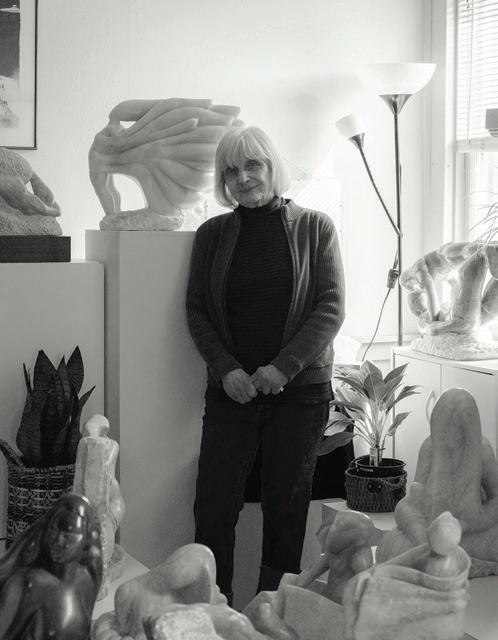
The show includes a bevy of small, paperweight-sized sculptures and a handful of larger works, all made out of various stones and all created over the course of the pandem-

ic. Her pieces are typically of female forms, depicted somewhere between abstraction and representation. They’re flowing, organic compositions—with long, windswept hair or in various states of repose. Sometimes the forms are intertwined with another body; sometimes they’re swimming or appear to be emerging half-formed from the stone. They are flawless in execution, polished to a glossy brilliance.
Hofmann, who was born in Green Bay, Wisconsin, reckons that she first became interested in sculpture at around three years of age. Her father, a stonecutter by trade, was also a duck hunter. He used to carve wooden
duck decoys in their basement, and Kay would watch him for hours. Though she wanted to try woodcarving herself, her parents told her she was too young and instead gave her sculpting clay. She sculpted everything in sight: likenesses of the neighborhood dogs, horses. Her father called these early works “her statues.”
After high school, in the early 50s, Hofmann attended the School of the Art Institute of Chicago, then a much di erent establishment than the corporatized environment it is today. Classes were held in a basement, she recalls, with no windows. But students and teachers alike were dedicated to their work. “I just thought everybody was a genius,” she says.
She then won a fellowship to spend a year in Paris at the Académie de la Grande Chaumière, where she studied under the sculptor Ossip Zadkine. Paris had not yet finished rebuilding after World War II, and Hofmann and her classmates would scour the city for material: chunks of buildings or stones. One day she happened upon workmen cutting down trees along the Champs-Élysées, and they were kind enough to cut her some pieces to take back to her studio. Moving, one of the pieces made out
of that tree, was on view in Hofmann’s first exhibition with PATRON in 2019. Standing 19 inches tall, the dark horse-chestnut piece shows a standing, full-bodied figure, one hand on their hip and the other raised to the side of their face. Moving is chunky and angular, the pose both tranquil and spirited.
Hofmann’s relationship with PATRON began in 2017; the backstory of their meeting seems both random and predestined. It all started on Craigslist, where Hofmann had listed some lucite display cubes for sale. It was December 2015, and she was in the process of trying to sell some property in Elmwood Park, where she had lived and worked for many years after being priced out of Chicago. There, she had her studio and a retail shop, named Forever Young, where she and her daughter sold collectible toys.
Mary Eleanor Wallace came to buy the display cubes for her retail project space, Tusk, which had opened in Logan Square in 2013. “She had mentioned to me that she had more of them if I was interested, but her sculptures were on them, and they were very heavy,”
Hofmann still works every day. “I think that’s what’s kept me young.”
By KERRY CARDOZA“Being and Becoming” is composed of works made during the pandemic. L: O. KRISTINA PEDERSEN; R: COURTESY PATRON
Through 5/27: Tue-Sat 11 AM-6 PM, PATRON, 1612 W. Chicago, patrongallery.com
Wallace says. “Of course that sparked my curiosity. . . . Like, she’s standing in her collectibles toy store in Elmwood Park. I can only imagine, what kind of work does this woman make? You know, what could this be, and it’s heavy?”
So Hofmann took Wallace into her studio, which was packed with dozens of sculptures of various sizes, displayed on platforms of different heights. “I was in awe, to say the least,” Wallace says. She was immediately drawn to the work and asked Hofmann that day if she’d be interested in showing some of her pieces at Tusk.

The two have since become dear friends, completing a StoryCorps interview for NPR in 2021. Wallace marvels at Hofmann’s generosity in sharing her work that day. “I think maybe we did have some instant connection or trust.
I think that I kind of identified with her pretty immediately,” Wallace says. “Just seeing how active she was made me want to try and celebrate and do whatever I could to share her work.”
Wallace displayed some of Hofmann’s sculptures in a corner of the store and posted images on Tusk’s Instagram, trying to drum up interest in the artist’s work. In the summer of 2016, Wallace installed a pop-up exhibition of Hofmann’s work, surprising her with an impromptu opening.
The display at Tusk is how local artist Mika Horibuchi discovered Hofmann’s work. She lived near Tusk at the time but hadn’t been inside until one day when she was passing by and saw Hofmann’s sculpture through the window. “I went in and I was like, ‘What the heck are these?’” Horibuchi says. She was struck by the work and Wallace helped the two connect for a studio visit. Horibuchi helps direct the Hyde Park artist-run gallery 4th Ward Project Space and was interested in organizing an exhibition of Hofmann’s work.
“Meeting her for the first time was totally astounding,” Horibuchi says. In those days, Hofmann’s dove Sweetie would keep her company in the studio, cooing from its perch. (Hofmann raised doves for many years, and the birds often make their way into her pieces.)
Horibuchi was drawn to Hofmann’s devotion to her work. “I guess it’s something that is immediately recognizable, this type of craft, this type of labor that you just don’t see anymore,” she says. “I think you could immediately see like an unimaginably long, lifelong practice built into one piece.”
Horibuchi says Hofmann’s show, in 2017, was one of her favorite exhibitions at 4WPS.
“She’s one of the purest artists I’ve ever met.”
Horibuchi’s enthusiasm for Hofmann intrigued her gallerists at PATRON; the gallery’s owner-directors, Julia Fischbach and Emanuel Aguilar, decided to visit Hofmann’s studio after seeing just one image of her work on an exhibition postcard. By that time, Hofmann had moved to the more a ordable Rockford, where she works out of her sunroom and her garage.
“When you sort of step into her universe, it’s kind of magical,” Fischbach says. “After we had conversed for a while and been standing in her studio area, I just said, ‘I don’t want to walk out of here without something.’” She bought a piece on the spot.
Hofmann works every day, whether it’s for an hour or a full day. She says her most productive period was probably after her divorce. (She was married for 23 years.) “All of a sudden being able to do what I wanted to do and having all the time in the world. I probably got more done in the ten years after that—larger pieces, more pieces,” she says.
Hofmann likes doing the work by hand, from carving the stone to polishing, even though it takes a toll on the body. Sometimes when she works, her hands turn purple. Still, besides a brief period when she worked with granite, she has shied away from using power tools. “There’s something that you can’t do with a pneumatic tool that you can do with your hands,” she says. “They just sort of blur over shapes.”
She doesn’t keep track of how long it takes to make a piece. She seldom sketches out an idea before starting to work, though she does a lot of drawing, sometimes drawing directly on the stone. Many of her stones she got raw from Europe or Colorado, where she used to teach occasionally at Blackhawk Mountain School of Art. She would hike out to the nearby stone quarries and pick out stones to ship back to Illinois. She preferred pieces that were dynamited out into raw pieces rather than cut into rectangles. “I could see myself inside the shape.”
That’s how the miniatures in her PATRON show came to be; they were sculpted from cast-off chunks of previous works that she collected for decades. The “minis,” or “chips,” as she calls them, sit on geometric-shaped bases, in the same or contrasting materials. They come from samples from her father’s stonecutting business, that he’d saved for her.
Hofmann often works on several pieces at a
time. As she was working on the minis, she’d line up a row of other pieces, so she could look at them and get ideas at the same time. She made about 75 of the small works during the pandemic; there are 19 on view at PATRON.
“When I’m doing these little chips, and I’m working on one, I’m ready to start the other one because I know what I’m going to do,” she says. “Sometimes before I polish the one, I’ll start another before I forget the idea. That’s why I keep saying I’m gonna live to 100; I need that extra time to do the rest of them.”
Looking back on her multidecade career, Hofmann is satisfied with what she’s accomplished, including her late-in-life renaissance and popularity with a younger generation of artists. She says she’s always done what she wanted to do, working supplemental jobs when she had to pay the bills but focusing on her art. “I like doing it. It’s physically hard, but I think that’s what’s kept me young. I enjoy having something come out of the stone.” v @booksnotboys
Chicago actor and community organizer Arti Ishak was tapped to audition for Hatefuck in 2020. They found the script exciting, like nothing they’d ever read. But the production was ultimately canceled in the wake of the pandemic, leaving Ishak determined to get this play up on a Chicago stage one way or another. Now it’s their directorial debut, and the play’s Chicago premiere as it finds a home at First Floor Theater.
Ishak’s first step to production was cold emailing playwright Rehana Lew Mirza, inspired by the script’s unapologetic portrayal of messy Muslims as full people—full of desire and nuance. In an interview with Ishak, they share, “It doesn’t put us on a radical binary where we’re very, very devout or we’re foreigners that are in need of saving.”
Hatefuck follows the ideological di erences (and burning desire) between novelist Imran and literature professor Layla. Imran folds anti-Muslim sentiments into his work as a potential subtextual critique, and Layla resists
the notion it’s necessary to peddle such tropes even in a publish-or-perish world. Chemistry and intrigue are palpable from the beginning, as Lew Mirza’s writing gifts audiences with hot quips in her yearnworthy two-hander.
Actors Aila Ayilam Peck (Layla) and Faiz Siddique (Imran) are inspired by a text that allows them the space to play characters who are so refreshing and complicated.

Siddique says, “Seeing the name of a Brown playwright, I was excited. But even subconsciously I was like, ‘Oh, I’m probably going to be an interpreter.’” To his surprise, what he found instead was an opportunity to explore what it means to be a main character in every sense. Imran’s thoughts on Muslim representation are as provocative as the play’s title, and yet there is an undeniable chemistry between him and Layla that allows for candid, vulnerable conversations on Muslimhood and representation.
Siddique was on a premed track in undergrad and didn’t seriously consider the arts
as a career pathway, knowing roles like this were few and far between. He was also navigating the expectations of growing up in an immigrant household. He took acting classes on the side of his studies, until he realized this was the work he truly wanted to pursue. With Hatefuck, he calls the overall rehearsal process, “nothing short of a masterclass being opposite Aila and directed by Arti.”
Ayilam Peck notes, “We have a lot of stories in contemporary theater about being the child of immigrants, but so few about how those children actually engage with the world.” She grew up in Indonesia and Singapore before being, as she jokes, “imported” to the United States. Even after attending international schools, she found the transition to America a “cruel awakening” when considering the lore of the “melting pot.” For Ayilam Peck, her career has overwhelmingly included performing in classics. She says she loves doing these plays but it can be exhausting “inserting your own narrative into something that inherently doesn’t actually reflect your story.” This also leaves certain skill gaps in her resume. “I have never been cast as a sexy person. That means I have never done intimacy on stage and I’ve been in the industry over ten years now. My career has been playing the innocent, prudish types. People see ‘Brown girl’ and think nosein-a-book type of person.”
As the title suggests, Hatefuck includes bountiful moments of intimacy that require a level of boundaries and trust. As director Ishak a rms, “Part of my directing philosophy
HATEFUCK
5/5-6/ 10: Thu-Sat 8 PM, Sun 3 PM; also Mon 5/22 and 6/58 PM (industry nights), Wed 5/31 8 PM (understudy performance), and Sat 6/ 10 3 PM; Den Theatre, 1331 N. Milwaukee, firstfloortheater.com, previews (5/55/ 10) $ 0 -$20, regular run 5/ 11-6/ 10 $0 -$ 35 (limited free tickets available each performance)
is to have an actor-centered room.” For them, this means they’re “creating a container in which we tap in and out of the work mentally, physically, and emotionally in a way that prioritizes safety.” Samantha Kaufman serves as the fight and intimacy director, helping build a rehearsal culture where actors have agency over their bodies. Ishak continues, “I can’t deny that there is an inherent hierarchy in this room, and that being the director, you sit at the top of it, but I can acknowledge that con-
sistently. I can try and create a space where other people feel like they can push back and ask questions.”
On a similar note of pushing the theater field to do better, Hatefuck o ers an opportunity to build upon a growing canon of SWANA stories that reject the stereotypes that plague our narratives. We’re in a moment of reclamation that includes intergenerational healing and an unapologetic embracing of queerness and sexuality. Historically, we see a generalization of culture, where the nuance of lived experience across Southwest Asia and North Africa are lost to orientalism or even brownface—as we still contend with a pattern of casting SWANA actors beyond their own cultures.
Part of what makes playwright Lew Mirza’s work dramaturgically compelling is the ability for any SWANA actor to bring their own cultural background into the script. Sometimes, when reading plays, she’s found the lack of specificity around terms like “person of color” or “Muslim” too open-ended, a “burden that could fall on actors to fully flesh out.” Lew Mirza aims to be as specific as possible in her scripts but “allows for those specific changes, if necessary.” Here she hopes it eliminates the need for the actor to “create the character and be sort of amorphous.”
Ishak says their directorial debut has been “absolutely a dream come true.” Although Ishak’s directorial prowess could be seen in Director’s Haven 6 and in the music video “Shukran Bas,” this is their first full-length theatrical production. They are grateful to the SWANA community and allies for believing in them and this work. Through the cultural collective SWANASA Central, Ishak produced a reading of Hatefuck along with cultural organizers Rom Barkhordar and Tina El Gamal in May 2022 as a part of Steppenwolf’s multidisciplinary performance series, LookOut.
Accompanying Hatefuck’s Chicago premiere is a slew of programming featuring food popups with Chef Thom Padanilam of Thommy’s Toddy Shop, opportunities to discuss the rehearsal process with the team, and conversations on the themes of the play. Hatefuck signals another expansion of the stories told by, for, and about SWANA and Muslim people with Lew Mirza’s provocative question: “Can you hatefuck someone into a different person?” v
@YasminZacaria























Helen Lee curates a program of dance at the MCA on May 7 for APIDA Arts Festival.
 KRISTIE KAHNS
KRISTIE KAHNS
Scanning the three-day offerings of the APIDA Arts Festival, held May 5-7, one of the first things I notice is the array of ages, ethnicities, and mediums on display. Veteran of the Chicago music scene and filmmaker Tatsu Aoki is present on Saturday morning at the Goodman Theatre for Tea and Talk, where visitors can meet and mingle with creatives. On Friday, teen glassblower Tiberius Geisen’s glass sculpture will be on display in the same space (the Chicago Cultural Center) where Rika Lin and Shalaka Kulkarni perform dances for festivalgoers. The performers and artists celebrated are sculptors, dramatists, writers, musicians, comedians, and chefs. They claim heritage from all over the Asian continent, from south to central to east Asia.
When I ask executive director Mia Park about how she achieved all this, I’m also paying a compliment. Initially, I was neutral, if not slightly skeptical, about the festival—in my experience, it’s easy for an event to call itself groundbreaking and inclusive while in actuality featuring a siloed, cliquish group. Asian arts initiatives tend to focus solely on East Asian people, or neglect aspects of the Asian
American experience like queerness, class, or colorism. One look at the APIDA Arts Fest lineup and my skepticism was replaced by an impression of genuine desire to show as much of the tapestry of Asian American life as it can. But in answering my question, Park responds by talking about failure; she wishes she could have had more elderly and more high school and college-age artists, as well as more Pacific Islander and Central Asian ones. She tells me about the extensive research her team did to try to reach out to underrepresented communities, even sending press releases to Chicago tiki bars. “I don’t want to risk feeling tokenistic,” she muses. “This festival is really trying to promote our mission statement: to amplify and unify.”
Park’s answer is a testament to just how seriously the APIDA Arts Festival takes its pluripotency. The first festival of its kind in the midwest, it o ers a veritable smorgasbord of options for all kinds of Chicagoans to experience. Take, for example, Eileen Doan, who will be showcasing her sometimes anthemic, other times crooning folk-pop songs on Saturday at the Goodman. Doan, who uses she/he pronouns, tells me that he feels “very connected with everyone in the festival even though we’re doing very different things.” Not only will Doan be contributing her talents musically to the festival, but she will lend his dramatic talents as well to readings of plays later in the festival. “We’re all gathering to celebrate this arts festival for the first time, specifically for Asian creatives in the city.” Rapturous, she calls the festival a “wonderful and beautiful and amazing celebration of Asian creativity.”
Korean American visual artist Katie Chung echoes a similar sentiment. “It’s the first time someone’s taking initiative to have an Asian American arts festival here, so I thought, ‘What a rare opportunity to see the whole
APIDA ARTS FESTIVAL
5/5-5/7: events at Claudia Cassidy Theatre at Chicago Cultural Center, 78 E. Washington; Alice B. Rapoport Center for Education and Engagement, Goodman Theatre, 170 N. Dearborn; Museum of Contemporary Art, 220 E. Chicago; complete schedule at apidaarts.org; free and all ages
community in the same room on the same weekend.’” In the past, Chung has made textile-based art that called to her experience as a second-generation Korean American and the child of dry-cleaner parents. But at APIDA, Chung is debuting a new exploration of her personal story: a wearable art object that uses tags collected from her parents’ store and which incorporates aspects of a hanbok, or traditional Korean garment.
I ask if this project has produced some new realization in her continued inquiry into Korean Americanness. She replies that the piece for APIDA fest has exposed her to other traditional Korean culture, but also that it’s widened her sense of community as well. “I’m just meeting more people in person and virtually; it’s opening my idea of Korean Americanism and how it’s whatever I want it to be.”
The result of that expansion is that Chung has found she “grew up always being told, ‘You’re not Korean enough; you’re not American enough,’ but now I’m in this gray area. This is who I am.”
Just as her new piece traverses the boundary between public and private, something that grazes the skin intimately while being made out of material not traditionally seen as wearable in the public eye, the experience of making the piece seems also to have threaded the outside and inside world of the artist. Driving this point home is the title of the piece: Kyung Mi. I ask her about the provenance of the name, and Chung replies, “I chose to name it this because it’s my mom’s first name. She’s worked and owned [her dry cleaner’s] for over 30 years, and everyone calls her Chung, which is my father’s last name. Because people can’t pronounce her [first] name and I wanted this to be an homage to her.” Through work like Chung’s, APIDA Arts Festival invites us to consider not just the outward-facing aspects of Asian Americana but the intimate, internal ones as well.
Speaking of internal experiences, something I noticed immediately in the festival lineup was the inclusion not just of sight, sound, and touch, but also taste. On the third day, held at the MCA, APIDA Arts Festival has invited chef Margaret Pak of the much-lauded Thattu to share her gustatory talents with festivalgoers. On the weekend menu is a Kerala fried chicken sandwich, naked-fried in rice flour and served with a curry leaf aioli on brioche, as well as Pak’s playful take on tater tots, tossed in chaat masala, a funky, sweet-sour-salty spice blend used in South Asian cuisine. Pak recalls when Mia Park came to eat her food when Thattu
was still a pop-up: “She was very excited.” The invitation to be a part of APIDA Arts Festival came shortly after. “I remember asking her what does the acronym stand for and what the art fest encompasses. It was more than food and performance art and live music and bands and variety shows. The more she described it, the more it was confirmation that I’d love to be part of it and would love to share my Kerala cuisine with her.”
When I ask how Pak views her food as being in conversation with the art at the festival, she thinks for a moment and tells me, “I’ll be honest, I was a little surprised, because I do typically feel [art] is something you should touch. And then I quickly realized I have a fried chicken sandwich we eat with our hands. Like Indian traditional food, it’s very sensory.” She goes on to tell me that she believes her food invokes a feeling of comfort. On one level, this is purely physical—we’re talking about a fried chicken sandwich, after all. But it’s also a comfort of the spirit.
Pak’s introduction to Kerala food was through her husband, Vinot, to whom she’s been married for 18 years. It was through his cooking and their love that she found herself falling not just for Vinot but for Kerala food as well. Fast-forward a few years and now she’s sharing that feeling of finding home in a dish and in a person with restaurantgoers and festivalgoers alike. Her culinary ode isn’t just a one-way street, either; Pak tells me about a group of Indian aunties who visited Thattu and asked if she was roasting her coriander. “Once I started roasting the coriander, it really brought out the earthiness of this coriander chicken. Now there are layers of Vinot growing up on this food, then me adding my touch, and now my Indian auntie customers-turned-friends. I kind of love that about some of our dishes.”
With so much to choose from, what does Park hope that people walk away with after experiencing the whirlwind tapestry of APIDA Arts Festival? Her answer is immediate: “I hope they find some kind of wholeness in being part of this festival, whether they’re allies, whether they’re APIDA or not demographically.” Her final words are resounding, triumphant, almost a proclamation: “I just know if I’m confident in my community, it will make the community feel whole and complete. Then people experiencing our art will also take away this feeling, this feeling of wholeness and complete[ness].” v
by
Supported in part by the National Endowment for the Arts

CONCEIVED & ADAPTED BY LEE BREUER
MUSIC COMPOSED BY BOB TELSON
DIRECTED BY MARK J.P. HOOD and CHARLES NEWELL
WITH ASSOCIATE DIRECTOR TARON PATTON
BY JAMES GOLDMANDIRECTED BY RON OJ PARSON
BY SOPHOCLESDIRECTED BY GABRIELLE
BY TOM STOPPARDDIRECTED BY CHARLES NEWELL
WORLD PREMIERE BY NAMBI E. KELLEY
DIRECTED BY TASIA A. JONES
Big River rolls on at Mercury Theater Chicago.
The dramaturgy displays alone for Mercury Theater Chicago’s Big River, based on Adventures of Huckleberry Finn, taught me more about Mark Twain’s 1830s-set, biting antislavery novel than I learned from studying the book in junior high, high school, undergrad, and grad school combined. First off, the musical (music and lyrics by Roger Miller, book by William Hauptman) is as much about Jim (Curtis Bannister) as it is about Huck (Eric Amundson). And Jim, as nobody taught me in several decades of English lit courses, was inspired by a real person: Daniel Quarles, an enslaved man Twain befriended when the author was a child.
At the start of Big River—which picks up just a er the close of The Adventures of Tom Sawyer—Huck is in grave danger of becoming a shi less, illiterate ne’erdo-well, according to the good Christian ladies who have taken him in. Huck’s evolution from schoolboy truant to full criminal by helping Jim escape shows in no uncertain, if deeply satirical, terms just who the real sinners were.
Directed by Christopher Chase Carter with Malcolm Ruhl’s signature superior musical direction, Big River is anchored by the empathy-inducing and alternately wrenching and humorous leads.
plead against Mo’s destructive impulse.
last fall) as producer Julia Budder also stood out. Nat Kier comes close to stealing the show as kleptomaniac Frank Finger when, pants pulled down, he stands on a bed filled with coats and recites a demented monologue about his impostor syndrome. —MATT SIMONETTE IT’S ONLY A PLAY Through 5/21: Fri-Sat 7:30 PM, Sun 2 PM, Saint Bonaventure, 1625 W. Diversey, 773404-7922, saintsebastianplayers.org, $30 (seniors, students, and children under 12 $25)
The Language Archive redefines the meaning of love language.
Romantic comedies depend on miscommunication. It’s why we love them. It’s comforting to see that everyone stumbles over their words. Our greatest tool for self-expression o en mutates into its most frustrating obstruction. AstonRep Theatre Company’s The Language Archive, a comic-drama written by Julia Cho and directed by Dana Anderson, plays on this ironic tension through a linguist who can’t fathom how to express love.
George (Sean William Kelly) never says the right thing. He devotes his entire life to language but bottles up his words when confronted by emotion. His linguistic impasse stirs up major issues in his marriage to Mary (Erin O’Brien), who communicates her sadness by hiding notes for George. A er her futile appeal to revive their marriage, Mary leaves him.
Carter has also aptly emphasized an indelible scene where we see an enslaved family brutally ripped apart, the anguish on stage a tableau not unlike the one displayed at Springfield’s Abraham Lincoln Presidential Museum and Library. It’s a scene that puts the score’s catchy, twangy folk melodies and soaring harmonies (Bannister and Amundson make music bound for glory on “River in the Rain” and “Muddy Water”) in context. Twain was a master at naming and condemning the evil built right into the laws of the U.S. of A. One wishes he were still writing today.
If This Is The End is chaos. More o en than not, the performers handle this frenzy harmoniously, but sadly, the play’s pacing never stabilizes. Scenes pass too quickly to reach their full potential, resulting in disjointed leaps that dilute the script’s promise. That said, the ensemble executes their roles with compelling precision, especially Rasmussen, who reimagines the moon as a jaded antihero. All in all, this dystopic sci-fi fairy tale delivers a touching ode to our planet that shouldn’t be ignored.
—CATEY SULLIVAN BIG RIVERThrough 6/11: Wed-Fri 7:30 PM, Sat 3 and 7:30 PM, Sun 3 PM; Mercury Theater Chicago, 3745 N. Southport, 773-360-7365, mercurytheaterchicago. com, $39-$85
Sentimental environmental devotion marks Theatre L’Acadie’s If This Is The End.
Environmental peril is the norm. News streams whisper about the climate crisis, relentlessly broadcasting the planet’s daunting existential threat. However, nothing seems to change. Kids, born into environmental defeatism, struggle to rekindle hope as the world yells out in pain. So Theatre L’Acadie’s If This Is The End, written by Melanie Coffey and directed by Brandii Champagne, imagines that Earth’s savior is its most loyal companion: the Moon. Unfortunately, the Moon intends to save the Earth, not the people destroying it.
Keeley (Audrey Ney), a burnt-out scientist, confides everything in the moon. Since childhood, she’s found refuge under the night sky, discussing fears and aspirations with the celestial body. But one day, the moon falls from the sky, stopping the tides and violently shi ing Earth off axis. Mo, the anthropomorphic Moon played by Logan UhiwaiO’Alohamailani Rasmussen, abandons her home among the stars to save Earth—at any cost. Confronted by an apocalypse, Keeley and her friend Francis (Kira Nutter) reflect on what matters as they
—MAXWELL RABB IF THIS IS THE END Through 5/7: Wed-Sat 8 PM, Sun 2 PM; Facility Theatre, 1138 N. California, theatrelacadie.com, $15$20 suggested donation
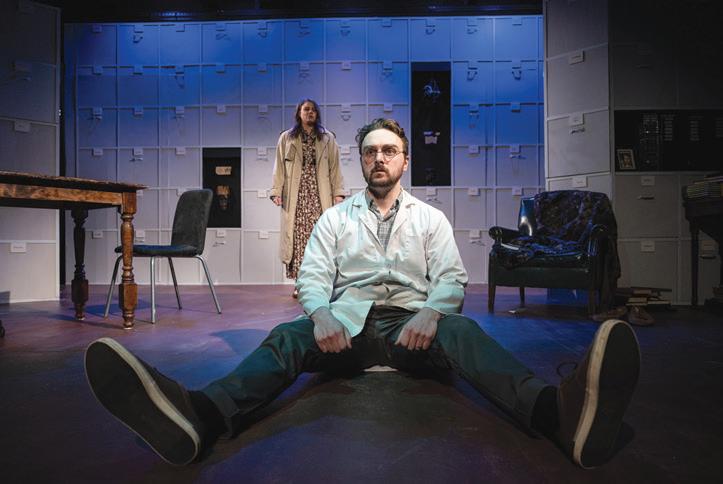
Retail workers sing the blues in In the Back/On the Floor
If verisimilitude and timeliness were all it took to create a great play, Ken Green’s world premiere comedy-drama about working in big-box retail would be a home run. Its dialogue captures every cliche and bit of doublespeak in the corporate human resources dictionary, not to mention every grouse and plaint ever uttered in a workplace—and Stage Le chose to open it just before International Workers’ Day. Under Rachel Van’s direction, its cast members form a tight ensemble (and is this not the highest praise for any Chicago theatrical effort?), with the occasional breakout performance when actors playing workers reappear as obnoxious customers. A training “video,” enacted by Ashley-Marie Chávez and Loredan Krug downstage, punctuates the work scenes and offers the best showcase for the playwright’s ridicule of company cant. (“We’re a family,” “Your work provides freedom”—“Arbeit Macht Frei,” anyone?)
But spending 90 minutes or so with complaining coworkers is something we all need to get paid for, and once the piece devolves into agitprop about unionizing, it abandons both characters and plot to hammer home the theme. It also ends with a whimper rather than a Norma Rae bang, one scene too late. When the
training-video spokespeople break character to reveal themselves as actors rather than real employees, they plume themselves on their superior working conditions and observe, “That’s why we’re members of the actors’ union.” The play should end right there but doesn’t. Still, it’s in keeping with Stage Le ’s socially conscious mission and with the zeitgeist in which people are returning to the understanding of unions as a defense against the indefensible. —KELLY KLEIMAN IN THE BACK/ON THE FLOOR Through 5/28: Thu-Sat 8 PM, Sun 2 PM; Chicago Dramatists, 1105 W. Chicago, 773-883-8830, stagelefttheatre.com, $30-$40
It’s Only a Play offers genuine backstage laughs.
I’m generally not a huge fan of material wherein creative folk in any discipline—theater, film, publishing, music—turn to their own profession for inspiration. If a movie is about filmmaking, or a novel is about a tortured novelist, or a singer crows about how hard life is on the road, I check out pretty quickly. So I was quite pleased and surprised by how relentlessly the genuine laughs flowed in Saint Sebastian Players’s mounting of Terrence McNally’s It’s Only a Play and how engaging the story ultimately was.
Centering on a group of theater folks directly and tangentially involved with the opening night of the long-awaited drama The Golden Egg as they wait for “the reviews”—meaning the New York Times review—to come in, It’s Only a Play presents some hard-bitten folks ultimately questioning why they’ve masochistically ridden the show business roller coaster for so many years.
The script too o en falls back on name-dropping for comic effect, and sometimes it feels like none of the characters are edging toward a specific story beat, but Robert-Eric West’s direction makes up for it by keeping things going at a fast clip. Melinda “MJ” Deamon is a hoot as hot-mess actress Virginia Noyes. Danne W. Taylor as disgruntled critic Ira Drew and Valerie Gerlock (a favorite of mine in Saint Sebastian’s Boeing-Boeing
Unfortunately for George, his work life is troubled by a verbal deadlock similar to his marriage. He and his assistant Emma (Aja Alcazar), who secretly loves George, hope to preserve a language nearing extinction. The linguists previously documented small clips of the language but now have a chance to record a conversation with Alta (Génesis Sánchez) and Resten (Jorge Salas). But this couple is too embroiled in petty conflict to speak their language, so they defer to English—or as they call it, the language of anger.
The Language Archive delivers a dynamic, touching chronicle that braids together linguistics and love, despite its contrived premise. AstonRep’s final production is packed with thrilling performances, especially from Sánchez and Salas, and though it’s not a traditional rom-com, it’s just as heart-stirring. —MAXWELL RABB THE LANGUAGE ARCHIVE Through 5/28: Thu-Sat 7:30 PM, Sun 3 PM, The Edge Off Broadway, 1133 W. Catalpa, 73) 828-9129, astonrep.com, $20
Panther Women is a choreopoem for the Black liberation movement.
India Nicole Burton’s Panther Women: An Army for the Liberation has already played at Cleveland Public Theatre and Indianapolis’s Phoenix Theatre as part of the National New Play Network’s rolling world premiere program. But it’s hard to imagine a more apt setting for Burton’s choreopoem in celebration of the women in the Black Panther Party than the South Shore storefront now housing its Chicago premiere. A coproduction of Perceptions Theatre and NNPN member Prop Thtr, it’s an intimate and bare-bones staging—but lacks nothing in passion and insight. The room where it happens bursts forth with all the love, joy, anger, pain, and urgency of the mothers of the revolution, thanks to Perceptions founder Myesha-Tiara’s sharp direction, Deja Hood’s visceral yet graceful choreography, and the performances by the blistering ensemble of seven actors.
The show primarily focuses on three women in the Panthers: Angela Davis, Elaine Brown, and Assata Shak-
ur. But their origin stories, while unfolding in different parts of the U.S. (Birmingham, Alabama; Philadelphia; North Carolina) share a common thread of young women determined early on to make a difference for themselves and their people.

Along the way, Burton’s script takes a sharp look at state-sanctioned violence against Black Americans, as well as the misogyny Panther women experienced both outside and inside the movement. The framing device is that they are the voices of the past, helping a contemporary woman out of isolating despair and into a sense of reconnection with herself and her community. Mari DeOle’s set puts us right in the middle of the action, with reproductions of Panther posters and news clippings on the wall giving us the sense of having just walked into a meeting where the women, fed up with being objects of scorn or pity (“What can a Black woman do with pity?” the ensemble asks), have taken charge of their past narratives and the future. It’s a raw, intense, smart, and exhilarating journey. —KERRY REID PANTHER WOMEN: AN ARMY FOR THE LIBERATION
Through 5/27: Thu-Sat 7:30 PM, Sun 2 PM; 1825 E. 79th St., perceptionstheatre.org, pay what you can ($20 suggested donation)


Otherworld’s Trade Federation combines homage and satire.
Pay no attention to the show’s baggy, forgettable, mildly pompous title. This smart, tightly written play is at once a very funny satire of the Star Wars saga—and Star Wars
fans—a heartfelt homage, and fabulous fan fiction. Set not so long ago in a galaxy not so far away (OK, the setting is contemporary Hollywood), Trade Federation tells the story of an obsessed writer trying to pitch a god-awful script idea for a new Star Wars movie to George Lucas. His idea? A very talky, nearly actionless story building on the idea that the three prequel Star Wars movies (The Phantom Menace, Attack of the Clones, and Revenge of the Sith) can be interpreted as an allegory, critiquing globalization and the International Monetary Fund.
Happily, the comedy that playwright Andy Boyd spins from this premise is far from actionless. Boyd cuts between real-life scenes in the life of Boyd’s sad-sack protagonist (including a pitch meeting with a polite but increasingly exasperated Lucas) and terrible sample scenes from his screenplay. The production, under the direction of Blake Hood, is at times rough, the acting unpolished, the costumes cheap, and the fight scenes and special effects bare-bones. But Boyd’s material is strong, and the whole show has an appealing storefront theater energy to it. It helps that Joe Castinado’s sound design is pitch-perfect. And some of the acting is terrific. Trey Plutnicki, in particular, brings a hilarious, loony intensity to his performance as the earnest but very deluded wannabe screenwriter.
—JACK HELBIG TRADE FEDERATION
OR, LET’S EXPLORE GLOBALIZATION THROUGH THE STAR WARS PREQUELS Through 5/13: Fri-Sat 7 PM, Sun 2 PM; also Thu May 4, 7 PM; Otherworld Theatre, 3914 N. Clark, otherworldtheatre.org, $10-$20 v

torment of Laura Danker (a memorable Isol Young)—that one girl in school who got boobs and height long before any of her peers, boy or girl—is almost excruciating.
Like the book, Margaret the movie is sunny and, ultimately, optimistic. Coming of age is never without trauma, but in Margaret’s case, there are mostly supportive (or trying to be, at least) parents and a godsend of a grandmother (Kathy Bates) to smooth the path.
The film adaptation reflects some of the book’s later adjustments: It’s still set in the 1970s, but Margaret practices getting her period with adhesive pads rather than the elastic waist-to-crotch belt-like contraptions where pads the size of small bricks were threaded through loops under your belly button and over your rear end, an apparatus that made a target out of anyone trying to menstruate in anything like a gym uniform. Or, for that matter, a pair of pants. Margaret’s mother (Rachel McAdams) is more fleshed out as an artist, stifled by the family’s move from New York City to the New Jersey suburbs.
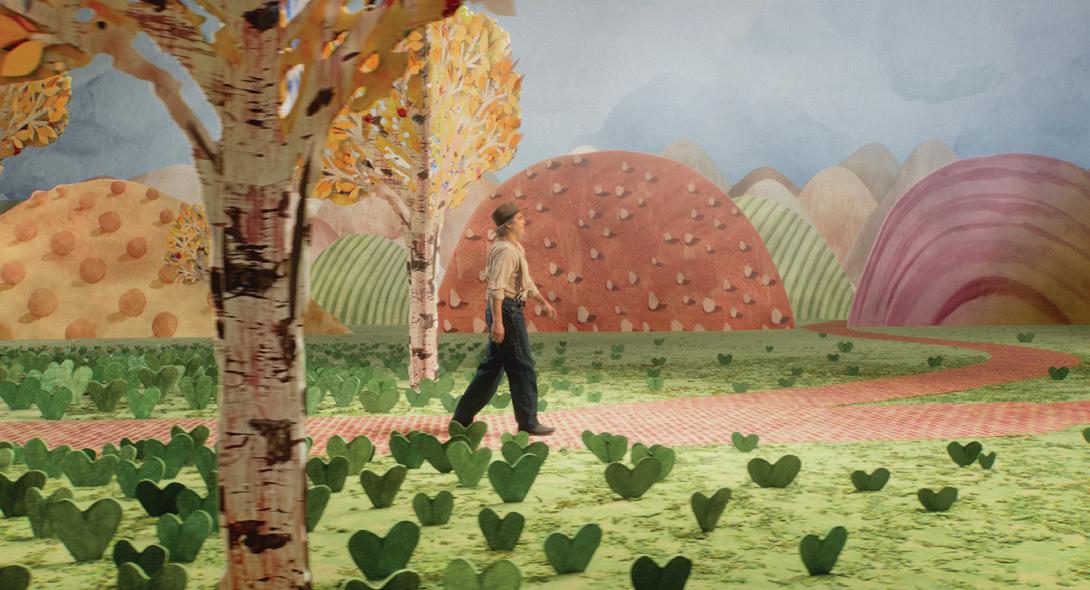
Writer/director Firas Khoury’s Alam is an affecting and effective film firmly fixated on contradictions and how we navigate them to create a sense of self.
Tamer (Mahmood Bakri) and his friends Shekel (Mohammad Karaki) and Rida (Ahmad Zaghmouri) are Arab high school students living a middle-class life in a village in Israel. This contradiction is ever-present for the young Israeli-Arabs, inundated with daily reminders of past trauma still fresh in living memory. They navigate the present system, which purposefully limits their prospects, while protest movements and acts of political violence swirl around them. Forced in school to idly sit through lesson plans commemorating the anniversary of Israeli Independence Day—lessons ignoring the simultaneous anniversary of the Palestinian day of mourning over the loss of their homeland—Tamer and company are recruited by their classmate Safwat (Muhammad Abed Elrahman) and the attractive new girl Maysaá (Sereen Khass) into an act of political protest. It forces Tamer to quickly come to terms with reaching adulthood in a society where daily life is fraught with social and political consequence.
As we spend more time with our protagonists in the buildup to their life-changing act of protest, we’re given slice-of-life glimpses of the various male characters in the village who serve as visions of possible futures for the friend group—Tamer’s work-focused and
apolitical father who urges him to avoid the ongoing protest movements, his mentally ill uncle who suffered severely in an Israeli jail, the local activist who pushes the neighborhood youth to learn their history and fight back, and even the neighborhood drug dealer who lives with his elderly mother—none of whom feels like a fully attractive option.
The film is shot in a naturalistic style, making the excellent choice to o en linger on the face of Tamer as he expressively processes the world around him. Tonally, Khoury’s dialogue is perfectly pitched for Tamer and his friends, rapidly shi ing between their youthful focus on the activities that one would expect from teenage boys with unclear prospects—girls, drinking, social media, how to find weed, and how to make it through high school without trying much and without getting expelled for racking up minor infractions—and the tough realities of the environment they live in.
Alam is a brilliantly devastating coming-of-age story, one of comedy, confusion, and sorrow that thoroughly captures the sense of misguided teenage bravado mixed with genuine awkwardness and anxiety about finding a place in the world. It raises the stakes beyond the mundane and gives us insight into a world so rarely seen on American movie screens. —ADAM MULLINS-KHATIB 109 min. Gene Siskel Film Center
People have been condemning and praising Judy
Blume’s 1970 young adult classic Are You There God?
It’s Me, Margaret. since its publication. By the time I got my hands on it in 1971 (I was 11), it was already being targeted for banning, even as its popularity soared and Hollywood first started sniffing around for movie rights.
It’s taken the ensuing decades for Blume to agree to an adaptation. And despite the presence of a winning mainstream movie, the multigenerational best-selling book remains in the crosshairs of those who—like those ad makers who depicted menstruation as a delicate Windex-blue waterfall trickling delicately onto a snow-white sanitary pad—think periods are gross and shameful. As my mother used to tell me, if men bled from their penises every month while feeling like someone was taking a pitchfork to their internal reproductive area, you better believe there’d be more public light on the subject.
Like the book, the Lionsgate movie offers a gently informative, o en hilarious, and always empathetic depiction of a sixth grader yearning for, getting, and celebrating her first period. With an astonishingly effective Abby Ryder Fortson as Margaret in an adaptation by Blume and Kelly Fremon Craig (Craig also directs), the 1970s-set movie captures all the warmth, joy, and turmoil of the book.
Watching a prepubescent, never-been-kissed preteen playing “Two Minutes in the Closet” with her grade’s self-styled player is at once horrifying, hilarious, and eminently familiar. Watching Margaret navigate the mean girls who dra her into their supersecret club is the same (bras required, socks banned). The junior high
Margaret’s journey, as in the book, ends with celebration. Would that the advent of all periods were treated as such. It’s time for a sequel. I’m thinking something along the lines of What the Fuck, God? Menopause?
PS Watch for Katherine Mallen Kupferer as Margaret’s friend Gretchen. Fun fact, Mallen Kupferer is the daughter of Tara Mallen, founder and artistic director of Chicago’s Rivendell Theatre, and Keith Kupferer, one of the best ensemble actors Chicago has seen in the past 25 years. —CATEY SULLIVAN PG-13, 105 min. Wide release in theaters
Ari Aster is unrestrained. Beau is Afraid demonstrates to audiences that the Hereditary and Midsommar director previously held back the full scale of his surrealist inclinations. And that’s a tough pill to swallow. Aster’s third feature film amplifies the frenetic and horrific themes that defined his first two films. Beau Is Afraid emerges as a purposefully jumbled whirl wheel of paranoia, mommy issues, and hostility that haunt Beau Wassermann, the disquieted protagonist played by Joaquin Phoenix.
Beau is undeniably afraid. And Aster ensures we understand why. He is a mild-mannered loner, traversing a world where everyone fosters an incorrigible hostility. Around him, the world constantly unravels into unbridled chaos, but this relentless antagonism pales in comparison to Beau’s greatest fear: disappointing his mother, Mona Wassermann, who Patti LuPone plays with spine-chilling coldness. Once Beau misses his flight, we hear Mona’s voice for the first time, spilling an all-too-
familiar guilt trip that propels Beau into an odyssey of cruel bewilderment. Beau’s anxious hero’s journey to his mother’s house is indulgently defiled by Aster as he encounters disturbingly cartoonish dilemmas one a er another. Trapped by a suburban family treating his wounds or mesmerized by a play performed by a troupe living in the forest, Beau finds that his anxieties are confirmed as even the nicest characters reveal an inner malevolence.
Aster honors the surrealist tradition, adopting storytelling techniques that rely on “irrational knowledge.” His film is packed with marvelous supporting performances, including Nathan Lane as a deceitful suburban dad and Parker Posey as Elaine Bray, Beau’s estranged childhood love. Unfortunately, Beau Is Afraid’s paranoiac surrealism mutates from its most enticing feature into its greatest shortcoming during its three-hour runtime. That said, it’s clear that Aster is experimenting with his artistic vision, and it’s likely to produce excellence another time. —MAXWELL RABB R, 179 min. Wide release in theaters





If ever there was a case to be made for not being a parent’s favorite child, Everything Went Fine makes it. Novelist Emmanuèle (Sophie Marceau) is living her life when she receives news that her father André (André Dussollier) has had a stroke, and the prognosis is bleak. When André recovers enough to talk with Emmanuèle about it, he says, “I want you to help me end it.”
Thus begins French screenwriter and director François Ozon’s almost procedural treatment of ending a life by choice. (That’s a relief, because I hazard to guess that an American filmmaker would dive into the moral implications.)

Ozon doesn’t express a particular point of view— that is, of being a family member’s personal Jack Kevorkian—but instead focuses on the tedium of finding a way to carry out the plan and of wading through the bureaucracy and legal snafus that follow. The emotional toll results from those actions, not the act itself.



Emmanuèle does feel, of course, but she’s more concerned with honoring her father. For example, when someone asks how she can aid in her father’s death, she replies, “It’s hard to refuse him.”
Marceau is exceptional as the daughter carrying the weight of her father’s wish, and Géraldine Pailhas matches her as Pascale, the second-favorite child, who views the action as an unusual, if difficult, gi . Always present even when he’s not onscreen is Dussollier, who makes an irascible old bastard such as André strangely endearing. Everything Went Fine is well made without being entertaining—though entertainment doesn’t seem to be its goal—and it will reward patient audiences who appreciate a deliberate march toward an inevitable conclusion. In French with English subtitles. —DAVID RIEDEL 113 min. Limited release in theaters
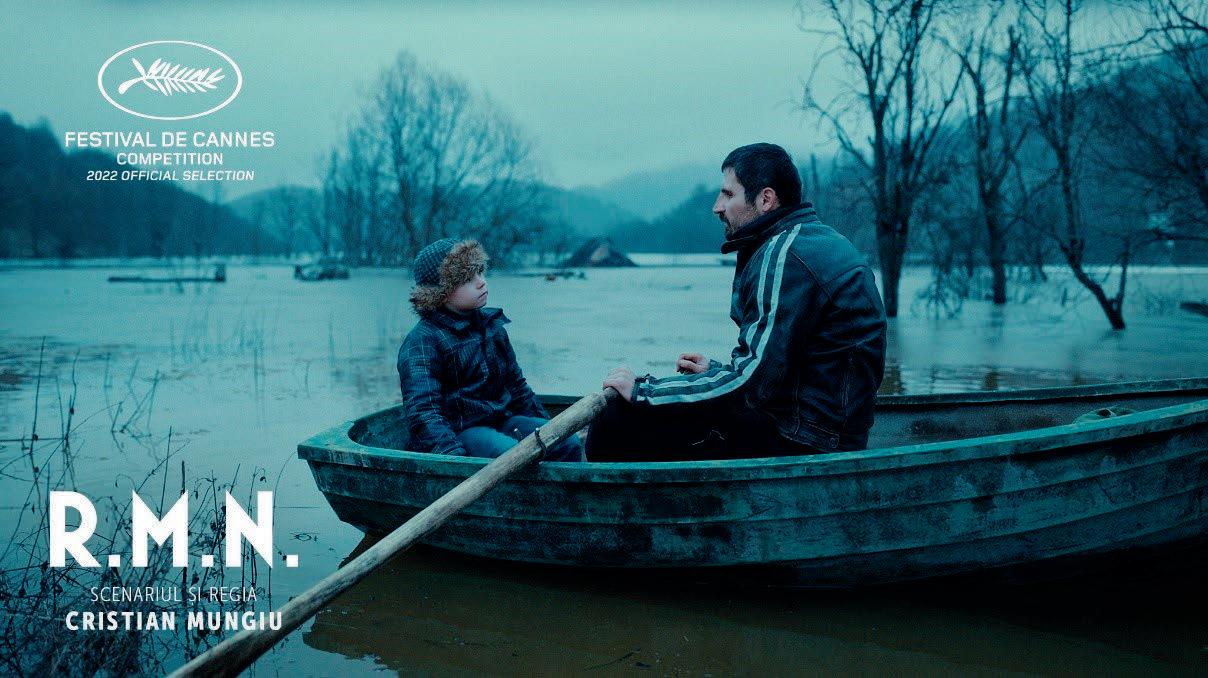
There are three kinds of movies in the four-decadestrong Evil Dead horror franchise: scary, silly, and medieval. Lee Cronin’s newest entry, Evil Dead Rise, opts for scary, eventually settling into a marathon of drawn-out-gore set pieces that test one’s willpower to keep their eyes on the screen. While the bloodshed is as foul as any longtime fan could hope for, something feels off this time around. The first sequel in a full decade, this should feel like getting an Evil Dead reunion, but instead it’s more akin to a so-so tribute band. We get a change of venue from run-down cabin to run-down high-rise, plenty of clever camera tricks to spice up the kills, and
a whole new story about a family’s bonds being tested under duress both mundane and demonic, but it’s no substitute for the real thing.
Cronin takes his tonal cues from Fede Alvarez’s more grim 2013 reboot rather than the slapstick frenzy of Sam Raimi’s original trilogy, but it’s missing the personality and sense of cohesion of either director’s vision. Take out the wink-nudge callbacks and the iconic first-person POV shots pioneered by Raimi, and this could pass for a minor Blumhouse movie instead of a descendant of splatter film royalty. Even still, once the film is done going through the motions of half-hearted exposition and those ancient Sumerian demons finally start getting rowdy, the blood starts flowing and really, really doesn’t stop. Cronin litters the otherwise dry first half hour with lingering shots of potentially hazardous items and appliances around this family’s apartment, and all promises of horrifying violence and misused kitchen implements are kept. At my press screening, all attendees were given miniature toy cheese graters and candy pasta labeled “mom’s leguini” before the movie, a pun that clicked with me all at once when Chekhov’s cheese grater is put to use in one particularly excruciating moment mid-movie. Uneven it may be, but there’s no denying this is a movie that generously delivers on leguini. —JOEY SHAPIRO R, 97 min. Wide release in theaters
Judy Blume Forever contextualizes a lifetime destined to be a legacy. More than just a bonus to the recent feature-length adaptation of Blume’s widely celebrated Are You There God? It’s Me, Margaret., this documentary is a timely look at Blume’s literary contributions, which primarily center on approaching young adult readers with a caring yet candid view of the world around them. The 85-year-old author is no different regarding herself. Proving an open book, she shares her life story with as much radical honesty as she employs in her writing. This consistent forthrightness has resulted in continual calls to ban Blume’s books, which are currently under attack yet again as a coordinated rise in attempted book bans by a conservative network of local political and advocacy groups nationwide sees traction. And while Blume remains outspokenly opposed to this censorship, her fans have also helped to protect and usher her work through the decades, building off her foundation to create shows such as PEN15, Girls, and more. And alongside the famous talking heads behind these well-known television shows is the sweet surprise of lesser-known fans, which reveals some of the yearslong relationships Blume kept with her readers and the direct impact she had on their lives. Stirring, essential, and sincere, Judy Blume Forever is just as enjoyable as Blume’s oeuvre has always been and will always be.
—BECCA JAMES 16+, 97 min. Prime Video
The New York Dolls paved the way for punk rock and anticipated nonbinary presentation for musicians decades before it became acceptable. They lived fast and are all gone except for lead man David Johansen. Centered around a career-spanning set at the Café Carlyle, this affectionate and thorough stroll down memory lane doesn’t wallow in the gutters that cost so many of Johansen’s friends and colleagues their lives but instead celebrates the impact they made and exalts in Johansen’s own survival. In between numbers, the camera pans the audience and lingers on New York luminaries like Debbie Harry and Penny Lane, who sometimes engage their longtime friend Johansen in playful banter from their seats.
Archival footage of the Dolls playing and being interviewed creates a touching timeline interspersed with concert footage from 2020. Johansen is in good voice and still full of piss and vinegar. The pompadour is higher than ever (even if its provenance is iffy). What raises this above the typical nostalgia-logged music doc is the clear sense that Johansen is not reliving his long discography onstage but continuing to live it in the
moment. Watching him vamp it up in front of an adoring crowd in a venerable hotel bar, it’s clear that he has aged into the wise-cracking lounge lizard he was always meant to be.
—DMITRY SAMAROV 120min. Showtime
Nida Manzoor is out to smash far more than a wedding in the action-packed, deeply feminist satire Polite Society. A er creating the hit sitcom We Are Lady Parts, she’s set her sights on demolishing the patriarchy itself with her feature directorial debut, shredding a whole lot of stereotypes in her wake.

It’s anchored by a love story, in this case the bond between two Pakistani Muslim Londoners, the teenage Ria (Priya Kansara) and her older sister Lena (Ritu Arya), who is floundering and depressed a er dropping out of art school. The latter’s spiraling would make Margot Robbie’s Harley Quinn applaud, as her hunger was mostly reserved for one perfect sandwich. But Lena effortlessly outdoes her, since her cravings have her chowing down on an entire chicken.
Ria is the one who drags her out of bed by persuading Lena to film her latest attempts at becoming a stuntwoman, a dream Ria seeks to fulfill much to her parents’ dismay.
Their mom and dad cheer up, though, when Lena catches the eye of their community’s heartthrob, Salim Shah (Akshay Khanna), and are downright ecstatic when she’s engaged a er a whirlwind courtship. Only Ria is aghast and determined to sabotage the couple’s upcoming nuptials. What unfolds next is part heist and part tribute to Bollywood and kung fu movies, with a third-act twist that will no doubt prove polarizing. But those willing to embrace it will enjoy the darkly feminine spin on Get Out, even if it can occasionally lean a bit too much on condemning some of the popular culture aimed at women. But the action is also nonstop, with breathtaking costumes that make the most of the sequences, and pitch-perfect comedy bolstered by tight-knit girl squads who are equally likely to hiss at haters and have your back during your crime caper. It’s a delightfully kick-ass ode to sisterhood, whether familial or found. —ANDREA THOMPSON PG-13, 103 min. Wide release in theaters
Cristian Mungiu’s R.M.N. is really two films in one. The first and stronger movie is about a Transylvanian bakery that hires several Sri Lankan workers. The townspeople react with an almost uniform orgy of racist animus. The one exception is Csilla (Judith State), the bakery’s manager, who becomes friends with the immigrants and tries to protect their persons and their jobs from her irate countrymen.
Ideally, the film, then, would be about Csilla. Even better, it should be about the immigrants: Mahinda (Amitha Jayasinghe), Alick (Gihan Edirisinghe), and Rauff (Nuwan Karunarathna). Instead, though, the protagonist is Matthias (Marin Grigore), a stoic, angry, intermittently violent man who returns to Transylvania a er an altercation on the job in Germany. He’s estranged from his wife and critical of the way she raises their son. He doesn’t want the boy to be a sissy.
Matthias’s insecurities about work and gender implicitly connect to the townspeople’s racist panic about foreign workers. The film doesn’t really do much with those links, though. Instead, Mungiu mostly relies on visuals to bring the movie together. These are, to be fair, lovely and powerful—the camera lingers on the forest and the town in bleak images which evoke both the beauty and the ugliness in small, tight-knit communities.
Mungiu’s repudiation of racism is heartfelt. The bakery pays exploitive wages and treats the workers poorly, but the film makes clear that’s no excuse for the unabashed and poisonous racism of the townspeople.
And yet, the film’s rejection of bigotry is undermined by its own uncomfortable assumptions about whose story is worth telling and who gets to represent the community. R.M.N.’s conclusion attempts to finesse the problem by abandoning realism in a confused and somewhat desperate effort to affix a meaning to Matthias’s story. That effort can’t be successful, though, because R.M.N. shouldn’t be Matthias’s story.
—NOAH BERLATSKY 125 min. Gene Siskel Film Center v























Molly Compton is a scene mom and mentor who founded the independent label Ur Mom Records in December 2021, using her savings and support from family. Compton is a recognizable face in the local DIY music scene: she hosts twice-monthly COVID-safe house shows for local and touring acts, either at her place or in her neighbor’s backyard; she helps new artists struggling to make their own merch; she works as a tour manager for bands traveling out of state; and she performs with a solo project that’s also called Molly Compton.
Compton studied commercial music and voice in college at Millikin University in Decatur, Illinois, where she learned her way around engineering and production. When she graduated in 2018, she thought she was ready to move to Nashville to learn vinyl mastering. But instead she came to Chicago, because Martin Atkins—who’d started teaching at Millikin her senior year—asked her to be his executive assistant.


Atkins, cofounder of long-running industrial supergroup Pigface, operates the Museum of Post Punk & Industrial Music out of a DIY space in Bridgeport; he also runs the label Invisible Records. Atkins has written several books about the music industry, including Tour:Smart: And Break the Band and Welcome to the Music Business. You’re F*cked! Compton worked for him for four years and still uses his museum space for merch and record making.
Today Compton works from home full-time for vinyl subscription service Vinyl Me, Please and runs Ur Mom Records out of her apartment. Her label has worked closely with nine
artists in its first 17 months, and it has three acts on its roster so far: Leche Malo, A Day Without Love, and CalicoLoco.
The driving ethic of Compton’s label is that everyone deserves a good mom in their life and everyone has the capacity to care like a good mom. “When we all do that,” she says, “things get better a lot faster.”
When I worked four years at Chicago’s Museum of Post Punk & Industrial Music, I did everything from packaging orders to email campaigns to a tour with Martin Atkins’s supergroup Pigface. There were about 19 rotating members in and out of the bus on that tour, going through the U.S. and Canada. Atkins is crazy. He’s insane. We had a second bus following behind full of students who were interning on the tour. You learn a lot real fast. And then during the pandemic we did, oh, gosh, at least 100 virtual events, including a couple of conferences for the Midwest Music Expo.
That was what my life was like for about four years. I did that 24/7—so many di erent things happening all the time. And now nothing scares me, right? Any of the things that I encounter now on a day-to-day basis, my time at the Museum of Post Punk & Industrial Music was the scariest it could have been. And I didn’t know what I was doing. So now I know what I’m doing. The sheer volume of work that it takes on a tour for a four-piece band versus 19 people—that makes, you know, a five-day DIY tour over a long weekend with CalicoLoco feel like nothing. I could do that any day.
“I wanted to be able to help artists who maybe just don’t have the time, experiences, the resources, or the skills to make something that is going to create more sustainable careers.”
As told to DEBBIE-MARIE BROWN
I always knew that it was important to think ahead and give myself enough time to complete these tasks to have a release, a tour, or a show go really well. But I don’t think I understood the urgency that can come along with that until it was my everyday. There’s just so many things, like, if you don’t do it, it’s not gonna get done. Like hanging posters around the city. These posters, I have them printed. But if I don’t hang them up now, they aren’t gonna be any good to me next week. Either because of time or because of money or because of energy, I won’t be able to do this next week. So I think having that foresight is something that that job really ingrained in me.
Sometimes, in my own record company, I make more work for myself on purpose. There are things that I could outsource, but it loses the story for me. Like, there’s no story in sending your PDF o to be printed. But there is a story in me accidentally shooting the screen backwards, having to redo it, and then just printing it myself.
Martin was working at a scale where there were plenty of things we’d just send off to the printer. But when it really mattered, the priority was to have the engagement with the art. Whenever you’re running a label, you can get divorced from the art of it. You get really bogged down in the numbers or the outcomes. But it is still really very much an art to me, especially with the releases that we’re doing.
Here’s the process to make vinyl. When records are pressed, it’s done by two big metal stampers. They’re seated up, and you press them together and then that makes the record. But before you make the stamper, you cut into this big sheet of metal, 18 inches diameter, covered in this varnish called lacquer. And you cut into that lacquer—which is very, very fragile—with a slick sapphire or diamond needle on a lathe. And that cuts the information on the lacquer. And then the lacquer is put into a nickel bath and electroplated, so the nickel gathers on that. And then you peel that o , and basically you have your stamper.
There’s a lot of nuances in there that we don’t need to get into, but that’s basically the process. I was apprenticing right before I graduated to do the very first part of cutting it into the lacquer.
But then Martin—his first year at Milliken was my last year—he’s like, don’t go to Nashville, come to Chicago and be my assistant. I spent some time in Nashville. And there’s a lot of “If you aren’t working with a certain caliber of this or that, you’re still a hobbyist” or something. Which I never connected with—I think
art is for everyone. Period. If you make art, you are an artist. And the city of Chicago in general has agreed with me. I think Nashville has the nicety of southern culture, and Chicago, while not always outwardly nice, is certainly much kinder. It does not matter what you do during the day—like, if you make art, you are an artist, you know? Like, no one cares. They want to see your art.
When I left Martin, I was massively depressed. For a variety of reasons. But I wasn’t working in the music industry anymore; I was full-time at Ulta in Wicker Park. Martin likes to say, “Friends don’t let friends start record labels.” And he has a garage full of 30 years of history that he’s not turned into a museum. But at the heart of it was I just wanted somewhere to put this energy. At its core, I think everyone deserves a good mom. I love my mom—she’s one of my best friends. I wanted to be able to help artists who maybe just don’t have the time, experiences, the resources, or the skills to make something that is going to create more sustainable careers for them.
After I started Ur Mom Records, the first order of business was finding artists who were looking for physical goods, whether that be records or tapes or shirts, to just help them—to give them a little something so they can use that cash on the road or somewhere.
I really like to do one-of-a-kind pieces. The records that we do all have these three lines through the design, but they’re all a little different. So then the conversation at the merch table becomes, “Oh, which one would you like?” Rather than, like, “Please buy my record?”
For Pinksqueeze, I took that line art that they had for “Midday Midnight.” I did some abstract color work. And then I screen printed the same line art over all the sleeves. So they’re all just a little di erent. They all have a di erent vibe.
For all my label stu , I do most of it in my apartment. It’s raw as hell sometimes. Literally on some of these runs, there have been paw prints from my cat stepping in wet paint. If you get one of those, that’s an extra $5 for sure. [Laughs.]
I’ve done anywhere from 20 records to 120 records for a band, and usually all made by hand in my apartment. I haven’t been cutting them myself yet—I am working my way up to getting my own lathe to be able to cut them myself. So I’ve been outsourcing that, but all of the sleeves have been handmade by me, either
screen printing, collaging, or painting. Whatever I can get my hands on.
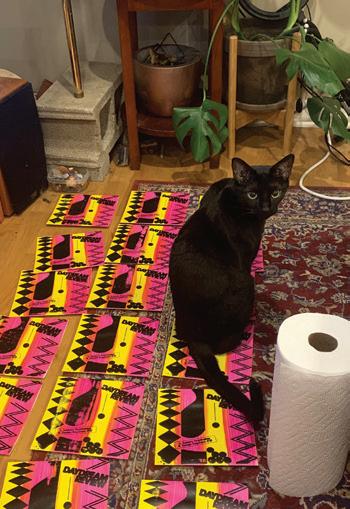
Lathe-cut records are a little di erent than traditional vinyl. They’re individually cut, or cut one at a time. And they’re cut out of polycarbonate, which is a di erent material that’s a little bit noisier sometimes. So they sound vintagey, which for me becomes a plus.
There was just a report that was put out last year saying half of the vinyl purchased was bought by people that don’t have record players. So for me, that’s funny. For independent artists and the stu that I’m trying to do, of course, I want people to listen to it, but nine times out of ten they’re gonna stream it. And I’d much rather they take this piece that we’ve worked really hard on, hang it on the wall, and then have more people find my record company and my artists, rather than it go sit on a shelf somewhere.
I’ve been doing those individual runs. The most recent one, we just sold out. I did a teninch with an artist out in Philly named Brian Walker—“A Day Without Love” is his moniker. And we just put out a four-song EP on a teninch called Tour Is Not a Road Trip! And I screen printed the design on sandpaper, so it’s like white ink on a black sandpaper. It kind of looks like a road.
Going on the road for tour feels like that sometimes—wiping your ass with sandpaper—but you make it happen. That’s the stu that I really like to do: take the ideas that these artists have already worked so hard on and bring some sort of physical manifestation of it. To take the story a little bit deeper, to make it a little bit more tangible.
Now that so much stu is online, it’s so hard to make four minutes of music feel like it took you more than four minutes. Every musician can tell you it took them years to learn how to play, much less make this piece. But I think for the general consumer, it is so hard to understand that and appreciate it. But I think when there’s something that they can hold, and you have to listen to it all the way through, there’s a di erent reverence to that.
DIY happens all over the country, of course. But Chicago DIY is so potent. And it is so essential to the music scene—like, there would not be bars without DIY musicians. I play mandolin and guitar and a couple of other things, plus singing. DIY spaces are where I was first able to share my solo art— from people opening their homes, garages, and back porches to so many. That’s how I met so many of my friends around the country that
are doing this. After lockdown, many of those spaces either weren’t around anymore, didn’t have the resources, or just weren’t safe—it arguably still isn’t very safe. But it’s been really important to me to have a DIY space that is COVID conscious. And to provide a safe space for LGBTQ+ touring musicians to come in and share their stu and not have to pay to play, not have to make back a minimum to pay the bar sta .
Some things that I think are important and need to be continuously invested in are communities of color in Chicago. The incredibly vast breadth of the art that is coming out of these communities is crazy. And everything that I say has been said better and more eloquently by an artist of color, I can guarantee, in Chicago. I think if you’re in an indie band, and you look like all the other indie bands that are playing right now, maybe it’s time to make sure you’re bringing the people to the table that you actually said you wanted to bring to the table in fine print.
I think those DIY spaces that are invested in, in west- and south-side communities, are kind of against all odds, and they deserve every bit of recognition and support we can give them. And wear a mask. It’s so easy to do. And it keeps more people safe and more people alive. It just does. v
@debbiemarieb_Chuck Jackson and Marvin Yancy went from Jerry Butler’s famous workshop to hit-making partnerships with the likes of Natalie Cole and Ronnie Dyson.
By STEVE KRAKOWSince 2004 Plastic Crimewave (aka Steve Krakow) has used the Secret History of Chicago Music to shine a light on worthy artists with Chicago ties who’ve been forgotten, underrated, or never noticed in the first place.
All forms of art speak of their time, and during events of historical significance, art reliably reflects those changes, whether overtly or subtly. Often the artists themselves respond by creating new aesthetics or philosophies. Righteous Chicago soul group the Independents didn’t catalyze a musical revolution of their own, but they still prove the point: they formed in part as a consequence of key developments during the last years of the civil rights movement.
The Independents were formed by the songwriting pair of singer Chuck Jackson and pianist Marvin Yancy (covered by the Secret History of Chicago Music a couple years
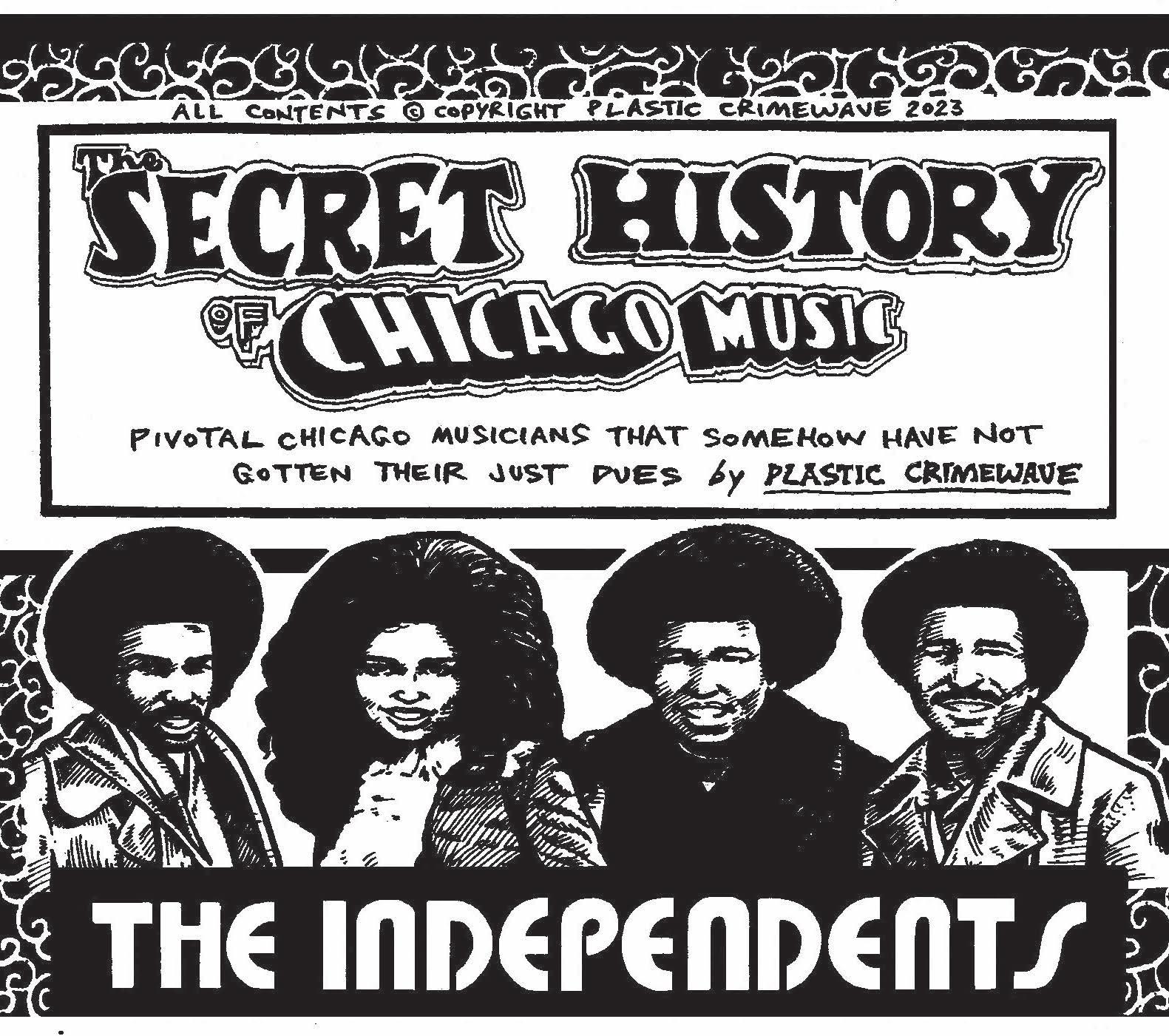
ago). Jackson was born March 22, 1945, in Greenville, North Carolina. His mother sang in church, and Jackson learned gospel fundamentals in school and church choirs. Yancy was born in Chicago on May 31, 1950, the son of a Baptist minister, and he began playing in his dad’s church at age 13.
Yancy attended the Moody Bible Institute, and Jackson studied commercial art and music at Furman University in South Carolina. After Jackson left school in 1964, he joined an
R&B band, and in 1968 he moved to Chicago to work as an art director for Playboy Music still had a powerful hold on Jackson, though. When he heard from a friend about a songwriting workshop sponsored by soul singer Jerry “Iceman” Butler, he quit that Playboy job to join it. Butler had launched the workshop in 1970 because he’d lost the services of Kenny Gamble and Leon Huff at Mercury, and he needed songs to fulfill his recording contract. The writers who networked
there generated material for Butler and many other artists—including dozens of charting singles—before it dissolved in 1976.
Butler was impressed by a few of Jackson’s tunes. “If It’s Real What I Feel” and “Walk Easy My Son” became Butler singles in 1971, with the former also featuring Jackson’s church friend Brenda Lee Eager on vocals.
That same year, Jackson met Yancy at a Black Expo in Chicago, presented by Operation Breadbasket under the leadership of the


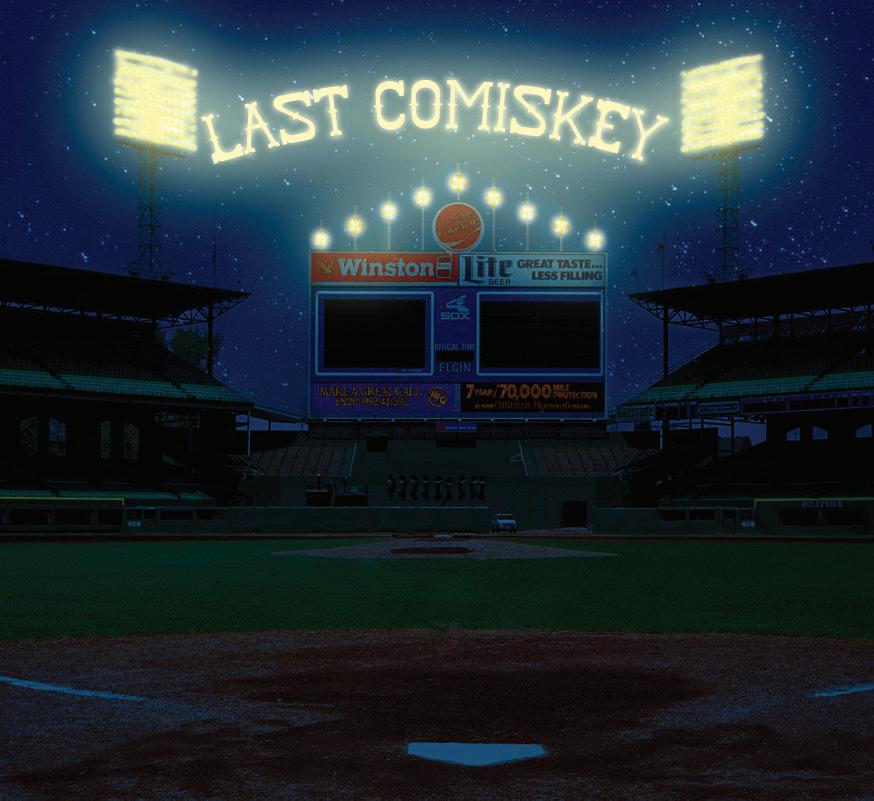











Mould Solo Electric with special guest Jason Narducy
FRIDAY, MAY 5 8PM
Joe Henry
with special guest Macie Stewart • In Maurer Hall
FRIDAY, MAY 5 8PM
May Erlewine In Szold Hall
SATURDAY, MAY 6 8PM
Alex Cuba In Maurer Hall
SUNDAY, MAY 7 7PM
Lisa O'Neill
with special guest Eli Winter • In Szold Hall
TUESDAY, MAY 9 8PM
The Microphones/ Mount Eerie
An Evening of Songs and Conversation In Maurer Hall
FRIDAY, MAY 12 8PM
SATURDAY, MAY 13 8PM
Little Syria
Omar Off endum, Ronnie Malley, Thanks Joey In Szold Hall
WEDNESDAY, MAY 17 8PM
Amy Ray Band
with special guest H.C. McEntire • In Maurer Hall
THURSDAY, MAY 18 8PM
Sondre Lerche In Maurer Hall
FRIDAY, MAY 19 7:30PM
Partha Bose (sitar) and Indranil Malick (tabla)
String Meets Skin - Classical Music from India In Szold Hall
FRIDAY, MAY 19 8PM
SATURDAY, MAY 20 8PM
Alejandro Escovedo
with special guest Nicholas Tremulis In Maurer Hall
continued from p. 56
Reverend Jesse Jackson, half brother to Chuck Jackson. Yancy was at the trade fair to play piano with gospel group the Caravans, and Jackson invited him to Butler’s workshop as a writing partner—Jackson was stronger as a lyricist, and he thought he could benefit from some help with tunes.
Operation Breadbasket was launched in 1962 in Atlanta by the Southern Christian Leadership Conference and its founding president, Martin Luther King Jr. “The fundamental premise of Breadbasket is a simple one,” King said in 1967. “Negroes need not patronize a business which denies them jobs, or advancement [or] plain courtesy.”
If businesses that served the Black community weren’t giving Black people good jobs, ministers would encourage their congregations to boycott or picket. Operation Breadbasket expanded to Chicago in 1966, led by Jesse Jackson, then a Chicago Theological Seminary student. He led successful campaigns targeting the dairy industry, supermarket chains, and even bottlers of Pepsi and Coca-Cola—and in the program’s first 15 months he secured an estimated 2,000 new jobs for Black people, worth about $15 million.
Jesse Jackson had founded the annual Black Expo in 1969, and in ’71 he would break from the SCLC to form Operation PUSH (People United to Save Humanity). In 1996, Operation PUSH merged with Jackson’s National Rainbow Coalition to form the Rainbow PUSH Coalition.
Yancy and Chuck Jackson began working on songs to potentially pitch to Aretha Franklin. They ended up writing eight together, and though the Aretha plan didn’t pan out, the duo did decide to form a new group. Former Impressions manager Eddie Thomas, impressed by their demo “Just As Long As You Need Me,” pitched it to Scepter Records subsidiary Wand in New York. Soaked in gorgeous string arrangements, with a softly spoken intro and bulletproof vocal harmonies, the song exemplified the Chicago sweet soul sound (with a touch of that smooth Philly vibe a la Gamble & Hu ). In spring 1972, it hit the top ten on the R&B chart.
The two young songwriters and musicians had put the group name “Independents” on the hub label for “Just As Long As You Need Me,” so now they needed to actually assemble a band. They began to scout talent from the local scene, and in 1972 they found two new members: Maurice Jackson (no relation) had been playing and recording in the local R&B
scene since the early 60s without much recognition, and Helen Curry from Clarksdale, Mississippi, had recorded a clutch of singles too, including the 1969 release “A Prayer for My Soldier” b/w “Sad and Blue” (which addressed the war in Vietnam).
“Just As Long As You Need Me” appears on the Independents’ 1972 debut full-length, The First Time We Met , also on Wand. They recorded at Paul Serrano’s famous P.S. Studios, with arrangements by the legendary “Tom Tom” Washington. Soft ballads dominated the album, with Jackson and Curry usually trading lead vocals in traditional gospel style.
The album also produced “Leaving Me,” which would become the band’s signature tune. Upbeat, melancholy, and brilliantly supple, the tune became a certified gold hit in early 1973, well after the release of the album, staying on the Billboard R&B chart for more than three months and peaking at number one.
The First Time We Met features top-shelf Chess Records session musicians, as well as Yancy’s piano—but Yancy, who preferred to stay behind the scenes, didn’t appear on the album’s cover with the other three members. For the Independents’ second album, Yancy worked mainly as a songwriter and producer. For live shows he was replaced by Chicago native Eric Thomas, who’d met Chuck Jackson through Operation PUSH; Thomas had been part of the group’s choir, which Yancy directed for a 1973 album.
That second album, also released by Wand, dropped in 1973 with the title Chuck, Helen, Eric, Maurice. It yielded a single hit, “It’s All Over,” which reached number 12 on the soul charts. The lush, gospel-informed weeper, fleshed out with weedy organ, percussive guitar, and epic string arrangements, might’ve been the first Independents song I heard.
Serrano recorded this album too, and despite its shortage of chart material, it has some standout tunes, including “No Wind, No Rain” (with glorious wah-wah guitar) and “I Found Love on a Rainy Day” (with an up-tempo dance groove).
After a couple more singles in 1974—including the disco-infused boogie “Arise and Shine (Let’s Get It On)” and the classic ballad “Let This Be a Lesson to You”—the Independents dissolved amid record-company squabbles.
Even today I’m pained by that outcome, because the band seemed on track to become the next Impressions, Dramatics, or even Gladys Knight & the Pips. But Yancy and Jackson went on to great success as a songwriting team. In
late 1974 they began working with emerging singer Natalie Cole, who’d just signed to Capitol Records. They wrote her first hit song in 1975, “This Will Be (An Everlasting Love),” and their partnership with her would produce four gold and two platinum albums.
Yancy married Cole in 1976, and he and Jackson moved to Los Angeles in 1977 to make working with her easier. After Yancy’s father died later that year, though, Yancy took over his church in Chicago, and his separation from Cole led to their divorce in 1980.
Yancy and Jackson also wrote for artists on Curtis Mayfield’s Curtom label, including the Notations, and for stars such as Ronnie Dyson. They rapidly became heavyweights in the business, and both had solo careers as performers. In 1978, Jackson released the solo album Passionate Breezes , which included six tunes written with Yancy. In 1979, Yancy dropped a gospel single, then followed it in 1985 with the album Heavy Load . It reached number four on the gospel chart, but he didn’t get to enjoy its success—he died tragically young from a heart attack that same year. In the early 1980s, his partnership with Jackson had ended after a falling-out between them.
In 1976, Maurice Jackson formed the group Silk, whose members included Eric Thomas and fellow Operation PUSH choir alum Arthur Reid. In 1977, they released a self-titled LP on New York label Prelude, which produced the successful single “Party.” Maurice Jackson also put together a latter-day version of the Independents in the 2010s, which in 2018 reunited with Chuck Jackson and Eric Thomas for a daylong south-side concert copresented by the Rainbow PUSH Coalition.
Helen Curry continued recording too, and her excellent 1979 single “Such a Thrill I Feel (When You Hold My Hand)” seems especially ripe for rediscovery by crate diggers. It’s a bona fide burner, combining disco-flavored funk with diva-style gospel vocals.
Maybe if the Independents had had a longer career, they’d be internationally beloved the way they deserve. But let’s at least remember to celebrate the incredible Independents recordings we do have. And we should also bear in mind how they formed, with members connected by a righteous program by and for the Black community—something else we can never have too many of. v
The radio version of the Secret History of Chicago Music airs on Outside the Loop on WGN Radio 720 AM, Saturdays at 5 AM with host Mike Stephen.







defprez See Pick of the Week at le . Semiratruth and J Bambii open. 8:30 PM, Golden Dagger, 2447 N. Halsted, $20. 21+
HIRS Collective Midwestlust, Foehammer, and Stolen open. 8 PM, Reggies Music Joint, 2105 S. State, $12. 21+
The HIRS Collective is an amorphous grindcore punk group whose anonymous members first came together in Philadelphia in 2011 to upli and defend people targeted by marginalization, oppression, and violence, including queer and gender-diverse people, BIPOC, and outsiders of all kinds. In the intervening years, the American right has escalated its campaign of bigotry and cruelty against the LGBTQ+ community—and transgender people specifically—as part of its broader attack on democracy. If you want to scream about the criminalization of drag queens and the barrage of anti-trans legislation that’s increasingly forcing families to move across state lines to ensure their loved ones can receive gender-affirming care, then you’ll be glad to know that the HIRS Collective has a few hundred pointed, politically fueled songs for you to scream along to. The group demonstrates the power of inclusivity and acceptance, not only in its constantly shi ing membership but also in its network of collaborators. In fact, you could build a badass music collection just out of records by the dozens of guests on this spring’s fiery We’re Still Here , who include Garbage vocalist Shirley Manson, freaky Japanese noise rockers Melt-Banana, and Philly hardcore punks Soul Glo. (As HIRS explained to New Noise in March, some of its members love hip-hop, and that inspired the collective to create an album with guests on every track.) This show also features noise and powerviolence sets from Midwestlust (Chicago and Saint Louis) and Stolen (Aurora) as well as monolithic doom metal from Foehammer (Annandale, Virginia), so come get your ears scrubbed out and feel the love.
—JAMIE LUDWIGDEFPREZ,
Thu 5/4, 8:30 PM, Golden Dagger, 2447 N. Halsted, $20. 21+
WHEN I FIRST LISTENED to the new collaborative album from Chicago rappers Defcee and CRASHprez, It’s Always a Time Like This (Closed Sessions), I lost track of how many times I replayed a passage to catch an ingenious turn of phrase that’d I’d missed when it zoomed by the first time. In “Safer,” Defcee rounds o and separates every syllable in his blocks of verses, even when he twists his rhymes like a clown turning a handful of balloons into a Noah’s Ark of animals: “Memories of ditchin’ the kitchen and chillin’ in sun rays,” he raps in one especially dense couplet, “Left its past with a round-trip ticket and thinking it’s one-way.” Just as often, I’d pause the album to laugh in amazement at an especially florid and precise streak of bars, and CRASHprez’s flow-shifting performance at the start of “Keep That” nearly provokes that response even now, when I know what to expect. As defprez, these two MCs give each other the space and the juice to approach the mike with refreshed energy, meticulously knotty verses, and enough heart to make every line count. Throughout It’s Always a Time Like This, CRASHprez and Defcee are clearly performing especially for the people they most want to impress: each other. —LEOR GALIL
OK Cool Scarlet Demore and Background Character open. 8 PM, Schubas, 3159 N. Southport, $15. 18+
In summer 2020, during one of my routine Bandcamp searches for new music tagged “Chicago,” I found OK Cool’s Anomia EP, and it convinced me of the local indie-rock duo’s potential. With that EP, guitarist-vocalist Bridget Stiebris and bassist Haley Blomquist proved that they know all the obscure flavors of indie and emo that precede them—and that they have the gentle touch needed to smooth out the sentimentality and excitability in that variety of styles. That said, OK Cool’s new Fawn (released via the duo’s own Take a Hike Records) has exceeded even my high expectations for the band. Blomquist and Stiebris’s intricately arranged songs radiate the amniotic warmth of great shoegaze, while preserving the sharp detail that shoegaze usually blurs. The
double helix of corkscrewing guitars on “Mud,” for example, creates a dizzy euphoria. Stiebris encodes big feelings about twentysomething queer anxiety, joy, and confusion into her droll lyrics, and her dry singing and nuanced performances encourage you to sit with her words. Fawn runs an all-too-brief 17 minutes, but it’s satisfying even at that length. I doubt I’ll hear many other new indie-rock EPs this year that will draw me in so well.
—LEOR GALILElkhorn, Elijah McLaughlin & Jason Toth Scott Verrastro opens in a duo with Ian McColm, who will also drum with Elkhorn. 9 PM, Hungry Brain, 2319 W. Belmont, $10. 21+

This spring, east-coast instrumental duo Elkhorn released On the Whole Universe in All Directions (Centripetal Force), and Chicago’s Elijah McLaughlin Ensemble released the equally game-changing III (Astral Spirits). Though their sounds are distinct, the two bands aim at a common goal of musical transcendence—which may help explain how they ended up on this bill together. The members of Elkhorn switch up their instrumentation for this release; Drew Gardner, who usually plays electric guitar, instead overdubs drums and gauzy layers of vibraphone that exchange solemnly spiritual phrases with Jesse Sheppard’s patiently strummed 12-string acoustic guitar. The Elijah McLaughlin Ensemble adds musicians and instruments in order to enrich the textures of its leader’s pastoral melodies. McLaughlin doubles on guitars and synthesizer,
blending his contributions with Katinka Kleijn’s cello, Adler Scheidt’s piano, and Joel Styzens’s hammered dulcimer to form spacey swirls over the surging rhythms of upright bassist Jason Toth. But for this concert, both groups will get back to fundamentals. The McLaughlin Ensemble will be represented only by its core members, McLaughlin and Toth, who’ll perform distillations of their recorded work and debut some new themes. And for Elkhorn’s first Chicago appearance since 2019, Gardner will be back on electric guitar, with Sheppard on 12-string and Ian McColm (Heart of the Ghost, Center) on drums. This configuration is similar to the lineup that played the open-ended, skirling jams on Elkhorn’s 2022 release, Distances (Feeding Tube). Scott Verrastro (Kohoutek, Curanderos) will open the concert by playing an improvised percussion duo with McColm; Elijah McLaughlin and Jason Toth will play second, and Elkhorn will headline. —BILL MEYER


Christeene Fever Ray headlines. 8 PM, Salt Shed, 1357 N. Elston, $40-$90. 17+
Christeene is like the bathroom-stall love child of Iggy Pop and Peaches. No, she’s like an orphan who emerged from a hidden cave unearthed at a Blacklips Bar stage show in 1992. Actually, she’s like a teen girl from the Stone Age who time traveled to 2023 to learn R&B. A rock ’n’ roll drag queen persona developed by Brooklyn performance artist Paul Soileau, Christeene is all these things and more: a genre-bending gender terrorist who draws from

a rich creative lexicon but purposely masks that sophistication by singing in a childlike tone (which she carries over into her writing and speaking on social media).
For more than a decade, Christeene has been refining her act in bars, clubs, and underground parties, performing in stringy, straight black wigs with color streaked across her face like something between a kid’s first adventures with makeup and war paint. Her wardrobe is revealing and ill-fitting, with touches of sophistication and decay—an appropriate aesthetic for a woman whose biggest single from last year’s Midnite Fukk Train is called “Lo Paid Runway Model.” It’s a Motown-tinged torch song about desperation, loneliness, and a longing to be taken seriously. “What’s it gonna take?” she wails between saxophone bursts. “What’s it gonna take?” The song forces you to consider not only the social and professional systems hemming in Christeene’s
work but also your own attitudes and assumptions about her refinement (or lack thereof). How can this feral glamor gal get the rewards she desires? What’s delaying her flowers?
In a 2012 interview with Portland Monthly , Christeene recalled weathering multiple digital scandals accusing her of racism, classism, and transphobia. “Everything we get now is so cleanly packaged and apologetic,” she said. “What we’re trying to do with this juggernaut of expression and emotion is wake people up and allow people to use this character to voice their anger or their happiness, to feel beautiful against this disgusting backdrop.” Since then, she’s been celebrated for building on the output of groundbreaking queer artists such as Jayne County and Vaginal Davis. At her Salt Shed debut, she opens for Swedish synth-pop weirdo Fever Ray. It’s sure to be a raucously fun show for freaks of all kinds. —MICCO
Rebecca Black Mazie opens. 7 PM, Bottom Lounge, 1375 W. Lake, sold out. b
In 2011, Rebecca Black became one of the first teen YouTube sensations when she went viral with the video for “Friday,” her ode to the freedom of childhood weekends. Backlash arrived just as quickly as her newfound fame, and even though she was 13 years old, she wasn’t spared harsh criticism. As Dan Whitworth at the BBC reported, “Friday” was widely derided as “the worst song ever,” and Black has never lived it down.
On the second Friday of May, Black will take the stage at Bottom Lounge as a full-fledged adult who’s been forged by the Internet’s fire. It’s a theme that runs in the background of her debut full-length, February’s Let Her Burn . Writing for Pitchfork, Shaad D’Souza called the album “a desperate, baldfaced attempt to pull together whichever cultural signifiers seem likely to resonate with online fanbases.” Um, yes, that’s exactly what she’s doing—and why shouldn’t she?

Let Her Burn is 31 minutes of hyperpop that reveals someone grappling with the desire to say something sincere after being a notorious online punching bag for more than a decade. Can anyone blame Black for not taking bigger risks? What the album lacks in ambition and ingenuity, it makes up
for with self-awareness. Black is a lesbian creating music for a hyper-online audience that includes as many camp-obsessed homos as it does people who first met her as a doe-eyed teen on social media. That’s why songs that seem perfunctory can also work.
Take “Doe Eyed.” A la Miley Cyrus a er Hannah Montana , she reminds listeners she’s not the kid they once knew: “Got a little kitty with a big dream / Come and lick it up like it’s strawberry cream.” But unlike the former child actor, Black has never adopted a persona that leans hard on the hypersexual. In fact, she’s fairly restrained by pop-icon standards; when she wants to go for grit, she’ll get there with camp flourishes or a push-pull of imagery or style that volleys between gentle and violent like a typical social media feed. Let Her Burn is a studied survey of Internet trends from someone who’s very publicly had to learn what to volunteer and what to withhold in her creative work. Despite it all, Black remains committed to the painful task of making pop songs. Haters would love to see her reduced to ash. And yet? Her flame persists. —MICCO CAPORALE
SATURDAY13
Man or Astro-Man? Bleach Party opens. 8 PM, Subterranean, 2011 W. North, $28. 17+
Now that 90s nostalgia is trending hard, you’d think the decade’s wackier shit would get more attention.
Man or Astro-Man? (o en styled “Man . . . or AstroMan?”) emerged in the early 90s as a punk-driven surf-rock band from the landlocked college town of Auburn, Alabama, with members who claimed to be extraterrestrials and infused their tunes with synthesizers, gadgetry (including an Apple ImageWriter II printer), and clips from science-fiction movies. Instrumental surf rock had emerged during the space race of the 1960s, so flirtations with interstellar themes were nothing new in the genre, but it had never sounded quite so odd, raw, and subversive. Between 1992 and 2001, when they went on hiatus, Man or Astroman? released a stack of albums and a couple dozen seven-inches and EPs for the likes of Touch and Go, Estrus, and Sympathy for the Record Industry, played in nearly 50 countries, recorded music for Space Ghost Coast to Coast, and sent not one but two bands of “clones” out on the road under their direction. Along the way, they helped turn on a generation to futuristic surfy sounds (in a write-up of Clone Tour Alpha in 1998, MTV touted the influence of Man or AstroMan?, claiming that they “were intergalactic when the Beastie Boys were merely ‘ill’”). They’ve been active intermittently ever since, notably re-forming in 2006 for Touch and Go’s 25th anniversary party in Chicago, and in 2013 they released the album Defcon 5 . . . 4 .
(Chunklet Industries), which contains some of their most aggressive and urgent material to date—no matter how long the band has laid low, they can still fire up their imaginations and their chops more reliably than any billionaire’s rocket. —JAMIE LUDWIG

Greg Puciato Escuela Grind, Deaf Club, and Trace Amount open. 6:30 PM, Bottom Lounge, 1375 W. Lake, $35. b
There’s busy and then there’s Greg Puciato busy. In the thick of his 16-year tenure fronting metalcore act the Dillinger Escape Plan, he got involved in several other endeavors, including wide-ranging postmetal project Spylacopa, alt-metal supergroup Killer Be Killed, and synthwave act the Black Queen. Since the band’s dissolution in 2017 he’s continued to carry a heavy workload—Killer Be Killed and the Black Queen are still going concerns, and he’s formed the record label and art collective Federal Prisoner. He’s also continued to be a go-to guest vocalist within the extreme-music space and beyond.
1
. More recently they’ve been combing their archives and recording new material pieced together out of old odds and ends, and the first example arrived in 2021 in the form of a threesong single, Space 1991. Man or Astro-Man? greeted 2023 with a new double seven-inch, Distant Pulsar
In the past few weeks alone, Puciato has wrapped up a tour with Jerry Cantrell where he added backup vocals and harmonies to Cantrell’s solo material and Alice in Chains hits; he’s announced he’s joining members of Fit for an Autopsy and Every Time I Die in a much-anticipated new project called Better Lovers; and he’s launched
his first-ever solo tour, which began May 3 and stops at Bottom Lounge on May 14.



Puciato’s first two solo albums, 2020’s Child Soldier: Creator of God and 2022’s Mirrorcell , released on Federal Prisoner, show him at his most unchained. They’re a composite of all his influences, experiences, and interests—a Puciato sampler platter piled high with bites of grunge, experimental noise, industrial, metal, and synthwave. He’s already known for no-holds-barred live performances where he sacrifices his body for his art—he usually le a Dillinger show bruised and bloodied— and this broad musical arsenal should amp up his solo shows even further.
Puciato’s tentacles reach into many corners of the heavy-music community, enabling him to line up an ensemble for this tour that’s a draw in itself: guitarists Nick Sadler (Daughters) and James Hammontree (aka Black Magnet), drummer Noah Taylor (Destroyer Destroyer), and bassist Jeff Geisser. (Hammontree and Geisser both appear on Puciato’s recent live album, 11/11/22: Los Angeles , which documents his first show as a solo artist.) In a press release, Puciato says these dates will “possibly be the only tour under my own name for the foreseeable future,” so consider yourself warned.
The night’s openers are Brooklyn harsh industrial project Trace Amount, eclectic San Diego grindcore outfit Deaf Club (featuring members of the Locust and ACxDC), and upstate New York powerviolence punishers Escuela Grind, who recently signed to MNRK and are working with producer (and Converge guitarist) Kurt Ballou on new tracks

the ethos of their live shows.
 —SELENA FRAGASSI
—SELENA FRAGASSI



Helen Money & Will Thomas, Trace Thrill Jockey helenmoney.bandcamp.com/album/trace
Cellist Alison Chesley, who makes music as Helen Money, has been colleagues for years with composer and producer Will Thomas. Thomas has worked on a couple of Chesley’s albums (2016’s Become Zero and 2020’s Atomic ), and Chesley has contributed to Thomas’s song-based collaborative project Dive Index. Chesley, who grew up in California, came to Chicago in the 1990s for graduate school and spent years here building a distinct sound that’s placed her at the nexus of scenes as diverse as indie rock, doom metal, and avant-garde classical. She then returned to Los Angeles, where Thomas also lives, and they overlapped for about seven years until Chesley moved back to Chicago. But distance has only made these musicians’ hearts grow fonder: they recently teamed up for their first fully collaborative record, Trace , a collection of 11 immersive, gradually unfurling compositions.
Trace is a studio album, but its o en foreboding music evokes fantastical acoustic settings. “Someone Out There” and “Boulevard in Silence” resound as though recorded in a damp underground lab-
continued from p. 63
yrinth. The mechanical low-brass fi gure ushering along “She Never Suspected” sounds like the last churnings of a cavernous, nearly abandoned factory. Other songs swaddle the ear and the heart: on companion pieces “Half Asleep” and “Half Awake,” Chesley bows plangent cello lines above a muted, slightly warped piano ostinato that Thomas seems to be playing underwater, and “Abandon” glows with the rounded resonance of a high-ceilinged chapel. “Thieves,” released as an advance single, is the biggest departure from Trace ’s brooding mood, with its hurtling syncopation and cello harmonics distorted to sound like an electric guitar. Over-ear headphones recommended—but no matter how you hear it, Trace will weave its way into your brain circuitry. —HANNAH
EDGARWhitney Houston, I Go to the Rock: The Gospel Music of Whitney Houston Arista / Legacy / Gaither Music Group whitneyhouston.com
Before she became a pop superstar, Whitney Houston was known as “Nippy,” daughter of gospel artist Emily “Cissy” Drinkard Houston and member of the choir at New Hope Baptist Church in Newark, New Jersey. Like Aretha Franklin—the only vocalist Rolling Stone ranks above her on its current list of the 200 greatest singers of all time— Houston honed her chops singing church songs. I Go to the Rock: The Gospel Music of Whitney Houston , which includes a CD and a companion DVD of a recent TV documentary, is the first effort to gather together her modest but moving gospel oeuvre.
Dominating the collection are sacred selections Houston contributed to soundtracks ( The Preacher’s Wife , The Bodyguard , Sparkle ) or sang at award shows and other special events. These tracks have long been available on other CD releases or on YouTube, o en in the form of performance clips from shows such as VH1 Honors But I Go to the Rock showcases three previously unavailable gospel tracks Houston recorded as a teenager—not yet a gleam in the eye of Clive Davis and Arista Records.
When Houston bites into “Testimony” and “I Found a Wonderful Way,” two of the three unearthed cuts, she’s essentially indistinguishable from the greater body of Newark church wreckers. On the other hand, her delivery on the slow- burning “He Can Use Me” is devastating. It removes all doubt, if there ever were any, that she was poised to be the voice of a generation.
Also like Franklin, Houston neither abandoned the church nor its music. She frequently incorporated a set of hymns and gospel songs into her sta-
dium concerts. One is “I Love the Lord,” an incandescent interpretation of an 18th-century hymn arranged in the 1970s by Richard Smallwood and featured in the 1996 movie The Preacher’s Wife Houston seemed most at peace singing the Lord’s music; when I hear these recordings, I’m struck by the lilt in her voice, which feels more genuine and less studied and technical than on her pop songs. It’s raw, pure expression.
I Go to the Rock doesn’t include every one of Houston’s gospel moments—her appearance on BeBe and CeCe Winans’s 1988 track “Hold Up the Light,” for example, is absent—but the collection is a splendid remembrance of a divine talent who should have turned 60 this August.
—ROBERT MAROVICHDave Lombardo, Rites of Percussion Napalm davelombardo.bandcamp.com/album/rites-ofpercussion
Dave Lombardo is best known for his work with the legendary Slayer, where he reinvented heavy metal drumming, but he did much more than drive that thrash powerhouse—his resumé feels practically endless. By the time Slayer dropped their fi h album, 1990’s Seasons in the Abyss , it had become clear that Lombardo was more than just a dude who could make two bass drums go from fast to extremely fast—the man was a true-blue percussionist. He brought his lifelong love of Tito Puente to the forefront of the band’s barrage of riffs, and his lively, complex fills created hooks in and of themselves, standing out with their lively rhythms and Latin flair.

Slayer are merely the tip of the Lombardo iceberg. Over the past 40 years he’s loaned his drums to myriad projects, including straightforward bashers (Suicidal Tendencies, Testament, the reunited Misfi ts) and esoteric and experimental endeavors. He spent a decade in heady supergroup Fantômas, and since the late 90s he’s collaborated with avant-garde saxophonist John Zorn. Now, hesher drum freaks of the world can rejoice, because we’re finally getting the first-ever Dave Lombardo solo record, Rites of Percussion (Ipecac). Channeling the percussive mantras of Mickey Hart, it’s a 13-track document of Lombardo trapped in a room with mountains of drums, using his signature apeshit playing to build fully realized songs that move among rhythmic mayhem, spooky soundscapes, tribal pummeling, and funky pocket playing. It’s 35 incredibly satisfying minutes of one of the world’s greatest drummers going absolutely nonstop bonkers. And at the record’s end, as you flip it over to dive in once again, you’ll be wondering, “Why didn’t he do this sooner?”
—LUCA CIMARUSTI v
100+ EVENTS JUNE 6 – SEPTEMBER 10 2023


CHICAGO SYMPHONY ORCHESTRA • MARIN ALSOP



Claire Bourg • Ravenna Lipchik • Rannveig Marta Sarc • Alexander Hersh • Greg Ward
Glenn Zaleski • Dan Chmielinski • Kenneth Salters
• Michael Feinstein
• Jean-Yves Thibaudet
Ruth Page Civic Ballet • DanceWorks Chicago • Deeply Rooted Dance Theater • Hedwig Dances
Jumaane Taylor • Jacob Collier • Lawrence • Tiny Habits • Ms. Lauryn Hill
Arnaud Sussmann • Michael Stephen Brown
• Chicago • Ravinia Jazz Scholars
Pat Metheny • Karim Sulayman • Sean Shibe • Melody Gardot • Counting Crows
Dashboard Confessional • Glory Days • Ralph’s World • Charlie Puth • Summer League
Jesse & Joy • Jorge Federico Osorio • Calidore String Quartet • Santana • Miriam Fried
Mark Steinberg • Paul Biss • Kim Kashkashian • Marcy Rosen
• Alessio Bax • Straight No Chaser
Ambrosia • Ne-Yo • National Seminario Ravinia Orchestra
• Chicago Philharmonic
Jonathan Rush • Apollo’s Fire • John Fogerty • Hearty Har • Miko Marks • Chicago
Symphony Chorus • Janai Brugger • Ashley Dixon
Adrian Dunn Singers • Ayodele Drum & Dance
• Paul Appleby • Ryan Speedo Green
• Jim Gailloreto Trio
• Senn High School Choir
Heather Headley • Ravinia Lawndale Family Music School • Trinity UCC Choir • Sasha Cooke
Ariel Quartet • Ayano Ninomiya • Matthew Lipman • Karen Ouzounian • Henry Kramer
Valentina Peleggi • Gabriela Montero • Natalia Lafourcade • Maria Schneider Orchestra
Alexis Lombre • Rebirth Brass Band • Danish String Quartet • Mei-Ann Chen • Jeremy Denk
Ted Sperling • Andréa Burns • Morgan James • Capathia Jenkins • Laurie Berkner • Jason Mraz
Elvin Bishop & Charlie Musselwhite • Apollo Chorus of Chicago
• Matthew Polenzani
Joshua Hopkins • Kathryn Lewek • David Leigh • Christian Sanders • Tiffany Choe • Taylor Raven
Diana Newman • Adam Lau • Yunchan Lim • Boz Scaggs • Keb’ Mo’ • The Special Consensus
Jonathon Heyward • Benjamin Beilman • Teddy Abrams • Jeffrey Kahane • Lee Mills
Rufus Wainwright • Opera for the Young • Blues Traveler • Big Head Todd & The Monsters
John Legend • Ailyn Pérez • Kevin Murphy • Joshua Weilerstein • Alisa Weilerstein
Jethro Tull • Kenny Loggins • Yacht Rock Revue • George Stelluto • Lara Downes • Nicole Cabell
Buddy Guy • George Benson • Classic Albums Live (The Dark Side of the Moon)
Okee Dokee Brothers • Boyz II Men • The Isley Brothers • Misha Dichter
Disney Encanto In Concert • Thiago Tiberio • Jurassic Park In Concert • Scott Terrell • Train
Parmalee • Brandi Carlile • Carrie Underwood • Jory Vinikour • Tessa Lark • Shakti
Béla Fleck • Music of the Baroque • Dame Jane Glover • James Ehnes
Chicago Multi-Cultural Dance Center’s Hiplet Ballerinas • The Era Footwork Crew
Forward Momentum Chicago • Joel Hall Dancers • M.A.D.D. Rhythms • Move Me Soul
Muntu Dance Theatre of Chicago • Najwa Dance Corps • Praize Productions • Billy Childs
Rufus Reid • Steve Wilson • Sara Caswell • Christian Euman • Kurt Elling • Black Oak Ensemble
DJ Derrick Carter • DJ Michael Serafini • DJ Garrett David • Lucy Stoole • Nico • Reik
TICKETS ON SALE NOW! AT RAVINIA.ORG
ise, Lil Pump & Smokepurpp, Eem Triplin, DD Osama, Jeleel!, Valee, Black Kary, DC the Don, Joeyy, Sxmpra, Nina Tech, Broke Boii, Suicideboys
6/23, 3 PM, SeatGeek Stadium, Bridgeview b
Lyrical Lemonade Summer Smash day two featuring Future, Lil Uzi Vert, Ski Mask the Slump God, G Herbo, Cordae, Juicy J, Tee Grizzley, Luh Tyler, Lil Tracy, SahBabii, Famous Dex, Yung Bans, Jasiah, Veeze, Gloss Up, Danny Towers, Sexyy Red, Cdot Honcho, Dom Corleo, CP, Highway, Komla 6/24, 1 PM, SeatGeek Stadium, Bridgeview b
Aerosmith, Black Crowes 9/15, 7 PM, United Center b
Agent Orange 9/29, 6 PM, Cobra Lounge b
Album Leaf, Raays 6/1, 8 PM, Lincoln Hall, 18+
Big Richard, Eli Winter 6/22, 7:30 PM, SPACE, Evanston b
Bishop Briggs, Misterwives
9/22, 7 PM, Salt Shed b
Jack Botts 10/2, 8 PM, Beat Kitchen, 17+
Bywater Call 6/14, 8:30 PM, FitzGerald’s
Cannons, New Constellations, Jane Leo 9/1, 8 PM, Riviera Theatre, 18+
Paul Cebar Tomorrow Sound
7/6, 7:30 PM, SPACE, Evanston b
Chance the Rapper, Saba 8/19, 8 PM, United Center b
Cheap Trick, Brokeback 7/16, 7 PM, Metro, 18+
Cheer-Accident, Mercury
Tree, Imelda Marcos 9/16, 9 PM, Reggies Music Joint Chicago Blues Festival day
one featuring Centennial
Tribute to Albert King with Donald Kinsey, Larry McCray, Rico McFarland, Carl Weathersby, and Tony Llorens; Blind Boys of Alabama with Bobby Rush; Wayne Baker Brooks; and more 6/8, 5:15 PM, Pritzker
Pavilion Fb
Chicago Blues Festival day two featuring John Primer & the Real Deal Blues Band; Jimmy Burns Band; Jontavious Willis; Nora Jean Wallace; 70th Anniversary of Delmark Records celebration including Bob Stroger, Sharon Lewis, Willie Buck, Willie Hayes, Shirley Johnson; and more 6/9, noon, Millennium Park Fb
Chicago Blues Festival day three featuring Mud Morganfield; Joe Pratt & the Source One Band; Women in Blues honoring Deitra Farr, Katherine Davis, and Sugar Pie DeSanto; and more 6/10, noon, Millennium Park Fb

Chicago Blues Festival day
four featuring Los Lobos, Lil’ Ed & the Blues Imperials, Sheryl Youngblood, O.B. Buchana, and more 6/11, noon, Millennium Park Fb
Chicago Gospel Music Festival featuring Tye Tribbett; Karen Clark Sheard; Choir Nation featuring Pastor DeAndre Patterson & Destiny Worship Center Chorale, Janet Sutton & the Voices of Acme, and Bishop Larry D. Trotter & Sweet Holy Combined Choirs; and more
6/3, 5:30 PM, Pritzker Pavilion
Fb
Clientele 8/15, 8 PM, Lincoln Hall
Congregation, Soulbillys 6/3, 8:30 PM, Golden Dagger
A Day in the Country featuring Brennen Leigh, Annalee Koehn & Chuck Cox, Brandon Good, Country Doctors, Gin Palace Jesters, James Dean Joint, Lawrence Peters
Outfit, Northside Southpaws, Rachel Drew, Reilly Downes, Ten Cent Men, Wildwood Flowers 6/11, 2 PM, Hideout Deer Tick, Abby Hamilton 11/9, 8 PM, Thalia Hall, 17+
Leanna Firestone 7/22, 8 PM, Beat Kitchen, 17+
Flamingos in the Tree 7/7, 7 PM, Cobra Lounge b
Flat Five 7/16, 4 and 7 PM, Hideout
The F.O.R.C.E. Live featuring LL Cool J, the Roots, Rakim, DJ Jazzy Jeff, Common, Bone Thugs-N-Harmony,
Doug E. Fresh, Slick Rick
8/13, 8 PM, United Center b
Generationals 10/5, 8 PM, Thalia Hall, 17+
Gories, Glyders, Stools 8/11, 10 PM, Empty Bottle
Gories, Sueves, Stools 8/12, 9 PM, Empty Bottle
Hotel Fiction 6/3, 9 PM, Schubas, 18+ James Hunter Six 7/9, 8 PM, SPACE, Evanston b
IDK 10/27, 8 PM, Bottom Lounge, 17+ Hannah Jadagu 10/1, 7:30 PM, Schubas b
Shawn James, Rachael Davis 10/14, 8 PM, Reggies Rock Club b
Jidenna 8/18, 8 PM, the Vic, 18+ Jodeci, SWV 8/11, 7:30 PM, Arie Crown Theater b
Jonas Brothers 8/25, Wrigley Field b
Kamelot, Battle Beast, Xandria 8/24, 7 PM, the Vic, 18+ Knucks 10/20, 9 PM, Schubas, 18+
Ray LaMontagne 9/27, 7:30 PM, Chicago Theatre b
Jim Lauderdale & the Game Changers, Lillie Mae 6/10, 8:30 PM, FitzGerald’s
L’éclair 7/27, 9 PM, Empty Bottle
Leezy, Reno Cruz 6/20, 8 PM, Golden Dagger
Dean Lewis, Sara Kays 9/19, 8 PM, the Vic, 18+
Little Feat 10/15-10/16, 7:30 PM, the Vic, 18+ Little Jesus 7/13, 7 PM, Bottom Lounge, 17+
Low Cut Connie 10/14, 8 PM, Thalia Hall, 17+
Lustsickpuppy, Johnnascus
7/8, 7 PM, Subterranean b
Lyrical Lemonade Summer Smash day one featuring Kid Cudi, Vince Staples, Ice Spice, Glorilla, Freddie Gibbs, NLE Choppa, Coch-
Lyrical Lemonade Summer Smash day three featuring Playboi Carti, Trippie Redd, Lucki, Central Cee, Lil Skies, Rico Nasty, Babytron, Lil B, Lil Mosey, Sematary & the Haunted Mound, Ramirez, Bktherula, BLP Kosher, 2Rare, Babyxsosa, Sid Shyne, Slime Dollaz, Ausar, Pola Bear, and more 6/25, 1 PM, SeatGeek Stadium, Bridgeview b
Motionless in White, Knocked Loose, A er the Burial, Alpha Wolf 10/21, 6:30 PM, Aragon Ballroom b Motoblot day one featuring Black Widows, Rumours, Cruella, Vaudettes 6/23, 4 PM, Cobra Lounge b
Motoblot day two featuring Krank Daddies, Vang!, Labretta Suede & the Motel 6, Beat Creeps, Hi-Jivers, Crombies, Nashville Pussy, Vaudettes 6/24, noon, Cobra Lounge b Motoblot day three featuring Supersuckers, Delta Bombers, Tiger Sex, Surfrajettes, Sabbatha, Aweful, Bama Lamas, Vaudettes 6/26, 11 AM, Cobra Lounge b Nicotine Dolls 8/11, 8 PM, Beat Kitchen, 17+ Night Flight Orchestra, Jorgensens 9/14, 8 PM, Reggies Rock Club, 17+ Tom Odell 10/14, 8 PM, the Vic b
OK Cool, Dreaded Laramie, Cusp, Hard Femme 7/30, 7 PM, Subterranean, 17+ Oneida, Arriver 8/13, 9 PM, Empty Bottle
Craig Owens, Kurt Travis, Moxy the Band, Violà 7/6, 7 PM, Bottom Lounge, 17+
Paul McCartney Birthday Tribute featuring Phil Angotti and friends 6/17, 9 PM, FitzGerald’s
Ted Park 7/29, 8 PM, Reggies Rock Club, 17+
Protest the Hero, Moon Tooth 10/14, 7 PM, Bottom Lounge, 17+
Noah Reid 11/25, 7:30 PM, Park West b
Chris Renzema, Jess Ray 11/9, 7:30 PM, Park West b
Say Sue Me, Precocious Neophyte 7/20, 9 PM, Empty Bottle
Shinedown 7/21, 7 PM, Hard Rock Live Northern Indiana, Gary 6lack 11/1, 8 PM, Aragon Ballroom, 17+
Sleepwalk, Interlay, Killusonline 6/8, 8 PM, Schubas F
Pat Smillie 12/1, 8 PM, Reggies Music Joint
Snoop Dogg, Wiz Khalifa, Too Short, Warren G, Berner, DJ Drama 7/21, 6 PM, Credit Union 1 Amphitheatre, Tinley Park b
Spring Term, Falderal, Elijah Berlow 6/25, 8 PM, Golden Dagger
St. Paul & the Broken Bones, Abraham Alexander 9/29, 7:30 PM, Riviera Theatre, 18+ Stop Light Observations 10/14, 8 PM, Lincoln Hall
The Thing 7/29, 8:30 PM, Hideout
Jessie Ware 10/5, 7:30 PM, the Vic b
Whitehall 9/15, 6:30 PM, Subterranean, 17+
Young Fathers 10/4, 8 PM, the Vic, 18+
Airborne Toxic Event 8/9-8/11, 8 PM, Lincoln Hall, 8/9 and 8/10 sold out, 8/11 added, 18+
Chuck Strangers, Kipp Stone 5/19, 9 PM, Sleeping Village
Easygoingtech, Ashley King 5/18, 7:30 PM, Comfort Station Fb
Ella Mai, Thuy 5/23-5/24, 7 PM, House of Blues b
Alejandro Escovedo, Nicholas Tremulis 5/19-5/20, 8 PM, Maurer Hall, Old Town School of Folk Music b
Fresco Trey, Ashley Ave., Maya Maya 5/23, 7 PM, the Promontory, 18+
Janet Jackson, Ludacris 5/27, 7:45 PM, Credit Union 1
Amphitheatre, Tinley Park b
Pinksqueeze, Cloud Houses, Abject Horror 5/20, 7 PM, Cobra Lounge b
Rebounder, Provider 5/20, 8 PM, Beat Kitchen, 17+
Tone Loc, C&C Music Factory 5/20, 8 PM, City Winery b
Tunic, Heet Deth, Urine Hell 5/21, 9 PM, Empty Bottle v

GOSSIP WOLF FIRST got acquainted with DJs Glenna Fitch (aka Sold ) and Alex Bond (aka Hi-Vis) by shaking a furry butt at their gigs as the duo Farplane, but this wolf got to know them better at their 2018 Daphne festival workshop “Women in Experimental Electronic Composition From Past to Present.” The two of them have just joined forces to apply their excellent curatorial skills to a new record label, Lizard Label, that’s poised to bring serious body music to groovers all around the world. On Friday, May 5, Lizard drops its inaugural release, Sensing, a full-length by Wav Fuzz (aka producer Andrew Bisenius from Portland, Oregon). The label describes its six tracks of glistening, propulsive ambience as “pockets of perfect stasis—moments we would be fine looping along with unto infinity.” On Sunday, May 7, Lizard celebrates with a 2 PM party at Gramaphone Records that features sets from Wav Fuzz, Hi-Vis, and Nishkosheh, as well as sticker giveaways and CD copies of Sensing for sale.
Top-tier Chicago indie label Trouble in Mind has signed so many acts from across the country and abroad that it presents relatively few hometown shows these days. But on Thursday, May 4, the Empty Bottle hosts a Trouble in Mind showcase with three out-of-town acts: New York psychedelic jammers Sunwatchers headline, with support from Paris dream-pop band En Attendant Ana and Baltimore postpunk group Smoke Bellow. Facs front man Brian Case spins records between sets. In other Trouble in Mind news, last month the label announced it had signed promising Chicago postpunks Blush Scars
Not sure how to celebrate International Tuba Day on Friday, May 5? Well, that’s a common problem! But you’re in luck, because that night punky Chicago marching band Mucca Pazza headline Martyrs’ to honor the tuba and welcome their brand-new album, Get Pumped! Tickets are $25, and the show starts at 9 PM.
—J.R. NELSON AND LEOR GALILGot a tip? Tweet @Gossip_Wolf or email gossipwolf@chicagoreader.com.


























JOBS
GENERAL PROFESSIONALS & SERVICES
CLEANING RESEARCH
COMMUNITY MATCHES
ADULT SERVICES
Bi-Lingual Health Educator Center on Halsted is seeking to hire several Bilingual Health Educators. Once hired, individuals will be trained to provide HIV and HCV testing, pre- and posttest counseling, PrEP education, linkage to care and client referrals.
Health Educators are responsible for delivering both reactive and non-reactive test results to clients. Health Educators work with clients to decrease their risk for contracting HIV and STIs and provide health education related to safer sex practices. Applicants must be bilingual in Spanish and English. Training for this position will be administered through reading, online training modules, and hands-on training activities. This position requires a working knowledge of Microsoft suite programs. This is a full-time, On-Site position wi enefi s andida es can apply at the following website: https://www. centeronhalsted.org/ careers.html Center on Halsted is the Midwest’s most comprehensive LGBTQ community center dedicated to advancing community and securing the health and well-being of the Lesbian, Gay, Bisexual, Transgender and Queer (LGBTQ) people of Chicagoland. Center on Halsted is an Equal Opportunity Employer
AArete a fast-growing global management consulting firm is recruiting for the following positions:
-Associate’s Degree in Computer Science, Computer Information Systems, Information Technology, or Mathematics, plus 5 years\’ experience in: C#, Asp.Net, and SQL. Must be willing to work in unanticipated worksite locations. (Job Code 202302) -Master’s Degree in Computer Science, Information Technology, or Computer Information Systems plus 2 years’ exp. in Java, SQL, Selenium, Kafka, and Healthcare products - NASCO, Facets, QNXT. May telecommute from any location in the United States (Job Code 202303) Multiple positions are available. Please send resume to HR AArete, LLC., 200 E. Randolph Street, Suite 3010, Chicago, IL 60601. Please refer to job code in your cover letter.
Software Developer (Multi Openings) Software Developer (Multi Openings) – Design, develop, test and implement application s/w using HTML5, CSS, JavaScript, Angular, SQL, GIT, Bootstrap. Must be willing to travel & reloc
to unanticipated client locations throughout the US. Reqs BS in Comp Sci, Sci, Engg or rel w/5 years exp. Mail resumes with JOB id # SD 01 to Cyberbridge International, Inc. d/b/a Creospan, n oodfield d Ste 370, Schaumburg, IL 60173
TECHNOLOGY CollectiveHealth, Inc. has the following job opps. in Chicago, IL: Sr. Backend Engineer [Req. #SBK23]. Dsgn & dvlp SW services for healthcare prdcts. Salary: $123,320 to $133,320 per year. Data Analyst, Advanced Analytics [Req. #DTA33]. Drive advncd analytics projects. Salary: $98,900 to $108,900 per year. To apply email resumes referencing Req. # to recruiting@ collectivehealth.com
(Buffalo Grove, IL) Yaskawa America, Inc. seeks Supervisor, Repair w/bach or for deg equiv in eng, bus, or rel d rs e in o offer or in tech environ. Must have exp in sched inventry & cust priorities; inventry ctrl sys & indstrl auto prod; & repair cct bds. Apply to HR: 2121 Norman Drive South, Buffalo Grove, IL 60085 or https://www.yaskawa. com/about-us/careers.
Risk Valuation and Modeling Analyst
StoneX Group Inc. seeks a Risk Valuation and Modeling Analyst (Job Req 2023-8779) Chicago, IL to apply knowledge of firmwide trading positions to develop systems, models, data inputs and pricing sources to ensure completeness, accuracy and validity of all prices and margins and develop financial models. Apply online at https://www. stonex.com/careers/ under the US Careers section for the Risk Valuation and Modeling Analyst position, Job Req. 2023-8779. EOE.
Oracle Technical Consultant, IT Baxter Healthcare Corporation is seeking a Oracle Technical Consultant, IT in eerfield o design build, provision, maintain and support business applications and critical infrastructure in Cloud; Optimize application for better performance and e ien us li e within normal commuting distance of the worksite.
Up to 60% remote work allowed. Full time. er ear ualified a li an s can apply directly to the Baxter Website at: www.Baxter.com. Please search \”Keyword\” using job #JR - 096911. EOE
DePaul University seeks Instructors for Chicago, IL location to teach courses in degree & credential programs in
the Dep of Leadership, Language, & Curriculum & Value-Creating Edu for Global Citizenship, Bilingual-Bicultural Edu & Curriculum Studies.
Ph.D. in Value-Creating Edu for Global Citizenship/Curriculum Studies/ related field req’d. 5% telecommuting permitted. Send resume to: P. ion s als ed i ago
REF: NI
We’re Hiring! We are a medically integrated Chiropractic/ Pain Management clinic. We are providing the Lakeview community with chiropractic, rehabilitative therapy, hormone replacement therapy, IV and vitamin injections, regenerative medicine including platelet-rich plasma, and much more. Our team consists of a Chiropractor, a Nurse Practitioner, Rehab Technicians, and Massage therapists, and are looking to add a Chiropractor (DC), Chiropractic Assistant (CA), Licensed Massage Therapist, and Licensed Medical Assistant to join our team. We desire someone who has great energy, and an optimistic attitude. It is necessary that this teammate ommuni a es e e i el with the healthcare team and desires personal and professional growth. The ideal candidate must have at least 1 year of experience working in a clinical setting. Positions are in o e lease email your resume to drpg@ realignmed.com with the position applying for in the subject line.
(Chicago, IL): Coordinate with investment teams and portfolio company personnel to obtain data required to support valuation models. Build and maintain valuation models and develop recommendation of fair value presented to investment deal teams on a quarterly basis. Telecommuting work arrangement permitted: position may work in various unanticipated locations throughout the U.S. Mail resumes to Thoma Bravo, L.P., Attn: Alexis Czaja, Senior Vice President, Human Resources, 110 Wacker Drive, Chicago, IL 60606. Reference job number #YF569961.
Manager, Commercial Analytics Horizon Therapeutics USA, Inc. seeks a Manager, Commercial Analytics in Deerfield, IL to coordinate projects in strategic planning, development, and delivery of commercial business analytics to inform, facilitate and
drive key business decision making. Reqs: Bach. degree in Bus. Analytics, Data Analytics, or rel fld & 5 yrs rel exp. Alt, Employer will accept Masters degree in Bus. Analytics, Data Analytics, or rel fld & 3 yrs rel exp. To apply, go to: https://horizon. wd1.myworkdayjobs. com/en-US/Horizon/job/ Manager--Commercialnal i s
Assistant Professor
Loyola University
Chicago is seeking an Assistant Professor in Chicago, IL to teach undergraduate classes & conduct research in political science. Please send res to agrigor@luc.edu & ref job 111687.
IT Systems Designer 2 (Oracle Developer) USG Corporation is seeking an IT Systems Designer 2 (Oracle Developer) in Chicago, IL w/ the following rqmnts: Bachelor’s deg in Engg, Computer Sci, or rel field or foreign e ui alent deg. 5 yrs of related exp. Req’d skills: Utilize Oracle Forms builder, Reports builder, XML publis ers or ow uilder TOAD, SQL Developer, UNIX , SQL/PLSQL , OAF to customize or enhance Oracle EBS Systems to meet end user Rqmnts (5 yrs); Prep technical, functional design document per oracle AIM Methodology using word & Microsoft Visio applications (5 yrs); Document test cases using HP Quality Center Tool & perform unit testing for all dvlpd technical objects (5 yrs); Support Oracle online order system, Oracle Demand Planning, Oracle Mobile warehouse applications, Design shipping & packaging Labels & other application systems integrated with Oracle E-Business Supply Chain Applications (5 yrs). Please visit www. usg.com/careers to view the entire job description & apply.
Senior HRIS Manager
Loyola University Chicago is seeking a Senior HRIS Manager in Chicago, IL to lead HR/Payroll system maintenance. Please send res to dhanson@luc.edu & ref job 072990.
Associate Attorney (Multiple Openings)
Evaluate clients’ admissibility & eligibility. Conduct legal research & develop strategies. Analyze IL criminal law issues for immigration eligibility. Rep clients in court. *Work is at Employer’s Office (1023 W Webster Ave, i ago wi no travel involved. Min Reqs: JD degree (foreign equiv acceptable) + 2 yrs progressively resp exp
in occupations related to Attorney. Exp as a lawyer outside of the US is acceptable. Must have 2 yrs exp in each of the following: legal research; legal analysis; legal drafting of docs for clients & courts or govt admin agencies; representing clients in court; and 2 yrs exp working w/ legal case mgmt system & digital legal research database. Must be admitted to the Bar of IL & be in good standing. Resume to Cipolla Law Group at jobs@immigrationvisaus. com.
DePaul University seeks Associate Directors for Chicago, IL location to oversee university stewardship activities, incl high-level/top donors in coordination w/the university advancement office. Master’s in Marketing/Comm/ Ministry/related field
+2yrs exp OR Bachelor’s in Marketing/Comm/ Ministry/related field
+5yrs exp req’d. Req’s: Exp working w/institution of higher edu exec leader on successful dev, marketing, comm, writing & editing for university stewardship program (plans & impact reporting), &principal gift solicitations; demonstrated success cultivating donors/ prospects, planning donor events, creating opportunities for ongoing stewardship (recognition, appreciation events); overseeing acknowledgement process (writing, editing), ensuring donors feel recognized for support; successful fundraising for goals over $1M; working w/Board of Trustees, Advisory Board; ThankView; ODDER; Ellucian database. Some telecommuting permitted. Apply online: https://offices.depaul. edu/human-resources/ careers, REQ ID: 1011 (Chicago, IL) Mediafly Inc. seeks Software Engineer w/Bach or for deg equiv in Comp Sci, IT or SW Eng & 3 yrs exp in o o er or de full s a web apps. Must have exp in SW Eng, Comp Sci & dist syst; bldg & maint back-end app infrast incl debug & perform tuning; modern front-end framewrks (e.g. React, Angular, etc.) & front-end bldg pipeline tools & Git or other vers ctrl syst. Apply online at: https:// www.mediafly.com/ er areers
Systems Engineers (Oracle) Systems Engineers (Oracle), Itasca, IL: Oracle database admin deployment & implementation. Cloning Database using Delphix, Rubrick, ifio orage
based Snap Clone. Mng Database in AIX & Linux Platform. Mng & upgrade oracle 11g/12c database & RAC into 19c. Database task automation using Unix Shell Scripting. Travel/reloc to various unanticipated locs. Send res to: Prorsum Technologies, Inc., 650 E Devon Ave, Suite # 175, as a
Software Engineer(s) Software Engineer(s) RedMane Technology LLC seeks Software Engineer(s) in Chicago, IL to develop and implement object-oriented n-tier software applications, including web-based applications with Curam software. Telecommuting permitted. Email resume to yourcareer@redmane. com; reference job code D7038-00096. E.O.E.
DePaul University seeks Instructors for Chicago, IL location to teach courses in degree & credential programs in the Dep of Leadership, Language, & Curriculum & Value-Creating Edu for Global Citizenship, Bilingual-Bicultural Edu & Curriculum Studies.
Ph.D. in Value-Creating Edu for Global Citizenship/Curriculum Studies/ related field req’d. 5% telecommuting permitted. Send resume to: J. oula als ed i ago
REF: NI
Behavioral Health Counselor Esperanza Health Centers seeks Behavioral Health Counselor in Chicago, IL to provide counseling, comprehensive assessments, treatment planning & appropriate interventions. Requires master’s in social work, counseling psychology or rld; 2 years of exp. providing mental health counseling & interventions; IL LPC license. Send CV to hr@ esperanzachicago.org. se o ode
ENGAGEMENT LEADER Lauras International (USA) LLP (Chicago, IL) Lead multidsciplnry proj teams to dlvr imprvmnt suprt to manufctrng business withn the specs delineatd by engagmnt cntrcts. Will lead proj teams consistng of b/w two & ten cnsultnts in bus asesmnts to dvlp new engagmnt opp & once engagd wil lead diverse proj teams to dlvr daily & wekly proces imprvmnt dlvrbls w/ the aim of incresng ovrl eficency, rd i rofi li ill also be resp for managng the client rlationshp thruout the dration of a givn engagmnt srvng as the primry point of contct fr al client matrs & overseng a team of prof cnsltants in prvdng the necesry proces imprvmnt srvcs for each client. Req 12 yrs prgrsivly resp exp within a manufctrng cmpny or
w/ mngmnt cnsltng for manufctring cmpnies. Exp mst incl: 12 yrs exp in oprationl mngmnt incl dirct suprvsn of manufctrng prsonl; 12 yrs exp dlvrng prdctvity imprvmnts, incl incresd prdction thruputs, rduction in yield loses, elimnation of dirct & indirct positins; 12 yrs exp comunicatng at al lvls withn an orgnizatin from C-Suite lvl to shop flr personel; rs of e w on i rslution & ovrcmng chng rsistnce; 12 yrs exp quantfyng the vlue of identifid loses & dlvrd imprvmnt oprtunities; 12 yrs exp w/ proj mangmnt incl ledng multpl teams simultneusly thru cmplx imprvmnt procses; 12 yrs exp dlvrng on time & undr budgt rslts; 2 yrs exp w/ prsnel dvlpmnt incl training, mntring & sucesfuly dvlpng othrs in imprvmnt tools & tchniques; 12 yrs exp w/ businss dvlpmnt incl on-seling aditionl wrk beynd scope of curent engagmnts & 10 yrs of senior manufctring exp at Site Dirctr lvls w/ ful Proft & Loss acountabilty for mlti-site oprations. Req 95% trvl to client sits at varius unanticiptd locatins thruout the US & intrnationly typcaly stationd at vrius unanticiptd lo a ins a ro da s nights) pr week. CV to bmclennan@laurasusa. com, Ref. FN1
Water Resources Engineer exp U.S. Services Inc. is seeking a Water Resources Engineer in Chicago, IL to act as a Project Engineer responsible for assisting prjct mngrs w/ design & analysis of roadway & drainage prjct. Can work 100% remotely from anywhere in the U.S. 20% domestic travel req’d. Apply at www.exp.com, search for job #106061.
Technical Consultant Baxter Healthcare Corporation is seeking a Technical Consultant in Deerfield, IL to Develop Cloud Infrastructure automation of task such as provisioning of resources, ensuring compliance with Baxter rules; Develop utilities (used by application teams for faster and more compliant deployment) for Cloud application deployments utilizing Cloud native and 3rd party custom resources. May wor u o remo el time in office required weekly; must live within commuting distance of the office. Full time. er ear ualified a li an s can apply directly to the Baxter Website at: www.Baxter.com. Please search \”Keyword\” using o
Have you had an unwanted sexual experience since age 18? Did you tell someone in your life about it who is also willing to participate?
Women ages 18+ who have someone else in their life they told about their experience also willing to participate will be paid to complete a confidential online research survey for the Women’s Dyadic Support Study. Contact Dr. Sarah Ullman of the University of Illinois at Chicago, Criminology, Law, & Justice Department at ForWomen@ uic.edu, 312-996-5508. Protocol #2021-0019.

CLEANING SERVICES
CHESTNUT ORGANIZING AND CLEANING SERVICES: especially for people who need an organizing service because of depression, elderly, physical or mental challenges or other causes for your home’s clutter, disorganization, dysfunction, etc. We can organize for the downsizing of your current possessions to more easily move into a smaller home. With your help, we can help to organize your move. We can organize and clean for the deceased in lieu of having the bereaved needing to do the preparation to sell or rent the deceased’s home.
We are absolutely not judgmental; we’ve seen and done “worse” than your job assignment. With your help, can we please help you? Chestnut Cleaning Service: 312-332-5575. www. ChestnutCleaning.com
All romantic dates women wanted All romantic fun dates all requests 24.7 Call (773) 977-8862 swm MJM
PUNISHMENT -224-292-9899.
Artist seeks nude models Artist seeking nude models for figure drawing work. Must be 18+. No experience necessary. Males and females are welcome. Please reply with a recent picture

Danielle’s Lip Service, Erotic Phone Chat. 24/7. Must be 21+. Credit/ Debit Cards Accepted. All Fetishes and Fantasies Are Welcomed. Personal, Private and Discrete. 773-935-4995
Does writing about it make it any more real?
 By DAN SAVAGE
By DAN SAVAGE
Q : Shortly a er our wedding my wife informed me that she would be handling our finances and making all financial decisions for us as a couple going forward. Additionally, she had already arranged for my paycheck to be automatically deposited into an account that only she had control over. I would henceforth get a meager weekly allowance for personal expenses. During that same conversation my wife informed me I would get sex only when I had earned it. I love her, and I reluctantly agreed to this. We have been married for ten years. I do all of the housework, and I rarely get sex. My wife tells me I have no one to blame but myself, since I agreed to all her terms from the beginning,
which caused her to lose all respect for me as a man. I did not know how difficult this would be. Is it normal for a wife in this kind of marriage to enjoy giving her husband pain? She is almost sadistic. She spanks my ass with a spatula and tells me I am a sissy. Is this normal?
—SORRY I SOMEHOW SAID YES
a: Sure, it’s perfectly normal—in the sense that it’s perfectly normal for a certain kind of deeply frustrated kinky straight guy to beat off while writing me a fake letter about the kind of sexual relationship he’s always fantasized about having but has never actually had before tacking a fake question on at the end in the hopes that I’ll respond and then he’ll be able to beat off to the whole thing all over again.
Zooming out for a second . . . the fake questions I get aren’t the same as the dozens
of fake questions YA writer Bennett Madison managed to get published in Slate’s “Dear Prudence” column over the years. They’re also different than the presumed-tobe-fake questions to Slate’s “Care and Feeding” that Ben Dreyfuss has so hilariously picked apart on his Substack, CalmDownBen. What distinguishes the fake questions I get at Savage Love from other fake questions submitted to other advice columns is the obvious fapping that was going on while the letter was being drafted.
There’s a lot in SISSY’s letter that screams fake. A normal person would have instantly filed for divorce; there’s no way she could’ve “arranged” to have his paycheck automatically deposited into an account she alone controlled unless she somehow managed to bring his employer in on this conspiracy; or that the best question he could come up with was the most banal ques-
tion asked of sex advice columnists (“Is this normal?”). But what screams fake the loudest—the absolute deadest giveaway—is that this was sprung on him after his wedding.
Now, female-led relationships (FLR) are definitely a thing, and there are certainly some men out there in female-led relationships. Some FLR have elements of TPE (total power exchange), FD (financial domination), DD (domestic discipline), ,and mild FF/S (forced feminization/sissification) tossed in. But those men—to a man—had to ask for those things. Most had to beg for it. Because creating a FLR is almost never the wife or the girlfriend’s idea. It’s something a man fantasizes about and sometimes succeeds in talking his wife or girlfriend into experimenting with, but it’s not something anyone’s brand-new wife has ever sprung on him at the reception.
“From my research, and from the emails and DMs I get about how to set up a FLR, the askers are overwhelmingly male,” said Key Barrett, sex researcher and author of Surrender, Submit, Serve Her, a book on FLR. “And I have never heard of a FLR that was started out of trickery that managed to be successful.”
Like a lot of people with fantasies rooted in power exchange, it’s hotter for SISSY to think about it being imposed on him. Because then he’s the victim, not the pervert; because then his submission is pure and unadulterated. But why send a fake question to a sex advice column? Because getting his fantasy published makes it feel real. Or feel realer. Or,
Everywhere kind of universe, it actually becomes real.
Q : I’m a gay man in his 40s with a gay man
fiancé in his 20s. My fiancé just informed me that he has cheated on me with many others. He didn’t tell me until a er we had announced our engagement, set a date, and sent invitations to both our families and friends back home in Chicago, where I grew up and we met while training for a marathon. We now live in Los Angeles, the city where we moved so he could pursue his career as a model. He is young and very beautiful and while I was the aggressor at the start of our relationship, he gradually asserted himself and is now the more conrolling person in the relationship. Things have to be his way. He wishes for me to remain faithful to him while he continues to enjoy the sexual attentions of other men. I am a handsome
man who is frequently approached by attractive young men, but I have always declined their advances because I am devoted to my gay man fiancé. Canceling the wedding would be embarrassing but the thought of marrying him knowing he has so freely given himself to other men and will continue to do so has broken my heart almost in half. My fiancé holds me while I cry myself to sleep at night. The dilemma I face: do I break off our engagement and leave him, and cleave my heart completely in two? Or do I marry him knowing he will never change?
—FEELING INSECURE AND NEEDING CLARIFYING EDICTS

a: So, it’s not just deeply frustrated kinky straight men who send me these kinds of fake questions. (“Help! Help! This terrible thing I’ve been furiously beating off about all my life has suddently happened to me!”) As FIANCE’s letter demonstrates, sometimes it’s a deeply frustrated kinky gay man who’s out there beating off while he writes me a letter. And on rare occasions, I get a fake question from a woman—and something about this letter (its idealized images of gay men, awkward phrases like “gay man fiancé”) has me thinking it might’ve been written by a woman who has read too much and/or


authored or illustrated too much shounen-ai manga and/or yaoi manga.
But whoever wrote this obviously fake question, it shares the same fakey-fakefake DNA with the other fake question in this week’s column: a power-exchange kink like FLR, cuckolding, etc., all kinks likelier to be propsed by a submissive (because most people into these kinks fantasize about being in the sub role), was in this case— this very special, very exceptional, and very hot (to the letter writer) case—imposed by a cruel wife, girlfriend, fiancé, etc.
I get a lot of letters like these and, in all honesty, I don’t mind reading them. I don’t share them often (I don’t get many columns out of them) but they do provide me with a fascinating glimpse into the sexual inner lives of a very special subset of my readers. But guys: SISSY, FIANCE, and all the other guys out there whose fake questions didn’t make it into this week’s column—if you were to put half as much effort into finding partners who want what you want and/or partners who might grow to like what you want as you do into writing and sending me fake questions . . . you might actually get to live out some of those fantasies of yours. v
Ask your burning questions, listen to podcasts, read full columns, and more at savage.love!





the resilience of Bangladeshi people and their continued struggle for freedom over four decades.
An immersive experience tracing the epic journey of legendary Chinese poet Qu Yuan to a cyberpunk future; part comic book, part animated film, part meditation on history, Kongkee takes you back to the future.





Traveling Chicago by bike, always with his camera, Patric McCoy captures 1980s Black gay Chicago, creating a poignant marker of place, time and memory.
